


Kiran Kulkarni is the Partner & Marketing Head at ThunderClap, leading the agency's brand strategy and content initiatives. With a deep expertise in writing, marketing, and digital storytelling, she crafts narratives that elevate brands and drive measurable growth. At ThunderClap, Kiran merges creative vision with data-driven insights to deliver impactful marketing strategies.
Blogs by Kiran

Top 10 B2B Marketing Agencies Driving Growth in 2025
If your campaigns are stuck in endless reviews or producing leads no one wants to follow up on, you are not the only one facing that challenge this year. Marketing heads across industries are under pressure to find growth partners who can drive meaningful results.
In fact, Ledger Bennett was named the fastest-growing agency in 2025 with a 67.9% increase in gross income, proving that companies are actively investing in B2B marketing agencies that drive outcomes and not just output.
A good agency can refine your positioning, correct poor targeting, and ensure consistency across the entire pipeline. The hard part is finding the right one without wasting six months in back-and-forth emails.
At ThunderClap, we’ve rebuilt over 129+ B2B websites for SaaS, fintech, and AI brands, including Amazon, Storylane, Factors, Deductive AI, and Razorpay. This guide highlights the top 10 B2B marketing agencies that help brands grow, eliminating timelines and vague deliverables. Let’s get straight to it.
What to Look for in the Top B2B Marketing Agencies
When you're picking a B2B marketing agency, ignore the slides full of buzzwords and logo walls. Everyone can talk about leads and impressions. What matters more is how they actually help you grow your pipeline.
After working with dozens of companies and reviewing hundreds of agency partnerships, we started spotting a clear pattern. The best agencies, regardless of budget, whether it’s $20K or $200K, follow the same six-part process. We call it the G.R.O.W.T.H. Test. And yes, it's the easiest way to separate real operators from glorified media buyers.

The G.R.O.W.T.H. Test
G — Goals that match revenue
Do they start with your business goals, or jump straight to tactics?
A real B2B agency will start by asking how much pipeline you need to generate in the next six months, and what your sales team actually needs from marketing. If the conversation begins with “Let’s run some ads,” you should probably run the other way.
R — Real B2B experience
Have they worked with companies like yours?
B2B differs from B2C due to longer sales cycles and involves multiple stakeholders, technical products, and niche markets. You want an agency that knows how to market to buying committees, not consumers.
O — Owned channel strategy
Do they help you build your own audience, rather than just renting someone else's?
Paid ads are fine. But real growth comes from SEO, email, content, and communities you control. Great agencies help you invest in channels that compound over time, and not vanish when the budget is exhausted.
W — Workflow integration
Do they use the same tools as your team?
If your team uses HubSpot and lives in Slack, but your agency insists on spreadsheets and 30-tab dashboards, it's going to get frustrating fast. The best partners adapt to your tools, your timelines, and your approval process without dragging you through a mess every week.
T — Testing & iteration
Is experimentation built into the process?
A serious B2B marketing agency doesn’t “set and forget.” They run A/B tests, analyze pipeline data, and constantly tweak campaigns to improve performance. If they’re not testing, they’re guessing.
H — Honest metrics
Do they show you real numbers, or just vanity metrics?
If your reports show high impressions and CTRs but your sales pipeline hasn’t changed, something’s off. Look for partners who track lead-to-opportunity conversion, influence on pipeline, and actual revenue impact. The best agencies treat your ROI like their KPI.
10 Best B2B Marketing Agencies You Need To Know About in 2025
After evaluating over a dozen B2B SaaS marketing agencies, we selected the top performers based on their strategic approach to website growth, conversion rate optimization (CRO), and proven, measurable results. These 10 agencies stand out as the best partners to help build high-performing B2B websites in 2025.
1. ThunderClap
.webp)
At ThunderClap, we build B2B websites that multiply the impact of your marketing efforts by converting more of the traffic you are already driving. Your content might attract visitors, but without a strategic website, conversion rates often stay flat.
We recognize how lead quality changes by campaign source, yet many websites treat all visitors the same way. That mismatch creates longer sales cycles, as sales teams spend extra time educating prospects on tasks your site should handle.
While many agencies ask feature‑led questions, we dig into which decision makers matter, what keeps them awake, and how they compare solutions. Each page has a purpose mapped to a buyer’s journey stage, so your prospects always land where they need to be. We deliver speed without shortcuts.
Other agencies may take 6 or more months. We typically complete most builds within 8 to 10 weeks. We achieve this through our repeated success — over 140 times —knowing what works for B2B SaaS marketing companies.
Here’s how we work:
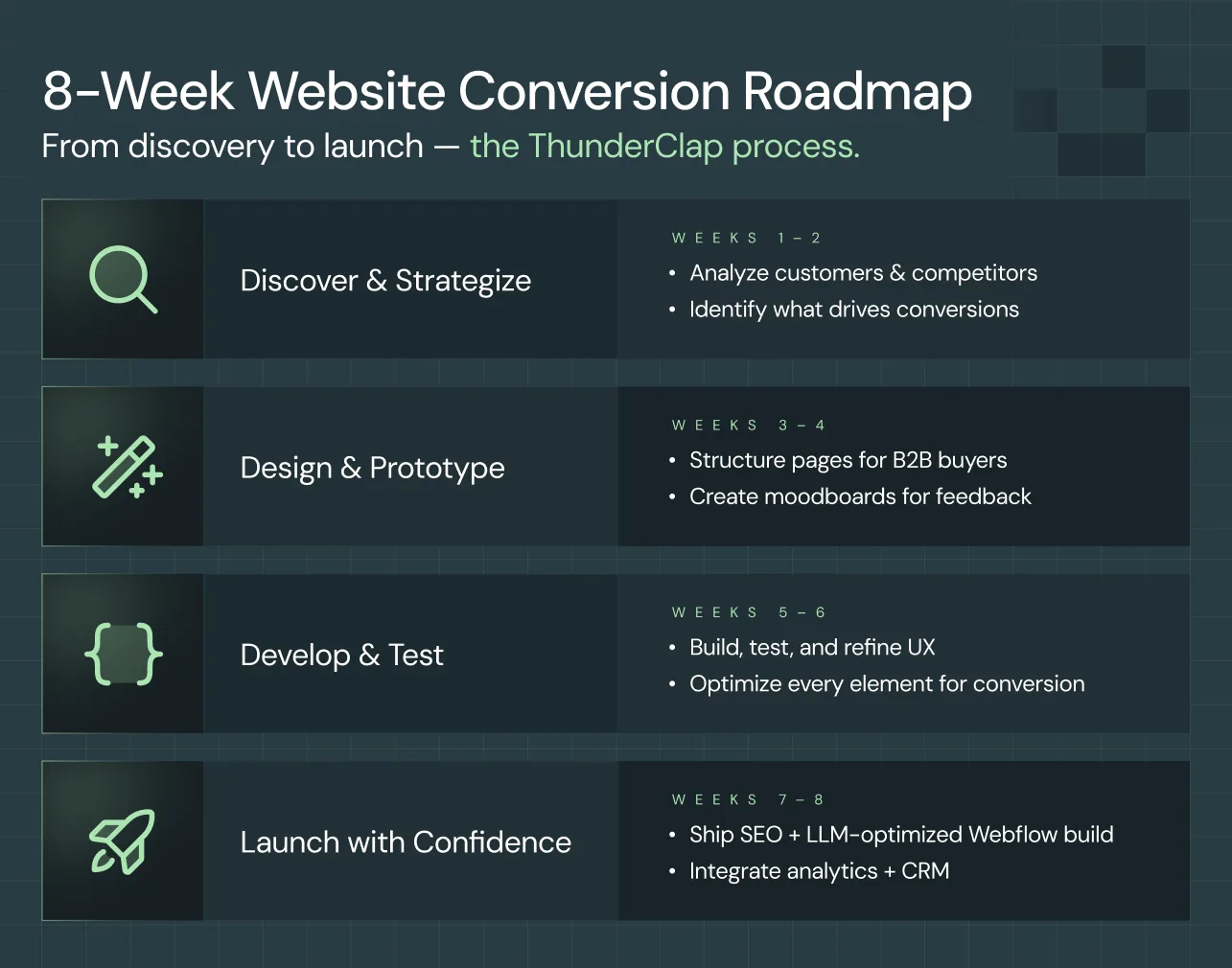
- Discover & Strategize (weeks one to two): We analyze top customers, review competitors’ sites, interview your sales team, and learn what drives conversions in your market.
- Design & Prototype (weeks three to four): We structure content flow the way B2B buyers actually research, develop messaging that speaks across stakeholders, and offer moodboards for feedback.
- Develop & Test (weeks five to six): Every element serves the question: will this feature move prospects further? We test interaction, validate performance, and refine conversion logic.
- Launch with Confidence (weeks seven to eight): We deliver SEO and LLM‑optimized Webflow builds, fast-loading pages, and integration with your CRM. Some clients break into top search rankings within weeks of launch.
As Anand Vatsya, Marketing & Outbound at Storylane, says, “The ThunderClap team is responsive, meets deadlines, and goes beyond expectations - it's a solid partner for any B2B company looking to scale their brand."
Best for: B2B SaaS, fintech, venture capital, and AI companies with $5M or more in ARR who want to scale into new markets or reposition themselves as category leaders.
Proof in the portfolio: ThunderClap’s experience covers SaaS, fintech, and AI industries alongside consulting, commerce, and B2B services. Our clients include Amazon, Razorpay, Storylane, Factors, Skyroot, Rezolv, Shopline, Z47, and Deductive AI. Many of these companies have seen conversion rates improve by up to 50% and engagement grow by 60% after launching their new sites with us.
Also read: Top 10 B2B Branding Agencies in India in 2025
2. Triple Dart
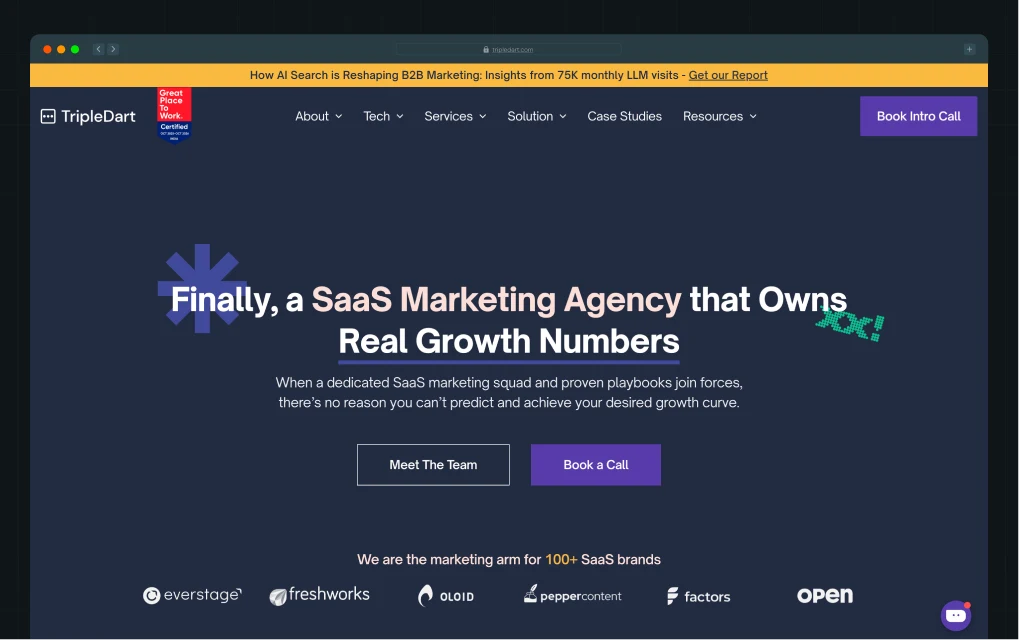
Triple Dart focuses exclusively on helping SaaS and high-growth technology companies build strong brands that attract and retain customers. Their approach combines brand strategy with growth marketing to create brands that look professional and actively support pipeline growth.
Headquartered in India, with a presence in North America and Europe, TripleDart partners with B2B companies across the globe to drive measurable marketing outcomes. The team combines performance marketing, content strategy, SEO, paid media, and CRO into a single, data-backed engine built for scale. Instead of offering standard solutions, they tailor every campaign to match the company’s sales goals and market maturity.
Best for: SaaS startups, technology firms focused on growth, and companies looking to build clear, compelling brands that support marketing goals
Proof in the portfolio: Triple Dart has worked with notable clients such as Blume Ventures, Accel Partners, and Surge.
3. Straight North
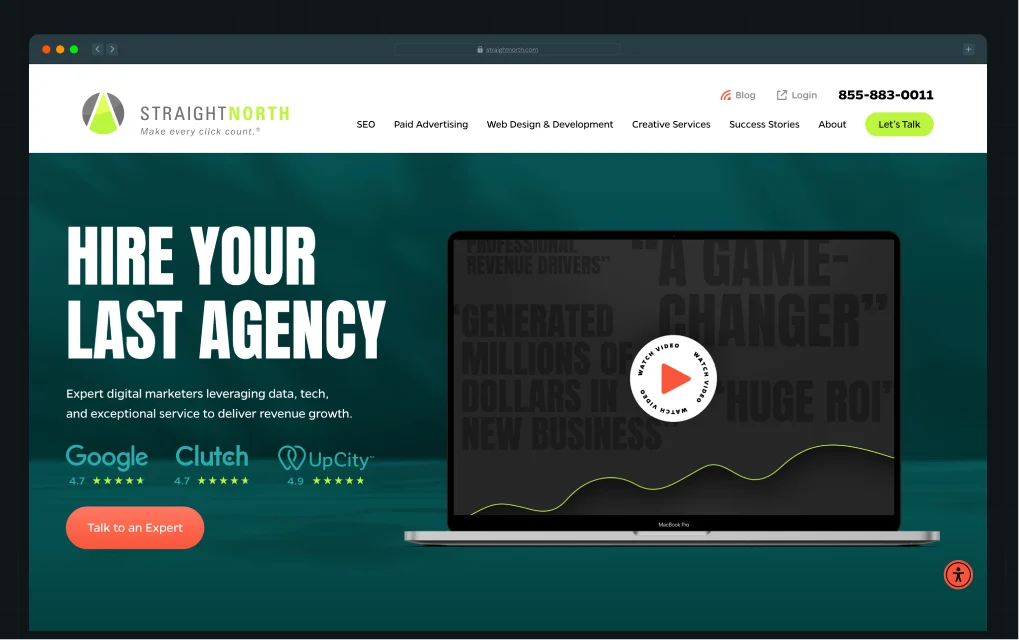
Straight North focuses on building long-term growth for B2B companies through focused SEO campaigns that drive qualified organic traffic and genuine leads. With over 20+ years of experience in the B2B SEO space, they understand the complexity of B2B sales cycles and structure each campaign to support long-term decision-making processes.
Their team collaborates directly with internal marketing teams to enhance lead quality, improve keyword rankings, and drive more sales-ready traffic from organic search.
Best for: Mid-market and enterprise B2B companies that want to increase qualified leads through SEO and improve organic visibility for high-value keywords
Proof in the portfolio: Straight North boasts a diverse client list, encompassing large companies such as the Chicago Bears, Fiserv, and UPS, alongside smaller businesses and specialized sectors, including the legal industry.
4. Refine Labs

Refine Labs helps B2B SaaS companies shift away from old-school demand capture and instead create a website strategy that reflects how people actually buy. With experience working with over 300 companies, they know how to run paid campaigns that improve digital marketing ROI, paid media performance, and revenue per opportunity.
This B2B marketing agency is headquartered in Austin, Texas, and works with clients across North America and Europe. They help mid-market and enterprise teams rethink their pipeline-building process by focusing on brand awareness, demand creation, and expansion marketing to support full-funnel growth. Their process begins with a full-funnel audit, including a website design audit, to identify gaps in messaging and user flow. From there, they build strategies that drive measurable growth through paid media, content, and customer marketing, all built around how B2B buyers actually make decisions today.
Best for: High-growth B2B SaaS companies with $50M+ ARR that want to fix broken demand engines and drive a qualified pipeline
Proof in the portfolio: Their client list includes myCOI, Firstup, Bonterra, and Vena, with measurable wins in cost savings, deal conversion, and website performance.
Also read: 5 Tips & Best Practices for Maintaining your WebFlow Website
5. Ironpaper
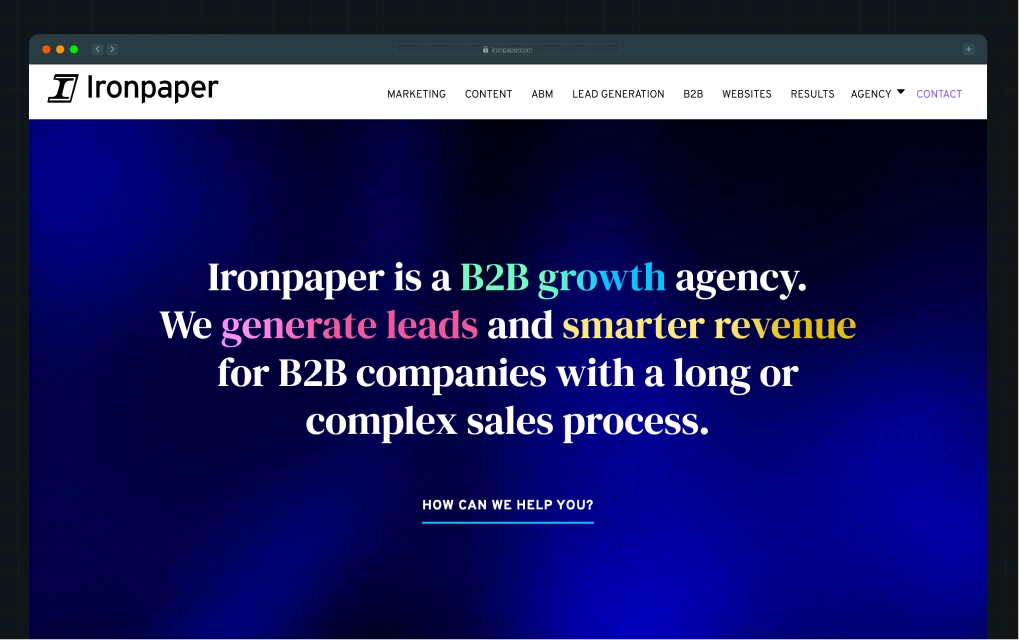
Ironpaper offers a focused suite of services to help B2B companies generate qualified leads and drive measurable growth. Their team executes full-funnel strategies that include digital marketing for B2B companies, account-based marketing (ABM), and demand generation tailored to specific buyer groups.
They develop clear value propositions and optimize conversion paths to improve lead quality and accelerate sales cycles. Ironpaper also builds campaigns using SEO, email, and social to attract the right prospects and support long-term engagement. Their team delivers strong content and messaging, supported by reporting and attribution systems that tie marketing directly to sales outcomes.
Best for: Growth stage B2B SaaS enterprises, tech companies, and firms managing long sales cycles that want a stronger website strategy and improved demand generation while keeping ROI visible
Proof in the portfolio: Ironpaper achieved a 3000% increase in lead generation for a B2B telecom and IoT solution provider and tripled closed deal value for a SaaS IT company through improved messaging and conversion rates. Their client list includes Mobilewalla, Goddard Technologies, PCS Software, Lightning Step, and Ambi Robotics.
Also read: Enterprise Web Design: Best Practices with Examples
6. Directive Consulting
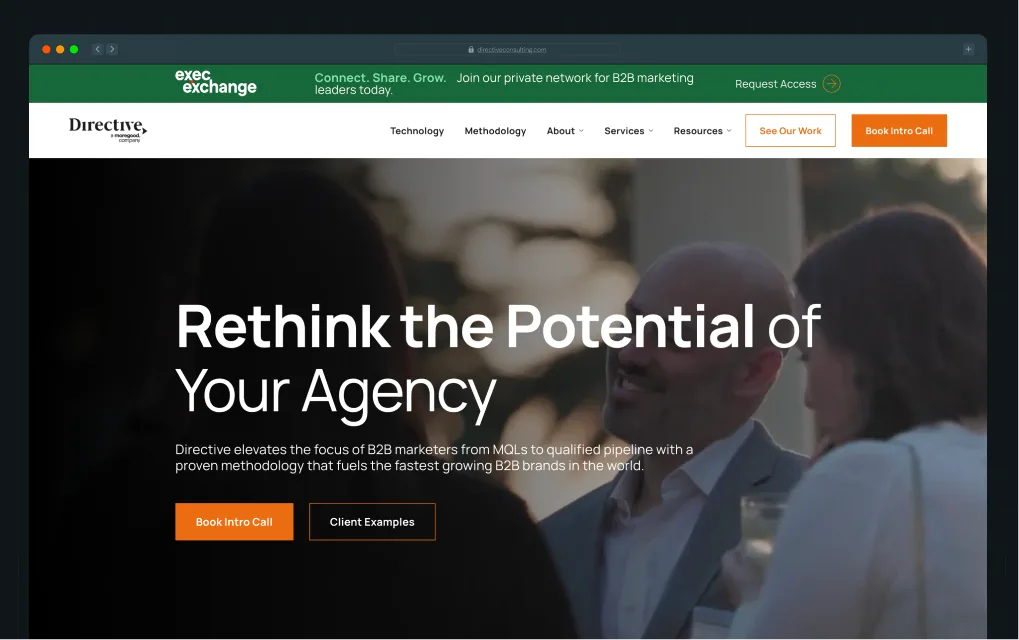
Directive Consulting partners with fast-growing B2B companies seeking to maximize their growth investment. Their proprietary platform, Stratos, empowers B2B marketing teams by combining real-time data, AI-powered insights, and full-funnel visibility into one streamlined system. Stratos pulls from tools like SEMrush, Salesforce, LinkedIn Ads, and HubSpot to uncover performance gaps and fuel sharper decision-making.
With no integration fees or onboarding delays, teams get fast access to campaign benchmarks, predictive signals, and audience intelligence. From ICP discovery to content activation and TAM validation, Directive helps brands reach the right buyers with precision. While AI handles tasks like keyword research and reporting, human strategists stay focused on planning, optimization, and growth.
Best for: B2B companies that care about demand gen and want revenue-first performance marketing that doesn’t waste their budget
Proof in the portfolio: Directive Consulting has worked with many prominent tech and SaaS brands, including Amazon, Dropbox, Cisco, Adobe, Wiz, WordPress VIP, and ServiceChannel.
Also read: 11 Most Asked B2B Brand Strategy Questions Answered
7. Velocity Partners
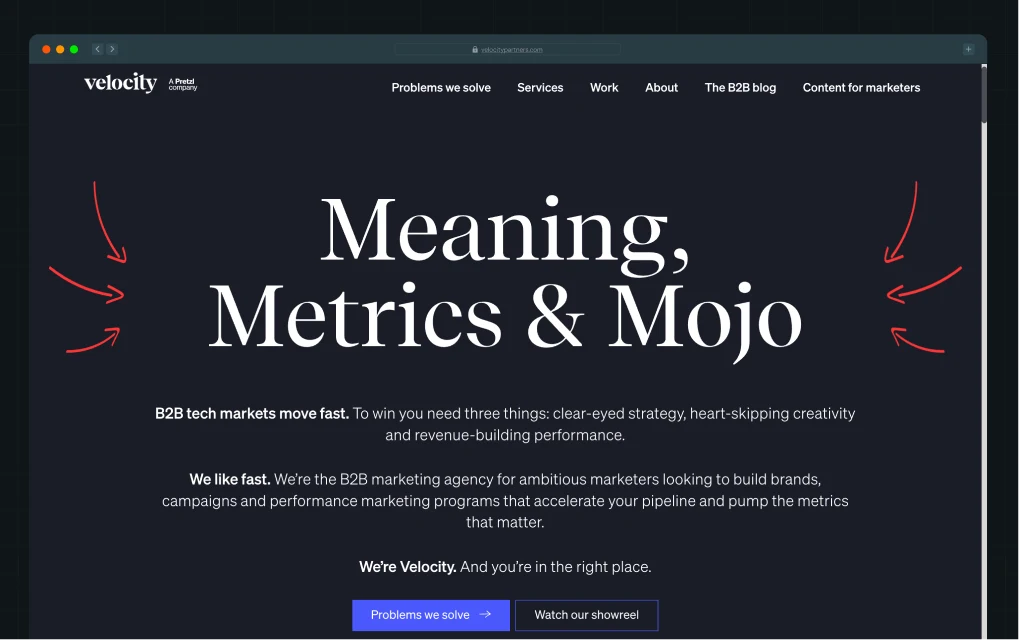
If you need help getting technical buyers to care, hiring Velocity Partners might be the smartest move you make this year. That’s exactly why they rank among the best B2B SaaS marketing agencies for companies with long sales cycles and niche audiences.
From crafting high-impact visual identities to building smart websites and digital experiences, they connect product value to buyer needs. They write content that informs, and they execute campaigns backed by analytics, SEO, and automation tools. Their approach unites strategy, creativity, and accountability to help B2B brands grow with measurable impact. With integrated teams across design, copywriting, development, and campaign management, they deliver work that looks great, sounds sharp, and generates real business results.
Best for: B2B tech companies that need full-funnel storytelling, strong campaign thinking, or enterprise web design support that speaks to real people
Proof in the portfolio: The company has worked with various technology clients, such as Ubiquity, Canfor, InVision, and Clarity CX1.
{{specficService}}
8. Transmission
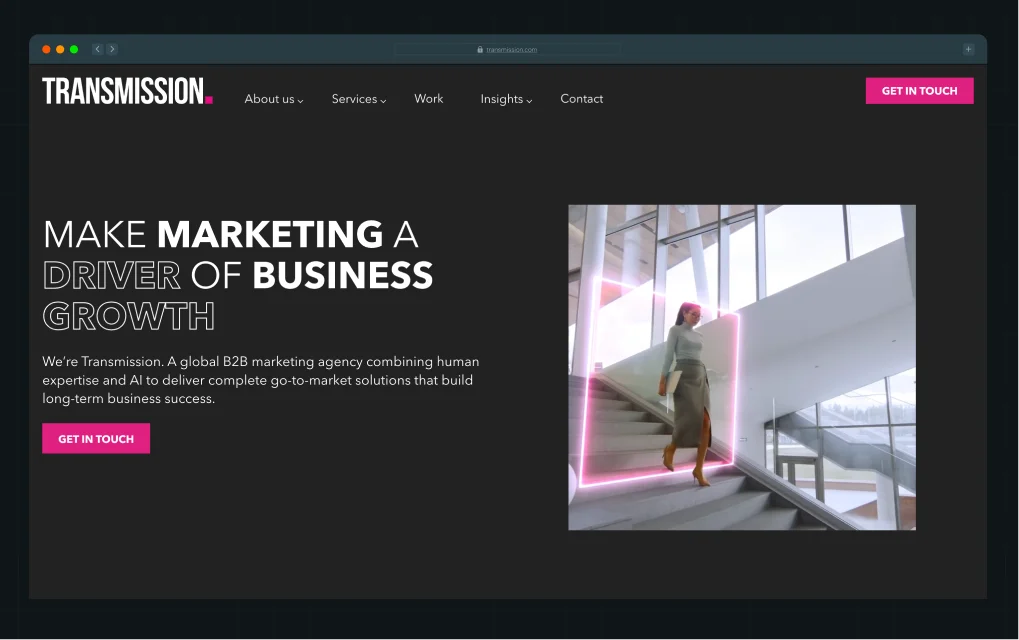
Transmission brings scale, speed, and extensive technical expertise to help B2B companies grow in measurable ways. Their Propulsion OS is the system that enables them to develop smarter campaigns more quickly. That includes content powered by AI, real-time personalization, and data-driven performance across channels.
Additionally, their Dynamic Content Engine enables you to reach buyers early, particularly those who use tools like ChatGPT before completing a demo form.
Best for: Enterprise brands that need go-to-market planning, personalized mid-funnel content that adapts fast
Proof in the portfolio: They’ve supported growth-focused campaigns for Qualcomm, AutoStore, Iron Mountain, Microsoft, and Cloudflare across global regions.
9. MOI Global
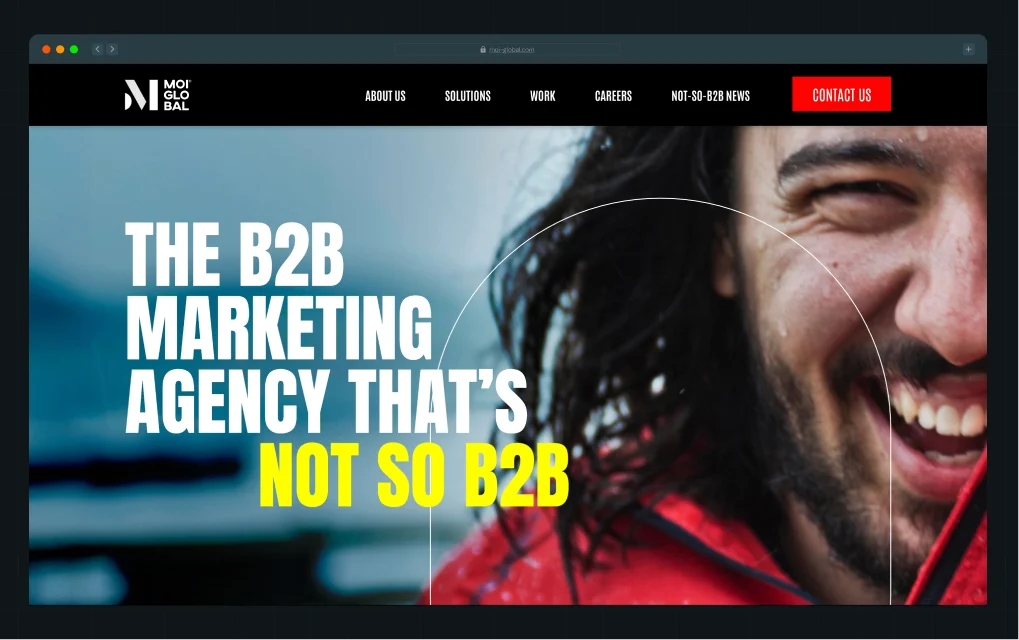
MOI Global helps B2B brands ditch dry campaigns and actually build marketing that feels human and works hard. With full-service capabilities spanning creative, consulting, research, and media, they develop programs that integrate brand, demand, and experience into a unified revenue engine.
They create highly relevant, intelligence-led customer journeys, while revenue solutions align marketing activities to serve one intelligent view of the customer. Through their Turning Heads™ collaborative approach, MOI Global works closely with clients to build standout brands and demand initiatives that connect with buyers and grow businesses.
Best for: B2B marketers who want performance without losing personality, plus creative campaigns to match
Proof in the portfolio: Some of the notable companies that MOI Global has worked with include Adobe, Dropbox, Facebook (Meta), Google Cloud, Oracle, and ServiceNow.
10. Cleverly
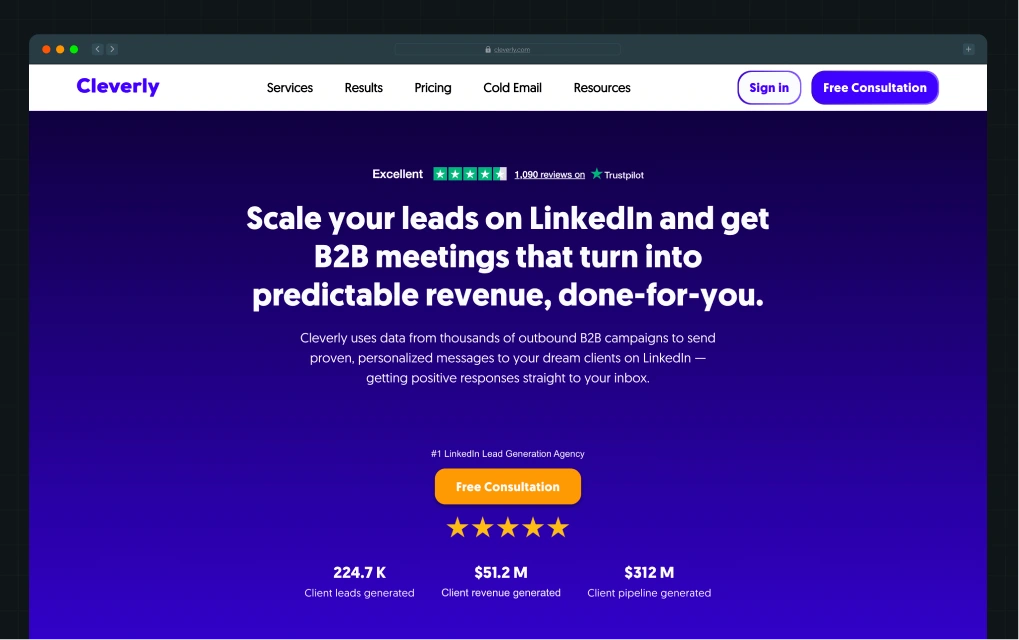
Cleverly helps you turn your LinkedIn presence into a lead machine without lifting a finger every day. Their team runs thousands of tested outbound campaigns, then uses that data to build high-performing outreach for B2B brands who want to book more meetings with zero manual effort.
Their services include LinkedIn lead generation, profile optimization, inbox management, and full-funnel appointment setting, making them one of the most efficient top B2B marketing agencies for outbound.
Best for: Founders, consultants, and sales teams seeking smarter outbound campaigns that drive real B2B revenue
Proof in the portfolio: Cleverly has teamed up with a diverse range of clients, especially in tech and software startups, consulting, finance, and small businesses. Some of the names you might recognize are Productiv, Canva, Stripe, Webflow, and even the Google Ads pros at Yael Consulting.
Build a B2B Brand That Sells Before Your Team Even Speaks
You’ve just seen what the top B2B marketing agencies do to help companies grow faster, sell better, and stand out in crowded markets. The next move is yours.
At ThunderClap, we turn B2B websites into growth engines that speak to your next customer before your sales team ever does. As a Webflow Enterprise Partner, here’s why we should be on your radar:
- Deep expertise in complex B2B journeys → We design websites that anticipate multi-stakeholder decisions, providing clear paths that shorten sales cycles and build trust early.
- Outcome-driven design approach → Every pixel and interaction is optimized to boost engagement, reduce friction, and increase qualified leads, proven by measurable uplifts across industries.
- Conversion-first process → We engineer websites that drive measurable business outcomes, boosting demo signups, MQLs, and pipeline growth. Our clients have seen up to a 50% lift in conversions and a 60% increase in user engagement.
- Future-proof technology stack → Powered by Webflow and an easy-to-manage CMS, your site adapts and grows smoothly as your marketing and product evolve.
- Holistic growth → Beyond design, we align your website with SEO, speed, messaging, and go-to-market goals, so your site is a true business asset, not just a digital presence.
{{ctaBlock}}
FAQs
What is a B2B marketing agency?
B2B marketing agencies help businesses reach other businesses with targeted marketing strategies designed to generate leads and grow revenue. Agencies like ThunderClap combine research, brand design, and digital marketing to build strong B2B brands that attract qualified prospects and support predictable sales growth.
How to choose the best B2B marketing agency?
Look for a B2B marketing agency that understands your industry, offers clear results, and manages all marketing stages from strategy to execution. ThunderClap, for example, has experience revamping over 129 B2B websites and launching 140+ across SaaS, fintech, and AI, helping clients increase conversions by up to 50%.
What are the things to be considered while choosing the best B2B marketing agencies?
Consider their experience in your field, ability to show real results, and the services they provide. You want an agency that handles everything from research to ongoing optimization. ThunderClap stands out by offering growth-focused design trusted by Amazon, Razorpay, and others, which shows their commitment to measurable success.
How do B2B marketing agencies use technology to improve results?
B2B marketing agencies leverage marketing automation, data analytics, and AI tools to create personalized campaigns that reach the right audience at the right time. These technologies help optimize messaging, track campaign performance in real-time, and adjust strategies quickly.
Why do B2B marketing agencies matter for business growth?
B2B marketing agencies bring specialized knowledge and resources that help businesses target the right decision-makers effectively. They use data and proven marketing tactics to generate qualified leads, shorten sales cycles, and increase revenue.

Driving AI Visibility in Search with Smart LLM Optimization
Over 2.5 billion prompts are sent to ChatGPT every single day now. That number indicates people no longer just “Google it,” but instead ask AI, receive instant answers, and move on. This change presents a significant challenge for your brand, as your content might rank well on Google but still be ignored by LLMs like ChatGPT, Gemini, and Perplexity.
That means all the time and effort you put into SEO could end up invisible to the tools your audience now uses. If you’ve noticed fewer leads, weaker traffic, or less engagement lately, it might not be your site design or ads. It’s more likely that your content is optimized for search bots, while your audience is interacting with AI.
At ThunderClap, we’ve rebuilt over 129 B2B websites for SaaS, fintech, and enterprise tech clients, including Amazon, Storylane, Factors, Deductive AI, and Razorpay. More so, we build sites that convert and are recognized by AI.
In this guide, you’ll discover our smart LLM optimization framework (SLOF), a clear, five‑step system to help your content appear inside generative answers where your audience now lives.
What is generative engine optimization (GEO)?
Before we explore examples you can apply, let’s define what generative engine optimization (GEO) is and how it differs from traditional SEO. GEO is the process of optimizing your content so that large language models can find, trust, and cite it in their generated answers. You design with AI in mind, not just traditional search indexers.
In traditional SEO, you optimize content for crawlers, backlinks, and ranking signals from search engines. But those tactics don’t reliably translate into AI visibility. With GEO, you must think about how models retrieve, summarize, and attribute content.
A new research paper indicates that AI search systems exhibit a systematic and overwhelming bias towards earned media (third-party, authoritative sources) over brand-owned and social content, which contrasts starkly with Google's more balanced approach. The study also shows that different AI search systems don’t all work the same way. They vary a lot in how many different sources they use, how up-to-date their info is, how well they handle other languages, and the importance of phrasing.
To succeed with GEO, you must master three modern pillars of AI search.

{{specficBlog}}
The smart LLM optimization framework (SLOF)
With AI changing the game, your content must appear within the AI-generated answers your audience is reading. That’s where our smart LLM optimization framework, or SLOF, comes in.
We built this five-stage LLM optimization framework (SLOF) to help you get your brand noticed by AI and make sure your content gets the credit it deserves. Here’s a quick snapshot of how SLOF works from start to finish:

Now let’s discuss each stage in detail.
SLOF stage #1: Surface: Make content discoverable
Your first job is to make your content retrievable by generative engines. If an LLM can’t reach or index your page, none of the other stages matter. You want every URL you care about to be visible to tools like ChatGPT browsing, Perplexity, or Bing Copilot.
Start with a website audit. Verify whether existing pages are accessible to AI tools. Use Screaming Frog or a similar crawler to simulate how AI bots might view your site. Identify URLs blocked by robots.txt, inaccessible by crawlers, or missing standard indexing tags.
Next, add schema markup to key pages. You can use FAQ, HowTo, Product, or Article schema types to give structured clarity. Those schemas help models understand the purpose, structure, and relationships in your content. Pair schema with JSON‑LD and OpenGraph metadata. These contextual tags inform the model about the page's content, author, date, and intended use.
Here’s your to-do for Surface:
- All key URLs are crawlable by AI tools
- Proper meta tags and OpenGraph / JSON‑LD metadata present
- FAQ or HowTo schema added where relevant
- A 150‑word factual summary embedded on important pages
SLOF stage #2: Structure: Speak the model’s language
Once your content is discoverable, the next step is to make it understandable. Think of this as training LLMs to read your site fluently. A model doesn’t “see” your design or colors, but it understands relationships, entities, and clarity. Your job is to make that structure crystal clear.
Start by writing in semantically rich and unambiguous sentences. Use full company names, product names, definitions of key terms, and precise attributes. Avoid pronouns or vague references that an LLM might misinterpret. Every concept deserves its own precise definition inside a paragraph.
Next, build topic clusters. Internal links between related pages help models recognize which subjects you own. If your blog covers AI strategy, connect articles about machine learning, automation, and data analytics under that hub. This tells LLMs that you are an authority within a structured knowledge domain.
At ThunderClap, we call this the E³ method:
- Explicit: Be clear in the statement
- Entity‑linked: Use named entities and definitions
- Easily summarized: Keep each section compact, with clean headings
A recent client, ClearlyRated, asked us to help with a website redesign. But instead of jumping into colors and layouts, we worked with their sales, product, and marketing teams to reframe the structure of their messaging.

We helped them clarify what matters most to their customers and how their solutions should be explained. This involved restructuring pages with clear entity definitions, concise explanations, and logical flows. As a result, we created a B2B web design that works as hard as their inbound engine, structured not only for humans but also for LLMs.
SLOF stage #3: Signal: Build AI‑recognizable authority
Now that your content is structured clearly, it’s time to teach models why they should trust it. In AI-driven search, credibility is based on statistical data. Models rely on patterns of authority, consistency, and transparency to decide which brands to quote. That’s where our Signal strategy comes in.
That starts with consistency across your content ecosystem. Publish fact-based, citation-rich pages that are easy to extract from and rich with source signals. Get your name referenced on other trusted platforms, whether through guest articles, industry reports, or collaborative content. Create detailed author pages with real names, bios, and a trail of bylined contributions.
Internally, keep your language tight. Use the same terminology, entity structure, and phrasing throughout your site and beyond. LLMs are trained to associate repeated words and phrases with expertise, so internal consistency helps them categorize you correctly.
{{specficService}}
We use the A-C-T model for signal creation:
- A: Authority (backlinks, citations)
- C: Consistency (language, entities, branding)
- T: Transparency (authorship, verifiable data)
A strong example is Storylane. Their team doesn’t just rely on one channel. Across LinkedIn, they regularly post product updates, customer results, and behind-the-scenes insights. These employee-led efforts strengthen how AI engines associate their brand with interactive demo creation.

And their recent website revamp with us shows what happens when design principles and structured messaging come together across touchpoints.
Check out the full breakdown in this LinkedIn post by Kiran Kulkarni, Partner and Head of Growth at ThunderClap, where she shares the detailed design process and before-and-after results.
When you treat external and internal publishing as a unified B2B website optimization strategy, you provide models with a reliable, trust-rich signal. That’s how you go from being readable to being referenced.
SLOF stage #4: Summarize: Optimize for AI answers
At this point, your content is visible, structured, and credible. Now, you want to make it quotable. Large language models pull short, self-contained snippets that directly answer user questions. So, your goal is to give them exactly that.
Craft “AI‑ready snippets” of 40–80 words that directly answer common user queries. Put those early in your content, so LLMs see them first. In those snippets, include key definitions, stats, or steps.
Design dedicated Q&A sections for each page using headings like “What is … ?”, “How does … work?”, or “Why does … matter?” Those patterns trigger generative engines to pick up those blocks. Use numbered steps or lists within the text for clarity.
Use the S.A.I.D. format in mini sections:
- State: Pose the question
- Answer: Answer directly
- Illustrate: Show a quick example
- Document: Cite a source or link
Each mini-section provides the model with an atomic, self-contained answer that it can reuse. If you do this well, your content becomes prime fodder for AI citations.
When readers or AI see you clearly answering questions with a clean structure, you raise your chances of selection in generative outputs.
Also read: Best Conversion Rate Optimization Companies in the US in 2025
SLOF stage #5: Score: Measure and iterate visibility
Finally, every smart framework needs measurement. Once you’ve applied the first four stages, you must track where and how often your brand appears within generative search results. This last step turns experimentation into long-term performance.
Monitor how often your brand or content is cited in Perplexity, ChatGPT, Gemini, or Copilot. Use tools like BrightEdge AI Catalyst or its generative visibility features to monitor your online presence across AI search engines. Some brands already use BrightEdge to track AI presence in real time. Maintain a manual “LLM citation log” where you record citations, model sources, and query contexts every week.
Next, evaluate three core metrics:
- Exposure: How often does your brand appear in AI-generated answers?
- Attribution: Are your URLs or company names being cited correctly?
- Trust: Do the AI outputs accurately reflect your published content?
We call this the GEO KPI pyramid: Exposure → Attribution → Trust → Traffic
Use those signals to iterate. If you see low attribution, focus more on Stage 3 (Signal). If you appear but rarely get traffic, optimize summaries and link pathways further.
Also read: SaaS Website Design That Converts: 7 Must-Have Elements to Win More Signups
Common pitfalls and optimization mistakes to avoid
Even with the best intentions, brands often encounter avoidable issues that keep them invisible to generative engines. Here are five of the most common mistakes we see, and how you can fix them with our expertise:
- Over-optimizing for keywords: Stuffing paragraphs with exact-match terms might fool basic crawlers, but it just confuses large language models. LLMs want clean, clear writing with a natural tone, complete thoughts, and context that leaves no doubt.
- Ignoring structured data: If your site lacks schema markup, JSON-LD, or OpenGraph data, models can’t correctly retrieve or categorize your content. That’s why we always include full structured data implementation during every website design audit, as it directly impacts generative discoverability.
- Forgetting author transparency: LLMs struggle to trust content that lacks a real person behind it. No author bios or credentials? You lose credibility and ranking potential. We address this by integrating custom author sections into every B2B website we optimize, enabling AI to link the topic to the human expert.
- No factual backing: Pages full of vague claims rarely get summarized or cited by LLMs. Adding stats, dates, and original data isn’t optional, but necessary for appearing in AI-generated answers. For example, when we revamped roommaster’s website, making the content fact-dense and easy to reference was a top priority, which in turn boosted trust with AI models.
Using unclear brand naming: If your brand name changes across pages or sounds too generic, AI models can’t link your insights back to you. To avoid this, keep your phrasing consistent, strengthen your expertise across every touchpoint, and double-check every key page against the E³ checklist: Explicit, Entity-linked, Easily summarized.
The future of AI search optimization
Search is evolving fast, and what worked a year ago is already falling short inside generative engines. With large language models like ChatGPT, Gemini, and Perplexity moving toward real-time retrieval using RAG (retrieval-augmented generation), we’re stepping into a new era.
What’s next is something bigger than GEO optimization. We call it AIO, or AI information optimization. Instead of writing just for rankings, teams will create content designed for structured understanding, trust-building, and real-time AI recall.
Here’s what that future looks like:
- Real-time retrieval: Generative engines will source live facts, stats, and examples, not just cached web pages.
- Structured data wins: Pages built with schema, summaries, and clear metadata will surface faster and more often.
- Verifiable sources matter: Brands that link to original data, cite expert authors, and publish factual content gain long-term visibility.
- Trust signals compound: LLMs prefer domains they have seen before with consistent terminology and strong credibility indicators.
Brands that apply this shift early will earn model-level authority. That means your content starts showing up by default within answers, summaries, and voice-based results across platforms.
Also read: 20 Proven SaaS Conversion Optimization Hacks to Boost Your Sales
Quick checklist: Apply the SLOF framework to every page
You’ve just walked through all five stages of the smart LLM optimization framework. But knowing what to do is one thing. Actually putting it into action, across dozens of live pages, is where most teams get stuck.
That’s why we created this simple SLOF checklist. It’s the same framework we use to drive visibility for B2B brands.
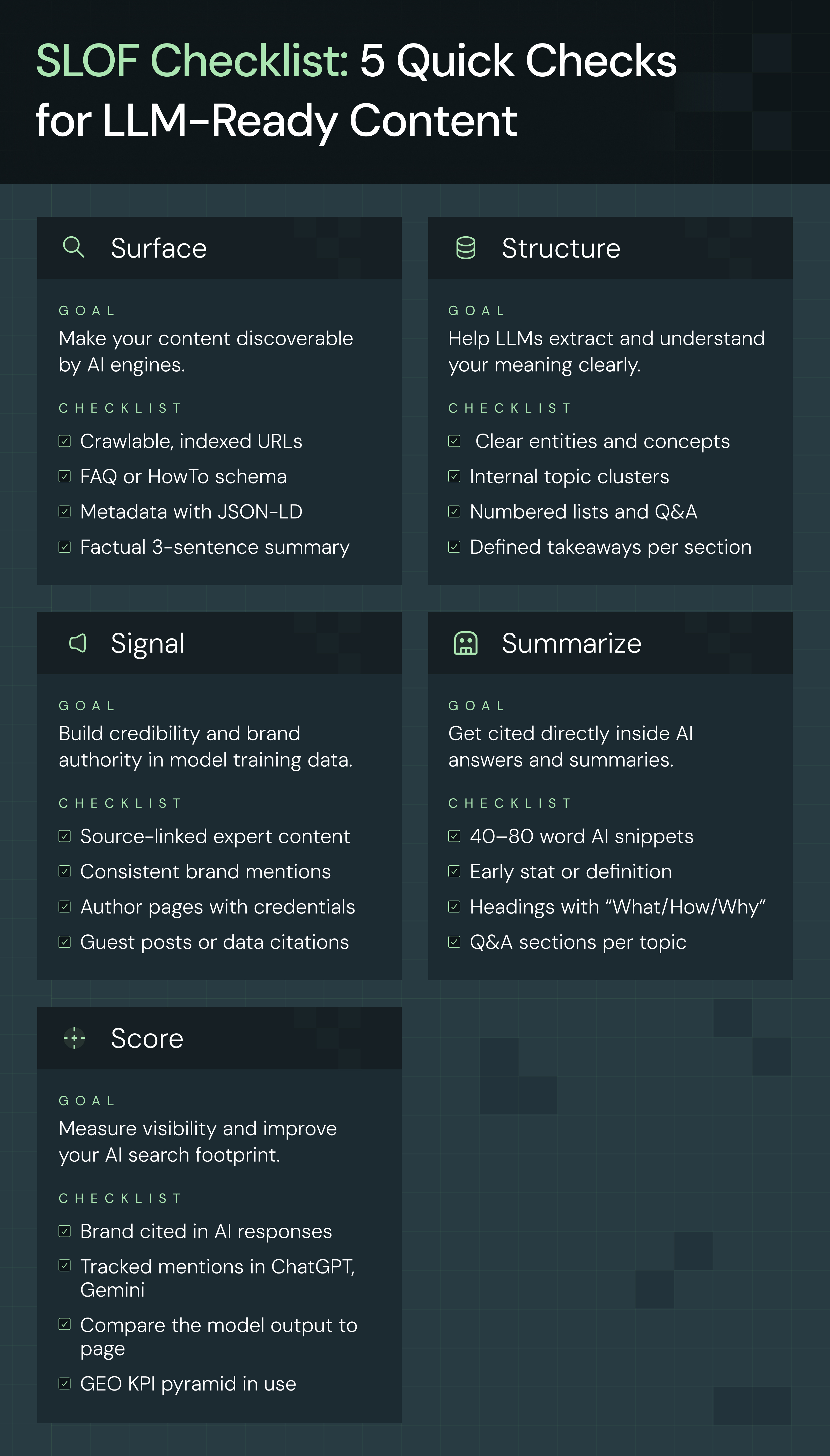
And if you want the full details, here’s the step-by-step breakdown of each element:
Surface
Audit URLs for AI indexing and browsing
- Add schema markup (FAQ, HowTo, Product, Article)
- Use JSON-LD and OpenGraph metadata
- Write concise 3-sentence factual summaries
- Ensure proper meta tags and crawlable URLs
Structure
- Write clear, semantic sentences with full names and definitions
- Organize content using topic clusters and internal links
- Use numbered lists, tables, and Q&A formats
- Apply the E³ method: Explicit, Entity-linked, Easily summarized
Signal
- Publish fact-rich, source-linked content regularly
- Gain backlinks and external citations with consistent branding
- Create author pages with verifiable credentials
- Follow the A-C-T model: Authority, Consistency, Transparency
Summarize
- Write AI-ready snippets of 40-80 words answering user queries
- Highlight key stats, definitions, and steps early
- Add dedicated Q&A sections with semantic headings
- Use the S.A.I.D. format: State, Answer, Illustrate, Document
Score
- Track AI citations on ChatGPT, Perplexity, Gemini, and Copilot
- Use BrightEdge Generative Visibility or manual citation logs
- Monitor mentions, attribution, accuracy, and AI-driven traffic
- Follow the GEO KPI pyramid: Exposure, Attribution, Trust, Traffic
Most B2B web design agencies are still uncertain about AI visibility, but ThunderClap uses SLOF to deliver tangible pipeline impact.
The next visibility battle starts with the right website strategy
Ranking on Google no longer guarantees attention. If large language models like ChatGPT or Perplexity can't find or trust your content, your brand is likely to be skipped. That’s why LLM optimization is no longer optional. It gives you a clear advantage in how people discover and engage with your expertise.
The SLOF framework makes this shift practical. It helps you write, structure, and present content in a way that models can read, summarize, and cite with confidence. At The ThunderClap, we use the same system when building high-conversion websites for fast-growing SaaS, fintech, and AI companies.
Here’s what sets us apart:
- Proven AI and SaaS expertise → We’ve revamped 140+ B2B websites and turned them into conversion engines.
- Practical, conversion-focused approach → We don’t just tweak content, we create conversion architectures that get your brand featured in AI-generated answers and drive measurable results.
- Scalable, hands-on execution → From Webflow builds marketers can own to playbooks your team can iterate on, we build for growth and ease of use.
Plenty of agencies can help you get clicks. We help your brand get seen and trusted in the AI era.
{{ctaBlock}}
FAQS
1. What is LLM optimization in the context of search?
LLM Optimization is the process of shaping your content so that large language models (LLMs), such as ChatGPT, Gemini, or Perplexity, can accurately interpret and reuse it when generating answers. This means using clean, factual language, clearly defining entities, and formatting pages to resemble structured datasets (with headings, tables, FAQs, and a logical flow). Essentially, generative engine optimization (GEO optimization) is SEO for models, not crawlers: you’re making your content the easiest for an LLM to read, trust, and cite.
2. Why is LLM optimization important for SEO today?
Because search behavior has shifted, people now ask AI assistants instead of using search engines. When users query ChatGPT or Gemini, the AI generates a single synthesized answer, often pulling from sources it finds most readable and credible. If your site isn’t optimized for this new environment through LLM SEO optimization techniques like clear context blocks, factual accuracy, and consistent entity naming, you simply won’t appear in those answers.
In 2025, generative engine optimization isn’t optional; it’s how brands earn visibility inside the AI summaries that users increasingly trust over traditional search results.
3. Is there a way to measure the effectiveness of LLM optimization?
Yes, and while traditional rankings don’t exist for AI engines, there are emerging ways to gauge GEO optimization success. Start by manually checking whether your content is cited or referenced in tools like ChatGPT (browsing mode), Gemini, or Perplexity. Even a mention signals that your structure is model-friendly.
You can also monitor AI-driven referral traffic or branded mentions in generative responses, using platforms like BrightEdge’s Generative Visibility or Authoritas GEO dashboards. True LLM SEO optimization performance shows up when models start pulling your phrasing, stats, or examples, proof that your content has become embedded in the AI’s trusted knowledge layer.
4. How does LLM optimization differ from traditional SEO?
While traditional SEO is about ranking on search engines, LLM optimization is about being cited by AI systems. In SEO, you target keywords and backlinks, but in Generative Engine Optimization (GEO), you focus on factual clarity, semantic richness, and structured logic. Instead of optimizing for click-throughs, you’re optimizing for interpretability, making sure models understand what you mean and attribute it correctly.
In short, LLM SEO optimization doesn’t replace classic SEO, but it extends it. You still need visibility on Google, but you also need to make sure AI assistants can read, reason about, and reuse your content accurately.

12 Best B2B Web Development Agencies in the US to Build Scalable Websites
People form opinions faster than they realize. Within just seven seconds, someone decides what they think about you, and that instant judgment often shapes everything that follows. The same goes for your website, as it works like your brand’s digital face, speaking volumes before a single word is read.
A great website keeps visitors engaged and drives conversions, while a bad one sends them packing. Sounds simple, but anyone who’s tried building a site that actually works knows it’s not.
But we get it, finding that perfect partner is rarely easy. Between vague promises, fancy jargon, and endless portfolios, choosing the right agency can feel like a full-time job. The good news is, we’ve done the hard part for you. This guide brings together the best web development agencies that have a proven record of designing scalable, conversion-driven websites.
What to look for in the best web development services?
Pretty mockups are easy to fake, but a solid process is what sets the professionals apart. You’re not hiring them to build a website that just looks great. You need something that works, converts, and grows with your business.
The Double Diamond Design Thinking model is one of the clearest ways to figure out whether an agency knows what it's doing or just winging it. Originally developed by the British Design Council, the Double Diamond design process is a structured approach to problem-solving and design, widely used in web development and UX design.

Here’s how the top web development agencies (including us) apply this framework:
Discover
Before writing a single line of code, top agencies start by asking the right questions. They dig into your analytics, research your competitors, and learn how your users behave. Here’s the kind of questions we'll ask during the discovery phase:
- What are your top business goals, and how do you expect your website to support them?
- Where are users currently dropping off, and what parts of the site are underperforming?
- Who are your target users, and how do they currently interact with your product or service?
- What feedback have you received from customers about the current website experience?
- What do you like or dislike about competitor websites in your space?
- Are there specific pages or features that absolutely need to be kept, removed, or rebuilt from scratch?
We use this phase to collect real data instead of guessing what looks good. You should also expect them to bring up tools like Hotjar, GA4, Google Search Console (GSC), and Clarity to find out what's working and what's not.
Define
Once the research is done, our team moves on to identifying the real problems your site is facing. This could be weak calls to action, poor mobile usability, or unclear messaging. Serious agencies don’t move ahead until they’ve mapped out a straightforward website strategy based on facts, not assumptions.
In this step, goals such as a B2B website growth strategy or improved site speed are actually built into the plan.
Develop
You’re not just getting visuals here. During this step, we start wireframing and prototyping based on the problems they uncovered. Every idea is filtered through performance thinking, from B2B web design to layout decisions, as they build conversion rate optimization (CRO) into the process from the start.
Deliver
Once the site is designed, tested, and approved, we move into development and launch. We build with clean code, set up CMS tools that are easy to use, and test every detail on mobile devices, desktops, and tablets.
However, we don’t stop there. The top web development agencies also provide post-launch support, which includes updates, performance checks, and regular website design audits to track what’s working.
In-house vs outsourcing website development: Why your business needs an agency?
At first glance, hiring a few developers in-house might seem like a straightforward solution. But when you break down what it really takes to build a performance-driven site, the choice becomes clearer. The top web development agencies bring speed, skill, and flexibility that’s nearly impossible to match with an internal team.
For B2B businesses, particularly, the website is a critical piece of the go-to-market engine. Whether you are launching new campaigns, updating product messaging, or optimizing for SEO and paid performance, the site needs to evolve constantly. And when your GTM team is driving fast-paced initiatives like product launches, events, or PR pushes, you can't afford delays. You need a partner that moves fast, adapts quickly, and doesn't slow your momentum.
From complete builds to a website revamp, here’s why outsourcing wins.
- Lower long-term costs: Agencies give you access to specialists without locking you into ongoing salaries and overhead. You only pay for what you need, when you need it, and you get an entire expert crew ready to go.
- Faster, parallel workflows: While internal teams often follow a linear process, agencies work on multiple parts at once. That means design, copy, and development move forward together, rather than waiting on each other.
- Wider technical expertise: Agencies bring years of cross-industry experience and know what works across platforms and tools. Their background helps you avoid common mistakes and launch stronger from the start.
Flexible team support: Once the core work is complete, you can scale back or pause until new needs arise. You stay in control without losing access to expert help.
{{specficBlog}}
12 best web development services companies
After thorough research on over a dozen web development companies, we selected the best based on their approach to website strategy and proven results. These 12 companies stand out as top choices to build websites that perform strongly in 2025.
1. ThunderClap

ThunderClap ranks among the best B2B web development agencies in the USA and has collaborated with over 88 fast-growing companies worldwide, including Storylane, Factors, Amazon, and Razorpay. As a Webflow partner, we specialize in creating Webflow websites that not only look stunning but also rank well and drive strong conversions.
Our team handles everything from web design and copywriting to SEO and CRO, focusing on building websites that match the growth and vision of SaaS, fintech, and AI companies. Many clients come to us with outdated or template sites, and we transform those into powerful sales tools through our conversion-first, Webflow-driven process.
With more than 140+ websites launched and 129+ B2B website revamps completed, we combine strategic audits, clear messaging, and precise execution to deliver results. We also provide 30 days of free support after launch to make sure your site performs as promised. Additionally, we have received recognition through awards such as the Webby and CSS Designer Awards.
Core services:
- Webflow development with Figma-to-Webflow workflows, CMS, enterprise-scale builds, migrations, and custom integrations
- Conversion architecture focusing on UX audits, optimized CTAs, and increasing demo signups
- Positioning and messaging strategy that turns brand stories into credibility assets
- Scalable, marketer-owned CMS systems that are easy to update and future-proof
- Ongoing support with detailed handover documents so clients can use the CMS in a simplified manner
Best for: B2B SaaS, fintech, venture capital, and AI companies with $10M+ ARR scaling into new markets or repositioning as category leaders
Proof in the portfolio: ThunderClap’s deep industry expertise spans SaaS, fintech, and AI alongside consulting, commerce, and B2B services. Our clients, including Amazon, Razorpay, Storylane, Veefin, Factors, Skyroot, CloudTech, Rezolv, Shopline, and Deductive AI, have experienced conversion increases of up to 50% and a 60% growth in engagement.
2. Digital Silk
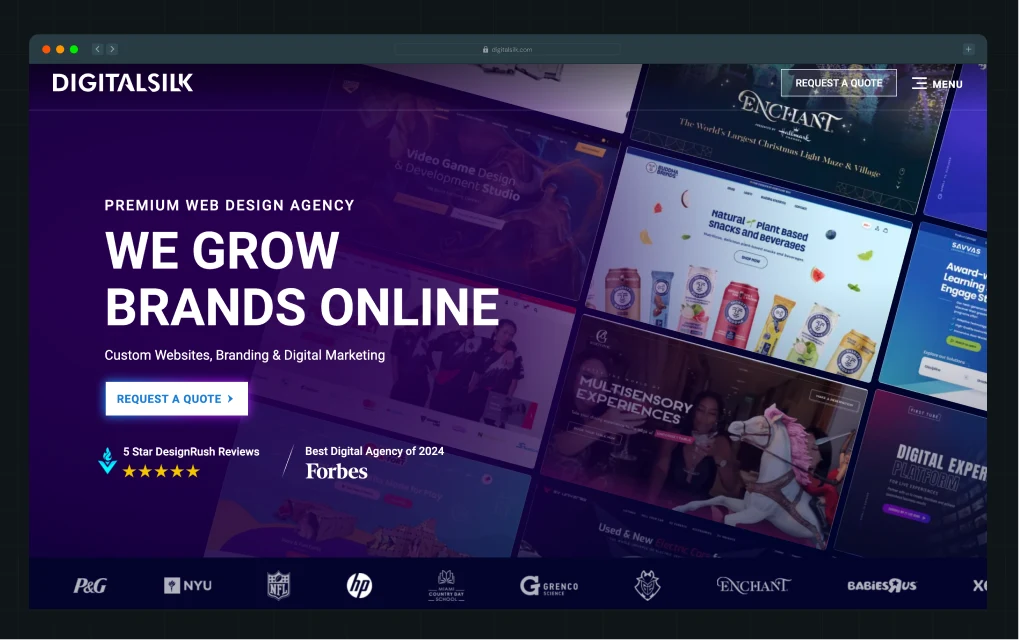
Digital Silk is one of the best web development agencies in New York, specializing in delivering best-in-class digital experiences for mid-size to large B2B companies. By combining cutting-edge design with results-driven marketing campaigns, they help brands achieve superior online performance. Their redesign for FieldEdge delivered a page-speed boost along with a traffic lift.
Recognized as a DesignRush award winner, Digital Silk offers a comprehensive suite of services covering brand strategy, web design, app development, and digital marketing, making it a one-stop solution for B2B companies seeking to revamp their entire digital presence.
Core services:
- Custom UX/UI and responsive website design
- Front-end & CMS development (WordPress, Shopify, Magento)
- eCommerce design & platform scaling
- Brand strategy, identity, and conversion optimization
- QA, launch support, and post-launch optimization
Best for: Mid-market to enterprise brands that need a strategic, full-stack partner to launch conversion-focused web platforms
Proof in the portfolio: Trusted by household and enterprise names like Sony, P&G, IBM, Xerox, NFL, and Babies “R” Us, Digital Silk has demonstrated its ability to deliver impactful digital solutions.
Also read: 5 Best Web Development Outsourcing Companies in 2025
3. Clay
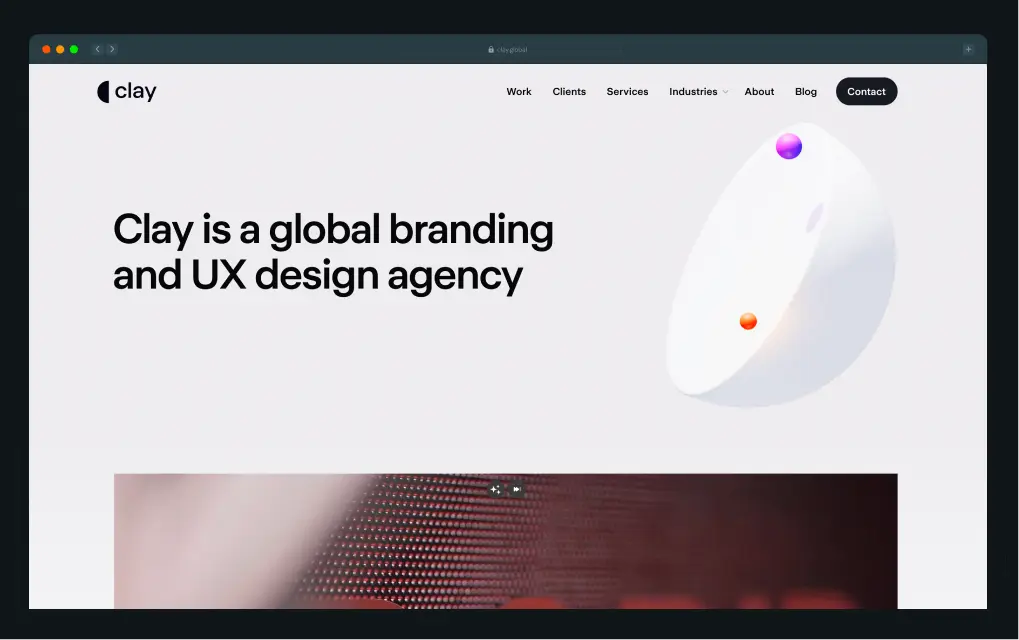
Clay ranks among the best web development agencies in New York, delivering highly functional and visually striking websites that help B2B companies achieve measurable results. The team combines design and technology to create sites that improve user experience, support business objectives, and tackle complex B2B web design challenges with scalable solutions.
Their team handles everything from research and strategy to full-stack development, using modern frameworks and CMS platforms to create sites that perform well across devices and browsers.
Core services:
- Full-stack web development with React, Node.js, and CMS integration
- Product UX/UI and design systems built for rapid iteration and scalability
- 3D, motion graphics, illustration, and content production
- Website performance audits and website strategy planning
- Post-launch support and iterative improvements
- Enterprise-grade scalability and security
Best for: Mid-sized to large B2B companies seeking the best web development agencies to build scalable, high-performing websites that align with their growth strategy
Proof in the portfolio: Clay has partnered with top-tier companies, including Snapchat, Slack, Grayscale, and Yahoo! Games, delivering innovative digital products that prioritize both user experience and brand identity.
4. Bop Design

Bop Design is a San Diego-based B2B marketing agency specializing in web development, branding, and content marketing. With a focus on lead generation and business development, they offer a comprehensive suite of services tailored for B2B companies. Their expertise in creating custom WordPress websites has helped numerous clients enhance their online presence and achieve business growth.
Core services:
- Custom WordPress web development and website redesigns
- Responsive design optimized for all devices and SEO
- Website maintenance, updates, and performance optimization
- Integration with marketing tools and CRM systems
- UX/UI improvements focused on conversion and engagement
Best for: B2B companies seeking a holistic approach to digital marketing, combining web development with branding and content strategies
Proof in the portfolio: Bop Design has partnered with notable clients, including Perr&Knight, MediKeeper, Edge Technology Group, IVEMSA, and Kris-Tech Wire, delivering tailored solutions that drive results.
5. Baunfire
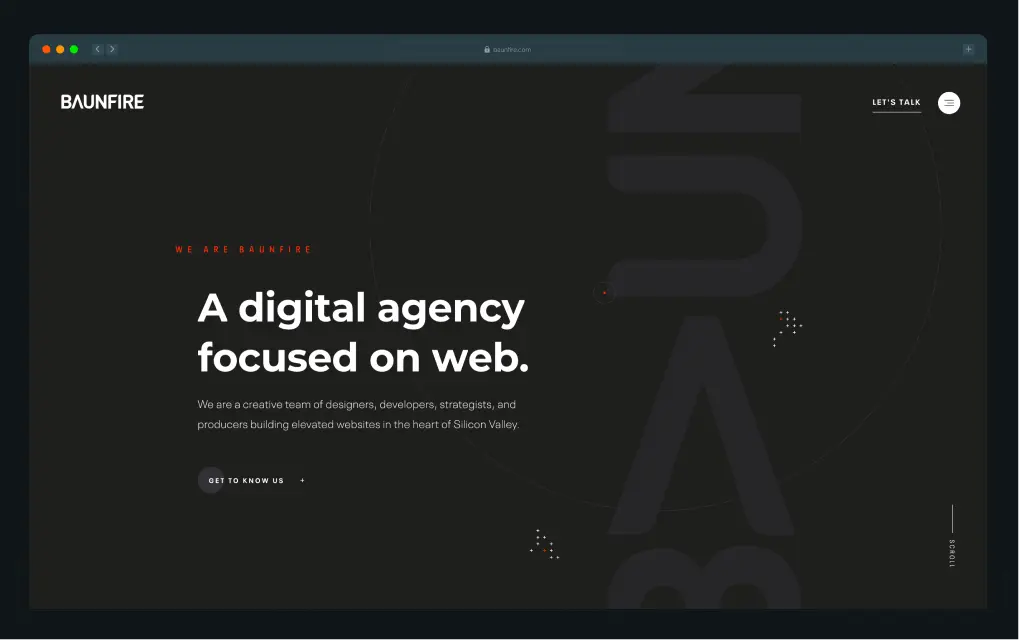
Baunfire is a Silicon Valley-based digital agency renowned for its expertise in web development. They specialize in creating custom, high-performance websites that blend innovative design with robust functionality. Their team of developers and designers collaborates closely to deliver seamless digital experiences tailored to each client's needs.
Core services:
- Using HTML, CSS, and JavaScript frameworks to create responsive and interactive user interfaces
- Server-side logic and database management
- Customizing content management systems to allow clients easy control over their website content
- Building secure and scalable online stores with integrated payment gateways
Best for: Companies seeking a digital agency with a strong focus on web development, offering tailored solutions to meet specific business objectives
Proof in the portfolio: Baunfire has partnered with notable clients, including Karat, Cellares, Lumena, and Ambi Robotics, delivering custom web solutions that align with their clients' brand and business objectives.
6. UPQODE

UPQODE is a B2B web design agency that combines custom web design with full-stack development to help businesses build fast, modern, and scalable websites. Based in Nashville, they work with startups, SaaS companies, and enterprise clients across industries like cybersecurity, communications, logistics, and tech.
They architect user-friendly, responsive sites that drive conversions and support long-term growth. Whether it’s a marketing site, a customer portal, or a web app, UPQODE’s team brings strong design, clean development, and SEO-ready structure to every build.
Core services:
- Custom WordPress development tailored to business needs
- Web portal and web app development for B2B workflows
- Full-stack development using PHP, HTML, CSS, and modern JS frameworks
- Responsive design with cross-browser and cross-device compatibility
- SEO-friendly architecture and performance optimization
Best for: B2B companies and SaaS brands looking for high-quality, scalable web platforms with a balance of design and technical precision
Proof in the portfolio: UPQODE has partnered with clients like Concentric AI, AmeriFreight, and the Spondylitis Association of America.
7. EIGHT25MEDIA

Looking for the best web development agencies in the USA that combine Silicon Valley innovation with a proven track record? EIGHT25MEDIA, based in San Jose, California, has been delivering high-impact digital experiences since 2011.
With a team of over 50 experts, they specialize in creating responsive, user-centric websites that drive business growth and success. Their approach combines strategic consulting, cutting-edge technology, and a deep understanding of client needs to deliver results that matter.
Core services:
- Expertise in CMS platforms like WordPress, Magento, Craft, and Drupal, using technologies such as HTML, CSS, Node.js, PHP, MongoDB, Angular, React, and MySQL
- Responsive design focused on a seamless UX
- Digital strategy development aligned with business goals
- UX/UI design that creates intuitive interfaces
Best for: Mid-market to enterprise-level companies, particularly in the tech, media, and e-commerce sectors, seeking a strategic partner for comprehensive web development solutions
Proof in the portfolio: EIGHT25MEDIA has collaborated with industry leaders such as WeWork, Samsung, Hyundai, NBC Universal, SoftBank, Kaiser Permanente, and Machine Zone, delivering tailored web solutions that drive business success.
Also read: 5 Tips & Best Practices for Maintaining your WebFlow Website
8. Motion Tactic

Motion Tactic is a B2B-focused web development agency based in Tempe, Arizona. They build custom websites that combine strong design with powerful performance to help businesses grow. Their approach centers on creating scalable, secure websites that adapt as your company evolves. With a solid track record, they prioritize long-term success over quick fixes.
Core services:
- Full-stack web development with React, Node.js, and CMS integration
- UX/UI design tailored for B2B audiences
- Website performance audits and website strategy planning
- Post-launch support and iterative improvements
- Enterprise-grade scalability and security
Best for: B2B companies that want a strategic web development partner focused on growth and technical excellence
Proof in the portfolio: Motion Tactic has delivered tailored web solutions for clients like InEight, Skybox Security, Anomalo, MediaAlpha, Tracker Technologies, Awake, Cooper Law Partners, and Arizona State University.
9. Huemor

Huemor positions itself as one of the best web development agencies in New York, with a simple mission: build websites that customers love and competitors envy. With additional offices in Pittsburgh and Chicago, they have built a reputation for construction, engineering, and industrial companies' projects.
They specialize in tackling complex redesigns that combine clean design, strong UX/UI, SEO, and custom functionality to deliver measurable business impact.
Core services:
- Website development, website design, and website redesign
- Custom web development and advanced functionality integration
- Ongoing website support, protection, and continuous improvements
- SEO copywriting, keyword research, and content marketing
Best for: Brands with websites that need a redesign focused on lead generation and conversions
Proof in the portfolio: Huemor has worked with Boston Dynamics, United Steelworkers, HySafe, HITT Contracting, and Bizrate Insights, consistently improving performance, user engagement, and lead generation for their clients.
{{specficService}}
10. SPINX Digital

Using technologies like HTML5, CSS, JavaScript, React, .NET, Ruby, and PHP, SPINX Digital delivers high-performing, future-ready websites optimized for all devices. Their focus is on combining technical expertise with design to produce sites that engage users and drive business growth.
They prioritize every detail contributing to long-term success, including UX, accessibility, mobile responsiveness, content strategy, SEO, and maintenance. Following W3C standards and best coding practices, SPINX ensures solid foundations for its clients’ websites.
Core services:
- Full-stack web development with HTML5, CSS, JavaScript, React, .NET, and PHP
- UX/UI design with focus on accessibility and mobile responsiveness
- Website optimization for SEO, speed, and user performance
- Post-launch maintenance and ongoing support
Best for: Businesses seeking technically robust, scalable websites that prioritize user experience and sustainable growth
Proof in the portfolio: SPINX Digital has delivered successful projects for Warner Bros., Red Bull, Universal Studios, and Cisco, showcasing their ability to blend creativity with technical precision.
11. Lounge Lizard
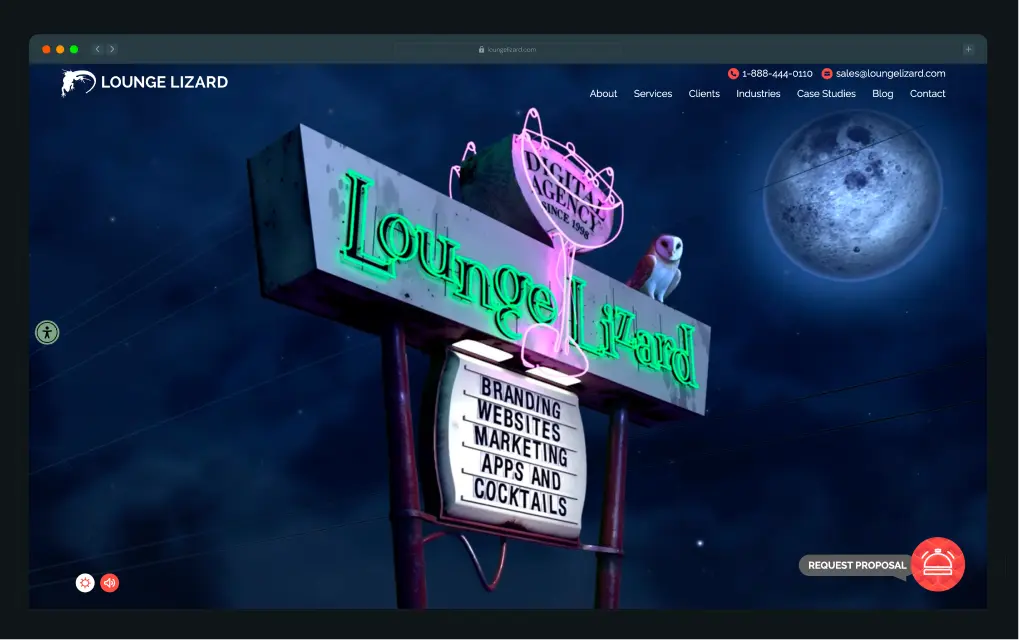
As one of the best web development agencies in the USA, Lounge Lizard combines creative design with robust web development to craft websites that capture attention and deliver strong performance. Active since 1998, they focus on building custom, responsive websites that perform well across devices and drive measurable results.
From CMS integration to ecommerce development, Lounge Lizard combines design and code to help brands engage users and drive revenue growth. Their full-service approach also includes digital marketing, ensuring every website aligns with business goals and maximizes conversions.
Core services:
- Custom web development using HTML5, CSS3, JavaScript, and PHP
- CMS integration and development (WordPress, Drupal)
- Ecommerce platform development (Shopify, Magento)
- Brand strategy and digital marketing alignment
- Website redesign and ongoing website optimization and maintenance
Best for: Mid-sized to enterprise businesses seeking creative, fully integrated web solutions that drive engagement and conversions
Proof in the portfolio: Lounge Lizard has partnered with industry leaders such as Canon, Nestlé, Warner Music Group, The Fragrance Group, and NuLife Nation, consistently delivering websites that improve user engagement and business performance.
12. Lform Design

Manufacturers need websites that speak their language and convert visitors into leads. Lform Design specializes in custom web design and development exclusively for B2B manufacturing companies, with over 15 years of industry experience. Their team builds clean, responsive, and SEO-optimized websites that showcase manufacturing capabilities, boost organic search rankings, and drive measurable lead growth.
Need integration capabilities for a specific technology? The agency supports enterprise-grade systems, including Salesforce, AWS, HubSpot, Shopify, SAP, BigCommerce, and NetSuite, to create unified digital platforms that improve operational efficiency and customer engagement.
Core services:
- Custom manufacturing website design with SEO focus
- Responsive, mobile-friendly web development
- Integration with Salesforce, HubSpot, SAP, AWS, Shopify, BigCommerce, and NetSuite
- Ongoing SEO, site maintenance, and performance tracking
- Branding support: logo design, collateral, presentations
Best for: Mid-sized to large manufacturing and industrial companies seeking specialized web design and development
Proof in the portfolio: Lform Design has partnered with industry leaders such as Fujifilm, Insight Partners, Dauphin, Fuso, and Cast.
Next steps: Finding your ideal web partner
Let's say you’ve shortlisted the top three agencies from this list, and now it’s time to find the perfect fit. Reach out to these agencies to learn about their processes, timelines, and pricing. The ideal partner will provide a clear overview of how they work, demonstrate experience with brands like yours, and share examples of the results you can expect. Ultimately, select the best web development agency that best aligns with your goals and company culture.
If you’re still unsure, here’s why we should make it onto your list:
- 129+ B2B website revamps for high-growth companies
- 140+ websites launched across SaaS, fintech, and AI
- Up to 50% increase in conversions delivered for clients
- Trusted by Amazon, Factors, Razorpay, and Storylane for growth-focused design
{{ctaBlock}}
FAQs
1. How do I choose the best web development agencies for B2B websites?
Start by evaluating the agency’s track record with B2B clients, their portfolio quality, and technical expertise. Look for agencies that specialize in your industry, whether it’s SaaS, fintech, or AI, and prioritize those that offer a conversion-focused approach and scalable CMS platforms.
2. What should I consider when hiring the best web development agencies?
Some of the key criteria include responsive design, SEO capabilities, experience with modern platforms like Webflow or WordPress, performance optimization, and the ability to deliver custom features tailored to your business goals.
3. Why do B2B brands choose ThunderClap over other web development agencies?
ThunderClap has launched over 140 custom websites and completed more than 129 B2B revamps for fast-growing SaaS and fintech companies. Clients trust us for our conversion-first Webflow process, scalable CMS solutions, and measurable impact on engagement and pipeline growth.
4. Why is conversion-focused website design crucial when hiring the best web development agencies?
Because your website isn’t just a digital brochure, it’s your #1 growth channel. A conversion-first approach ensures your site turns visitors into leads and directly impacts pipeline revenue.

10 Best Landing Page Designs in 2025 (With Takeaways You Can Use)
Here’s the hard truth: in 2025, your ads don’t win. Your content doesn’t win. Your targeting doesn’t win. Your landing page wins.
Why? Because it’s the one place where all your effort and spending converge (and where most brands lose the customer). You’ve paid for the click, grabbed attention for a few fleeting seconds… and if your landing page isn’t designed to convert, it’s game over.
We’ve worked on 129+ B2B websites like Amazon, Razorpay, and Factors. The difference between a good landing page and a great one isn’t subtle. It’s the difference between campaigns that bleed budget and campaigns that compound growth. That’s why we’re not here to show you a bunch of pretty pages. We’re here to break down the 10 best landing page designs in 2025, explain what makes them work, and give you takeaways you can put into practice right now.
Think of this as your landing page design inspiration playbook: part strategy, part teardown, and part checklist. By the end, you’ll know exactly how to evaluate your own pages and how to design landing experiences that don’t just look good, but actually drive conversions.
The CLEAR framework: how we evaluate landing pages
Before we dive into the best landing page design examples, let’s set the lens. A good landing page in 2025 isn’t defined by clever copy or slick design alone. You have to put all the pieces together to convert.
That’s why we use the CLEAR framework at ThunderClap for website and landing page revamps:
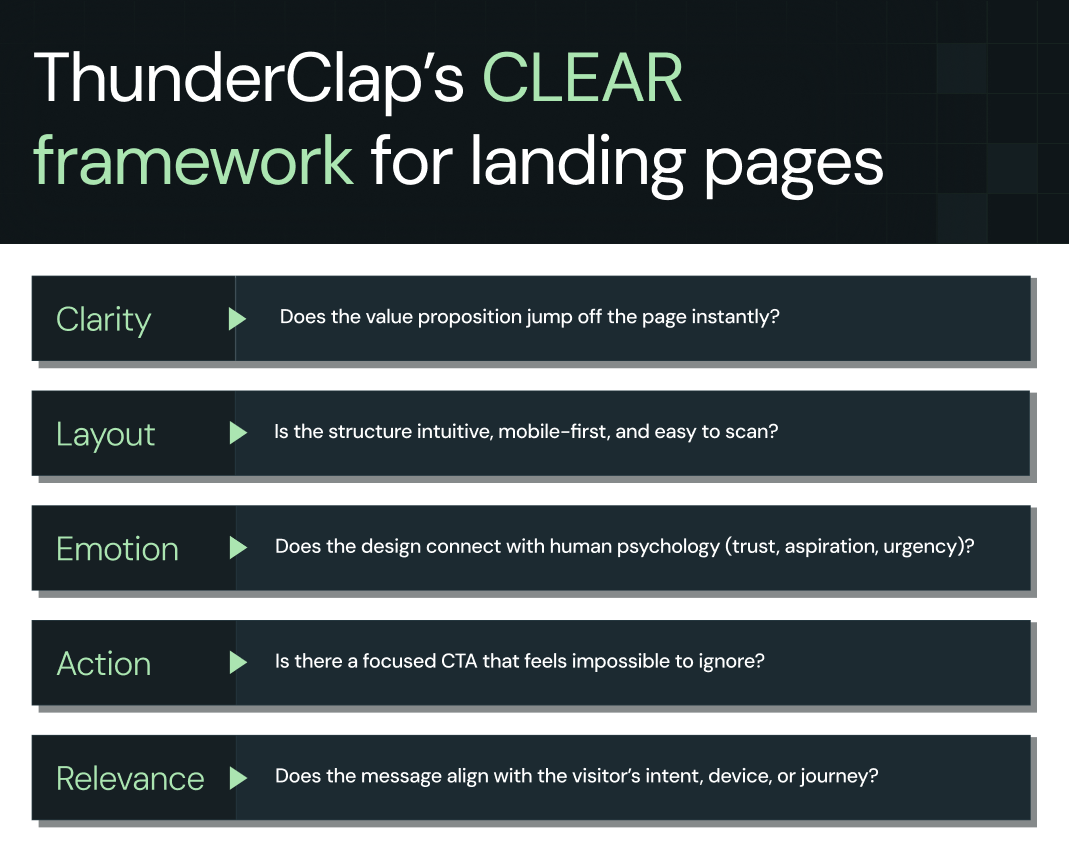
Every high-converting landing page we review below nails these elements in different ways. And the good news? You can take these patterns and apply them to your own web pages today.
We recently redesigned ConsultAdd’s website using the same principles and lifted conversions by 60%. Here’s a video walkthrough of the before and after of their home page makeover:
The 10 best landing page designs in 2025 (with takeaways)
Now that we’ve set the lens with the CLEAR framework, let’s explore how today’s top brands are applying these principles in practice. We’ve curated 10 of the best landing page designs in 2025, spanning SaaS, productivity platforms, AI startups, and communication tools.
1. Storylane (a SaaS landing page where the demo is the design)
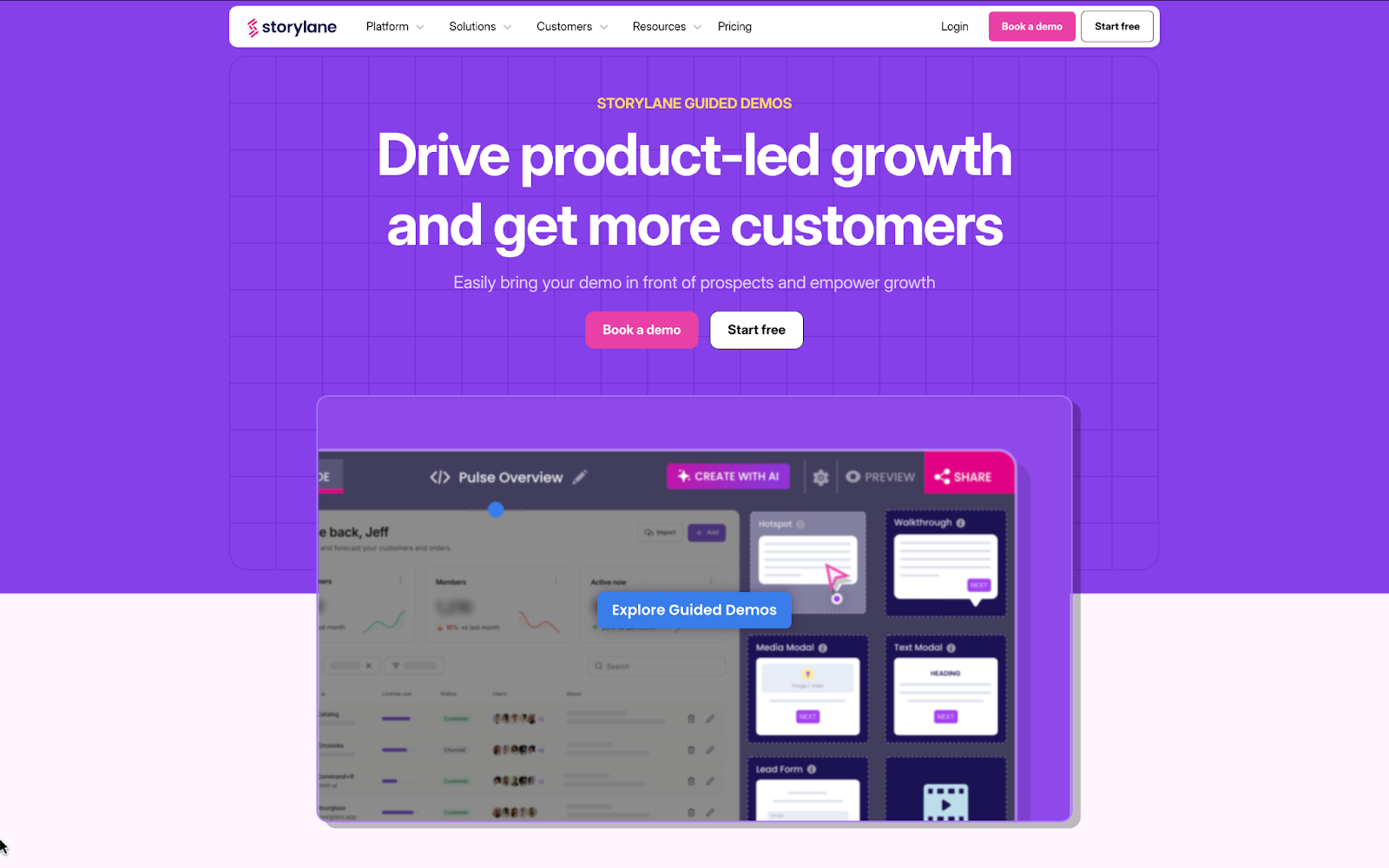
Storylane’s landing page overhaul is a masterclass in aligning design with personality. When they came to us, they had solid copy but felt their website lacked personality. Our mandate was clear: keep the words, transform the brand.
The copy stayed the same, but we changed everything around it. By introducing a bold, playful brand identity (clean fonts, a neutral base palette with pops of color, and custom illustrations), the page finally matched Storylane’s innovative positioning.
The results speak for themselves: 36% more website impressions and a 30% lift in demo requests since launch. Why? Because the design now amplifies the existing copy instead of competing with it.
The layout is modular and scannable, trust is established through logos and proof points, and the CTAs (“Get a demo”) are repeated consistently across every scroll segment.
📌 Read the full breakdown in this LinkedIn post by Kiran Kulkarni, Partner & Head of Growth at ThunderClap, including the exact design process and before/after insights.
Your takeaway from Storylane
If your product sells itself when shown, don’t bury the demo. Make it the centerpiece of your landing page and reinforce it with one clear, repeated CTA.
2. roommaster (a hospitality landing page built on trust and clarity)
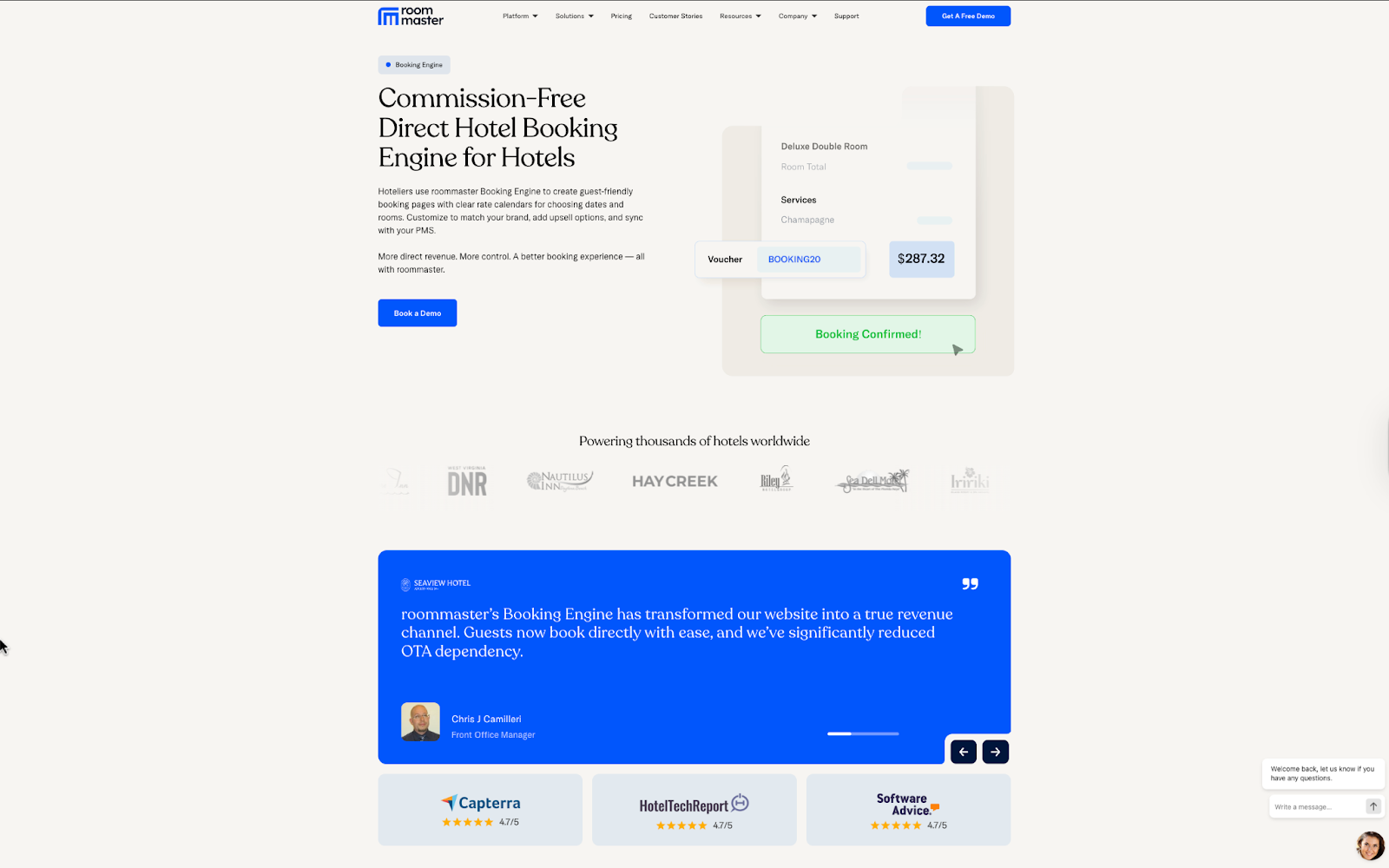
When roommaster rebranded from InnQuest, they trusted us to bring their new identity to life online. We built a landing page that makes the value proposition unmistakable: “Commission-Free Direct Hotel Booking Engine for Hotels.” Clarity is immediate, reinforced by testimonials and partner logos. We designed the layout to highlight benefits and use cases in a scannable, modular flow.
To spark emotion, we leaned on real hotel imagery, review badges, and credibility markers. For action, we kept it simple and consistent with a prominent “Get a demo” CTA. And for relevance, every section speaks directly to hoteliers who want to drive direct bookings.
Your takeaway from roommaster
Make benefits scannable. Break down key advantages into bite-sized blocks or cards that a busy reader can skim.
3. Deductive AI (a futuristic landing page example for AI startups)
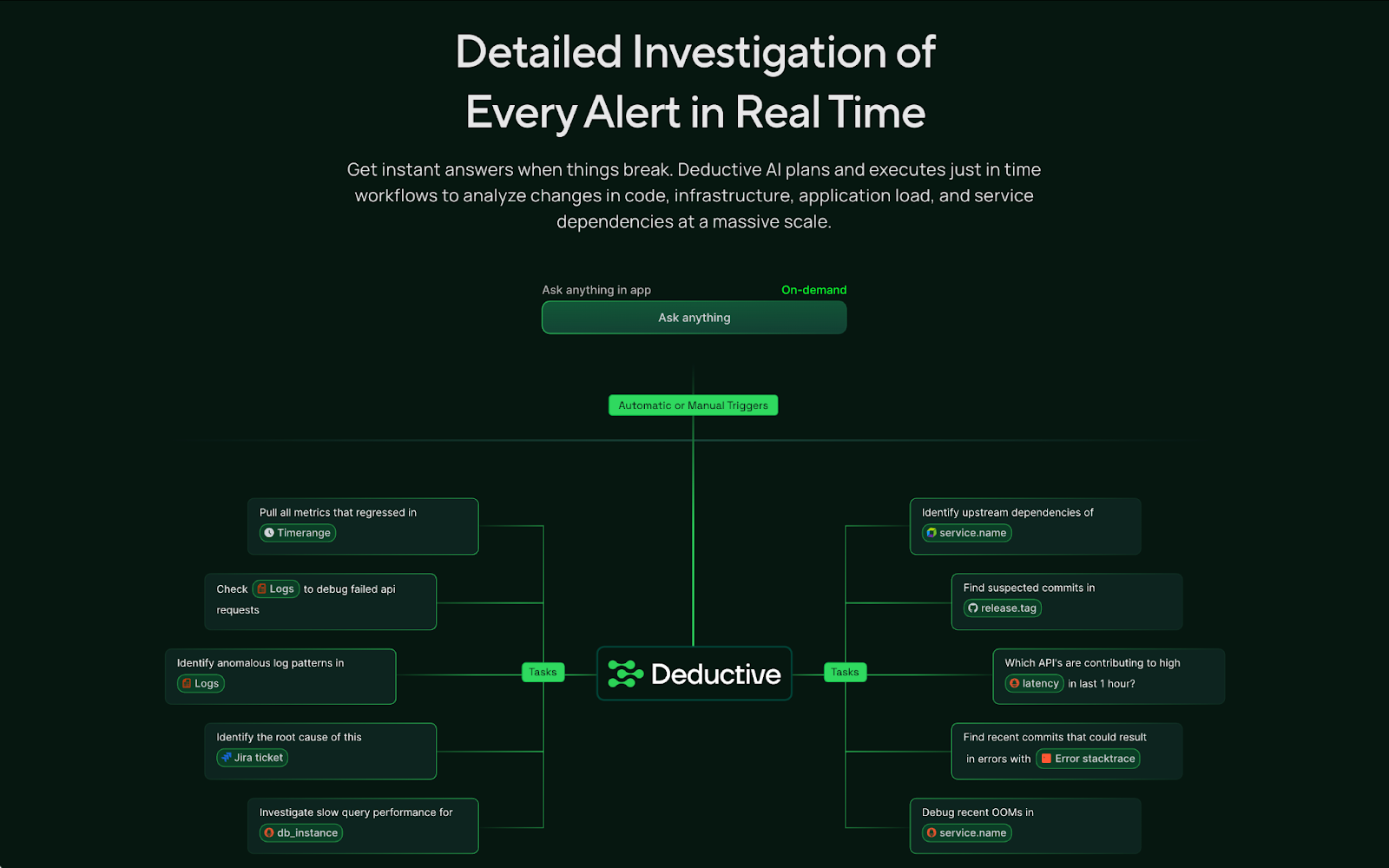
When two ex-MAANG leaders founded Deductive AI, they partnered with us to shape a bold brand identity and build a website from the ground up. We designed a dark, futuristic aesthetic to match their positioning as an “AI on-call engineer.” Clarity comes through in the concise headline and strong hero CTA.
The layout uses diagrams, flows, and modular sections to explain a complex product without overwhelming visitors. For emotion, the design leans into authority with encrypted security visuals, enterprise-grade messaging, and trusted integrations.
Action is consistent with clear CTAs (“Schedule demo”) placed across scroll depth. And in terms of relevance, every element speaks directly to technical teams who manage scale and reliability.
Your takeaway from Deductive AI
If your product is technical and complex, use visuals and modular flows to simplify the story without dumbing it down.
{{specficBlog}}
4. Factors (a B2B landing page that connects fragmented buyer signals into one story)
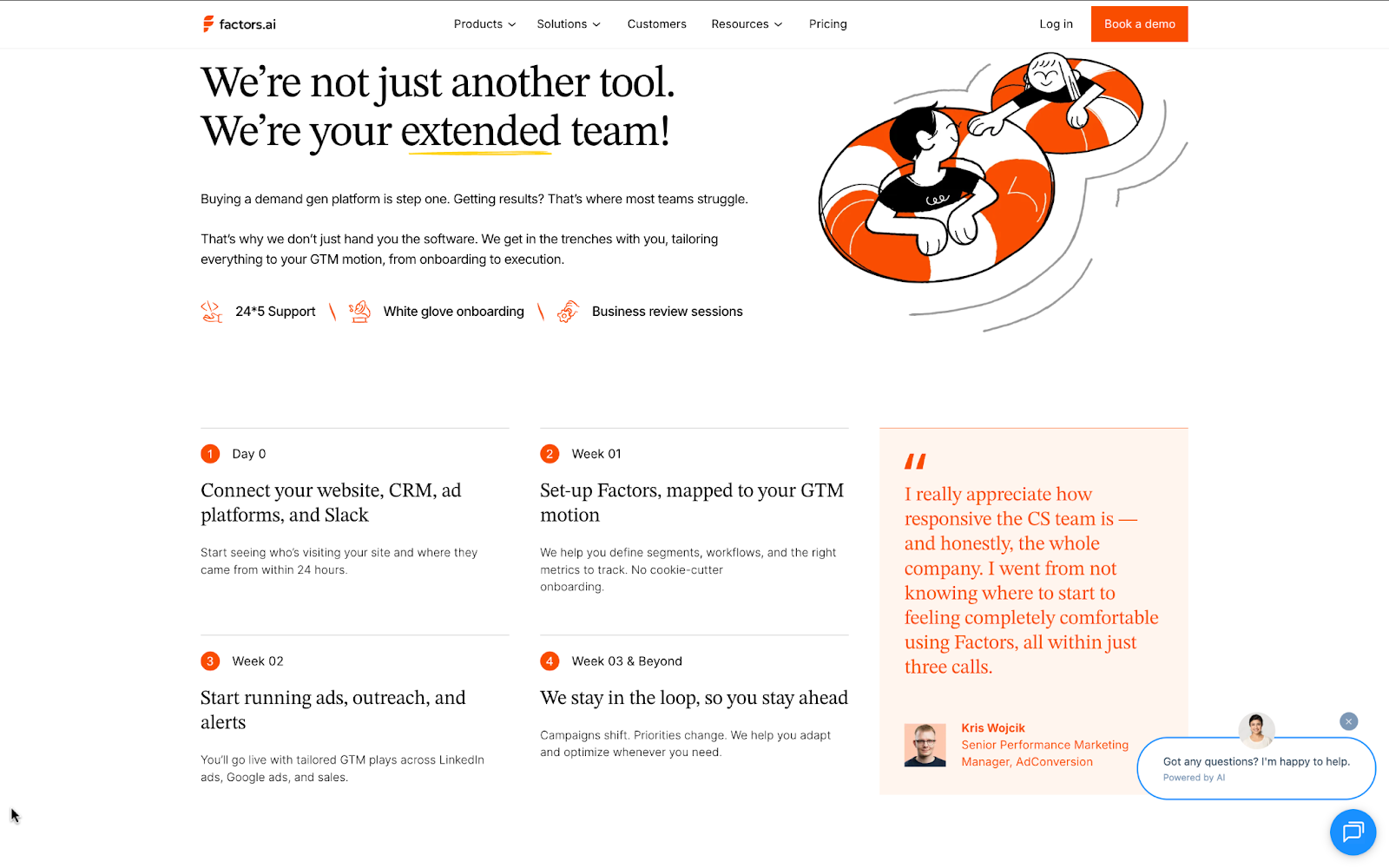
When Factors partnered with us, they wanted a landing page that could show the power of unifying scattered buyer data. We built the page to deliver clarity from the start with the headline “Know how your buyers move. Run campaigns that win.”
The layout tells a story step by step: why fragmented signals are a problem, how Factors solves it, and proof of success through testimonials and client logos. One of our favorite sections is the execution timeline section that walks visitors through the exact journey of using Factors. This narrative flow shows how insights move from messy signals to actionable campaigns in just 3 weeks (a feature most B2B pages lack).
To create emotion, we introduced bold patterns, vibrant colors, and human elements like customer quotes. Action is simple and repeated. “Get a demo” and “Learn more” CTAs guide the journey.
For relevance, enterprise-grade security badges and recognizable brands reinforce trust.
Your takeaway from Factors
If your product connects the dots, structure your landing page like a narrative (problem, solution, proof, action).
After your homepage, your pricing page is often the most visited (and most overlooked) page on your site. We analyzed 50+ SaaS pricing pages and built a blueprint with insights, a wireframe, and a checklist you can apply today.
Get the Pricing Page Blueprint
5. Mailmodo (an interactive landing page design for marketers)
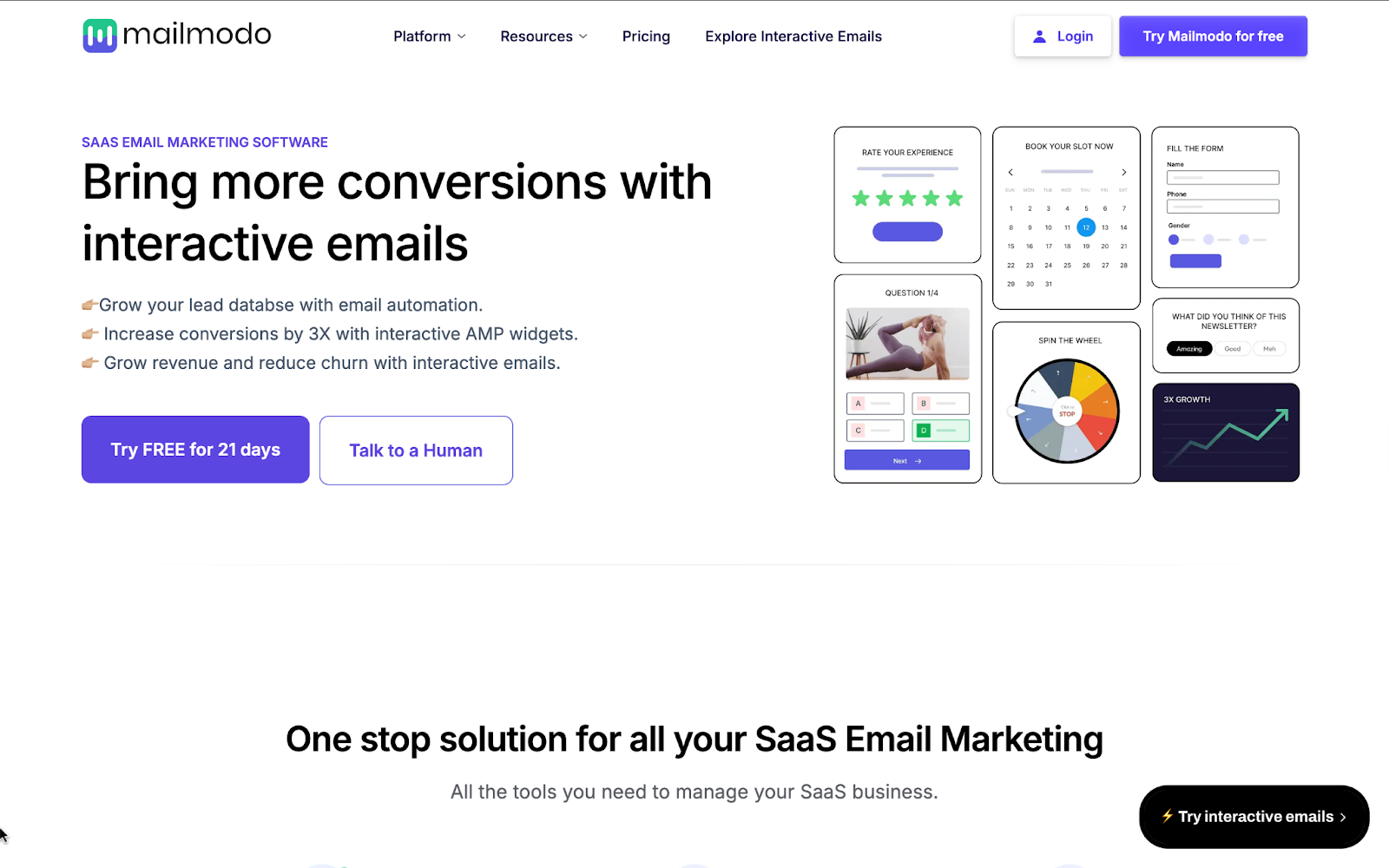
Mailmodo’s SaaS-focused landing page shows how tailoring content to a specific audience pays off. Clarity comes through the headline, “Bring more conversions with interactive emails”, followed by a subhead that positions it as “One-stop solution for SaaS email marketing.”
The layout is tailored for SaaS use cases: common flows like “user onboarding” and “feature adoption” are explained with visuals, followed by product screenshots and sample templates. Emotion is sparked through customer testimonials and logos from well-known SaaS brands, paired with ROI-focused language like “3X email conversions.”
The action is consistent with “Start free trial” CTAs at natural scroll points. Relevance shines here: every example, from integrations (HubSpot, Salesforce, Zapier) to templates, is built for SaaS teams.
Your takeaway from Mailmodo
Build dedicated landing pages for your top personas or industries, showing their flows, their integrations, and their language, creates social proof.
Also read: Decoding The Above the Folds (ATF) Of 100 SaaS Brands [Backed by research]
6. Figma (a collaborative SaaS landing page that shows, not tells)

Figma’s landing page is a design-first experience that mirrors the product itself. Clarity comes from the headline “Prompt, code, and design from first idea to final product.”
The page opens with colorful project previews that set the tone. The layout is simple and visual. Screenshots, templates, and community examples show how teams use Figma. Emotion comes from bold colors, playful shapes, and proof from big names like GitHub. The action is direct. One clear “Get started for free” CTA anchors the page.
And relevance is strong because every block speaks to designers and developers working together.
Your takeaway from Figma
Use community work as proof. Highlight templates, creations, or examples from your users to show versatility and build social validation.
7. Miro (a visual landing page example that mirrors the product)
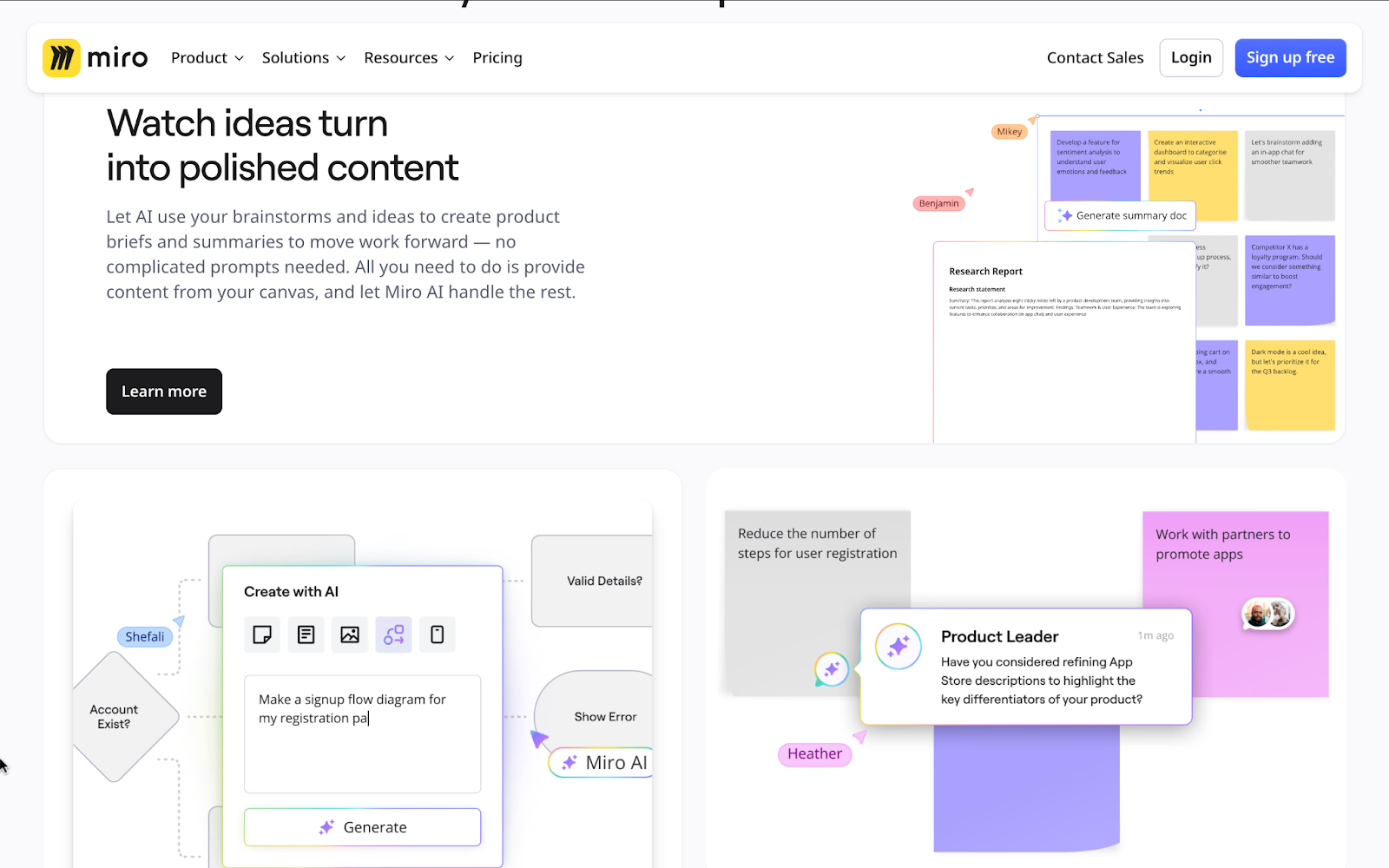
Miro takes a different route from the other pages we’ve seen. Where Figma highlights creativity and Storylane pushes demos, Miro puts collaboration at the center. Clarity comes fast: “Intelligent Canvas” plus a hero demo that shows sticky notes, flowcharts, and team comments in one place.
The layout is stacked with live-looking boards, widgets, and templates (you can almost imagine your team using it). Emotion isn’t about design flair here but togetherness. Headlines like “Collaborate as one team” and customer quotes make it feel human. Action is frictionless with “Start a demo” CTAs.
And the relevance is obvious: this page speaks to distributed teams trying to move faster together.
Your takeaway from Miro
Use templates as proof of value. Highlight ready-made templates or widgets so users know they can start fast without building from scratch.
If you run demos, use ThunderClap’s High-Converting Demo Page Playbook. We studied 30 B2B SaaS brands to identify landing page optimization strategies that leading brands employ on demo pages.
8. Loom (a video-first landing page design that builds instant connection)

Loom’s is a landing page design inspiration if you want to lead with product in action. Clarity comes from the headline “Free Screen Recorder” and the hero visual of a recording interface with a human face on screen.
The layout is straightforward: top features in a checklist, then blocks for capture, editing, sharing, and feedback. Emotion comes through people-centered visuals and playful touches like emoji feedback.
Action is simple and consistent with “Start recording” CTAs that appear throughout. And relevance is strong because the page highlights specific use cases from project proposals to market research and availability on iOS and Android.
Your takeaway from Loom
If your product is about communication, put people at the center of your visuals, not just the tool.
Also read: 20 Proven SaaS Conversion Optimization Hacks to Boost Your Sales
9. Canva (a landing page that proves speed and scale with templates)
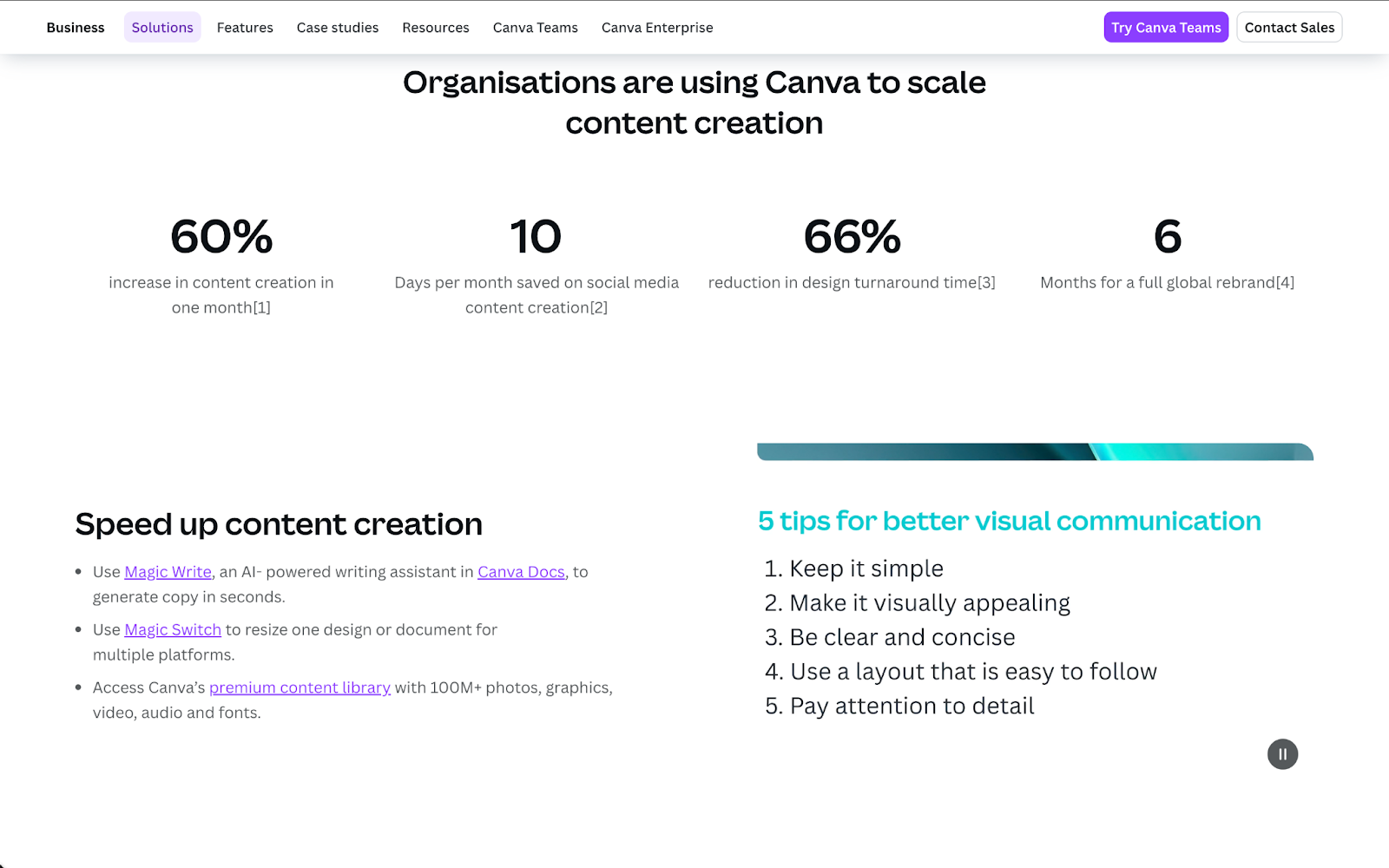
Canva’s page doubles as a product demo and a template marketplace. The headline, Create better content, faster, tells you what it does in one line. The layout then proves it. Big product screenshots sit next to template galleries, use-case blocks, and team-focused messaging. Emotion comes from bright visuals and diverse mockups that feel approachable to non-designers.
Action is simple. A single, clear CTA appears throughout. Relevance is where Canva outpaces others. It sells speed, brand control, and repeatable content workflows for teams. It pairs product features with actual templates, guides, and resources so visitors can start creating right away.
Your takeaway from Canva
Build template-driven flows for your top use cases so visitors can see how fast they can get real work done.
10. Zoom (a platform landing page built for enterprise momentum)

Zoom’s home page is one of the best SaaS landing page examples showing how to position a full platform without overwhelming visitors. Clarity comes from the headline “Find out what’s possible when work connects” and product cards that instantly preview core tools like Meetings, Team Chat, and AI Companion.
The layout is modular: hero → product cards → AI highlight → customer proof → use cases, each block clean and easy to scan. Emotion is built through credibility — enterprise logos, customer ratings, and stories from companies like Major League Baseball. Action is flexible: CTAs let you sign up free, explore features, or learn about AI.
And relevance is high: copy and imagery speak directly to enterprise teams managing hybrid work at scale.
Your takeaway from Zoom
If your product is a suite, structure your landing page so visitors can pick their own entry point without losing clarity.
Also read: 10 Hottest B2B Web Design Trends You Need in 2025
Best practices for landing page designs: apply CLEAR to your own landing pages
After breaking down the best landing page designs, we don’t want you walking away thinking, “Cool, but what do I do with this?” Inspiration is nice, but execution wins. That’s why we built the CLEAR checklist on the same framework we use at ThunderClap to help brands design landing pages that actually convert.
Here’s the quick infographic version of the CLEAR checklist:

And if you want the full details, here’s the step-by-step breakdown of each element:
Clarity
- Can a new visitor explain your offer back to you in one sentence? Test this with someone outside your team.
- Is the headline benefit-driven (what I get), not product-driven (what you do)?
- Remove jargon, acronyms, and filler — every word should earn its spot.
- Above-the-fold: one headline, one subhead, one CTA. Nothing more.
Layout
- Does your page follow a natural “F-pattern” or “Z-pattern” for scanning?
- Is the hero image aligned with the message (no random stock photos)?
- Are forms short, frictionless, and mobile-friendly?
- Have you trimmed visual clutter (multiple CTAs, carousels, distracting menus)?
Emotion
- Does your page trigger trust (logos, testimonials, case studies, security badges)?
- Are you tapping into urgency (limited seats, countdowns) or aspiration (success stories, future state)?
- Is there video, motion, or interactivity to engage beyond static text?
- Does the imagery feel human and relatable, not generic?
Action
- Is there exactly one primary CTA? (Sign up, Start free trial, Book a demo)
- Is the CTA button copy benefit-driven (e.g., Get started free vs. Submit)?
- Is the CTA visible without scrolling, and repeated logically as the user moves down the page?
- Do you offer a low-friction “secondary action” for fence-sitters (watch a demo, learn more)?
Relevance
- Does the landing page headline mirror the ad/email/search copy that brought the visitor there?
- Is the page segmented or personalized (by industry, persona, or geography)?
- Does the design work seamlessly on mobile, tablet, and desktop?
Have you tested load speed? Every second delay costs conversions.
How to use this checklist?
- Print this out
- Use it as a 5-step landing page audit
- Run every new campaign through CLEAR before launch
Turning landing pages into growth engines with ThunderClap
At ThunderClap, we know a landing page is never just a page. It’s your most important growth lever. We’ve optimized and redesigned 129+ B2B websites like Storylane, Amazon, Factors, roommaster, Deductive AI, and Zenda, and built their landing page experiences from the ground up.
Our work speaks for itself. Storylane lifted demo requests by 30%, and Zenda’s rebrand earned an Awwwards nomination.
Our process is proven. We start with mood boards that capture brand personality. We establish scalable systems for consistency. We bring products to life with custom illustrations, bold yet clean layouts, and trust-driven storytelling.
With us, you get:
- Bold design that matches your product’s personality.
- Scalable systems that keep visual consistency as you grow.
- CRO playbooks proven across SaaS and fintech.
- A partnership mindset (acting as an extension of your team).
If you’re ready to make your landing page your #1 salesperson, let’s talk. We’ll audit your funnel, pinpoint the leaks, and build a roadmap that gets you results in weeks, not months.
{{ctaBlock}}
FAQs
Do landing page design trends change every year?
Yes, trends in landing page design inspiration evolve constantly as user behavior and technology shift. In 2025, the best landing page designs highlight speed, AI-powered personalization, and mobile-first layouts. While core principles like clarity and strong CTAs remain timeless, keeping up with best practices for landing page designs ensures your page looks modern and drives conversions.
Can I use templates for landing pages, or should I design custom ones?
Both approaches can work. Templates are a fast way to get started, but custom designs give you more control. The best SaaS landing page examples often start with a template and evolve into custom layouts once teams see what converts. Whether you choose templates or custom, following best practices for landing page designs (clear messaging, strong visuals, and one focused CTA) is what matters most.
What are some examples of high-converting landing pages?
In 2025, some of the best landing page designs come from SaaS and fintech brands. Pages like Storylane, roommaster, and Zenda stand out because they combine clarity, trust signals, and relevance with consistent CTAs. If you’re looking for landing page design inspiration, explore the best SaaS landing page examples; they are often the clearest demonstration of how to turn design into conversions.
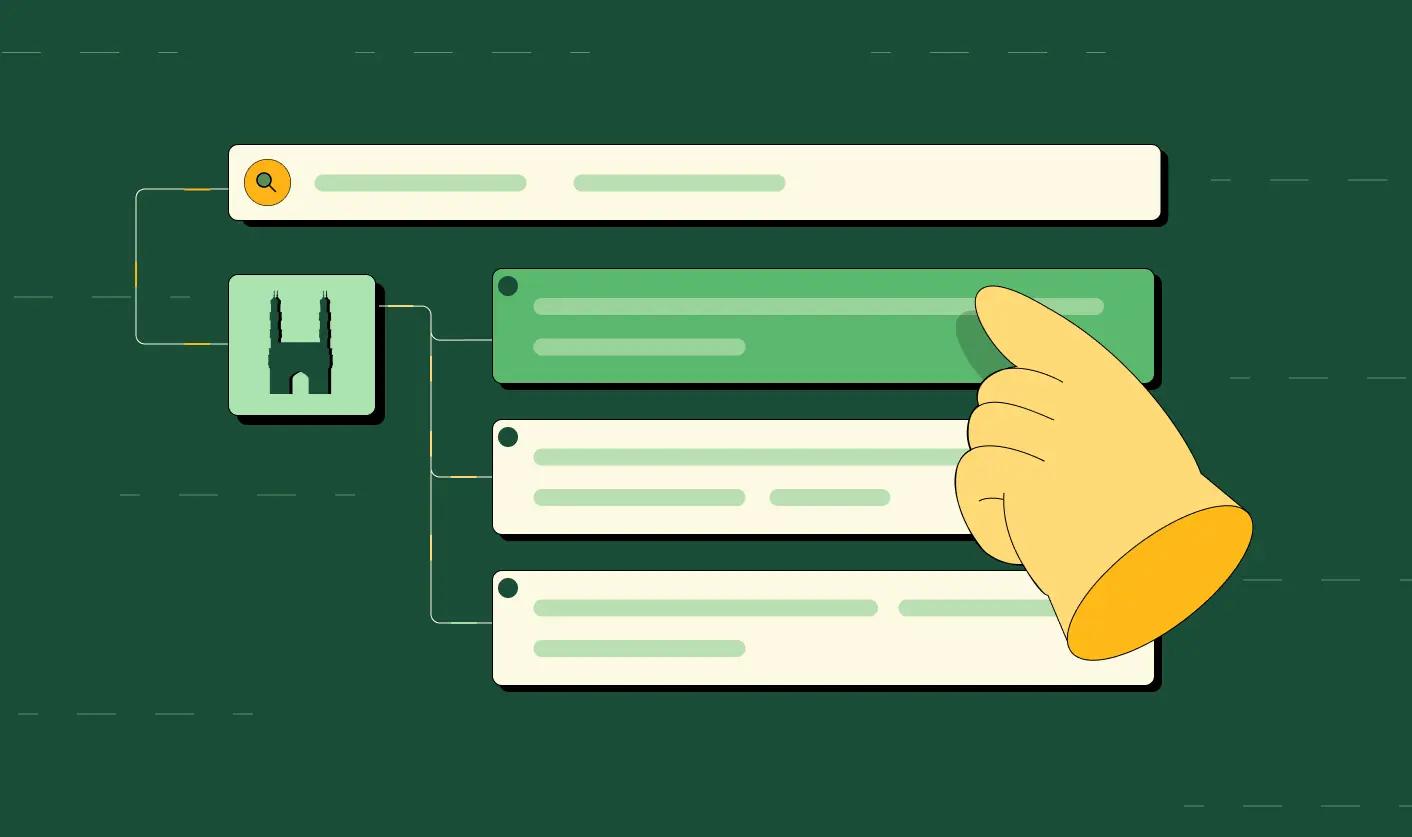
5 Best Web Designing Companies in Hyderabad
Your website acts like a full-time sales rep, working 24/7 without taking a break. But is it converting visitors into qualified leads?
Over 2,52,000 websites are created daily, and around 10,500 websites go live every hour. India alone has over 5.7 million websites. The global click-through rate sits at 4.23%, and more than 28% of businesses operate online. In a market this crowded, weak design means lost revenue.
At ThunderClap, we’ve rebuilt 140+ B2B websites for SaaS, fintech, and enterprise tech companies. We don’t just make sites look good. We make them convert. Every design decision must answer one question: Will this help engage the user?
This blog lists the 5 best web designing companies in Hyderabad, providing examples, use cases, and real value.
Why B2B Web Design and Development Matters More Than Ever
B2B teams often invest months in creating a polished site, only to find it fails to drive results. If your site isn't built for conversions, traffic won't help.
A homepage that looks clean but fails to guide visitors will never help close pipeline gaps. Buyers no longer want to skim through the websites. They want to scroll, click, explore, compare, and revisit before even talking to your sales team.
In fact, B2B prospects go through nearly 13 pieces of content before they fill out a form or request a demo. Most of that happens on your site. If your site takes too long to load, doesn’t explain your value fast enough, or leaves questions hanging, users won’t return.
B2B web design agencies that focus on growth address this issue. They build for the whole cycle, not just the hero section.
Also read: Outsourcing Webflow Maintenance vs. In-House Management: Which is Better?
5 Best Web Designing Companies in Hyderabad
Hyderabad has always been a hotspot for tech and innovation, but the last few years have taken things up a notch. Some of the best B2B web design talent now operates out of this city, serving clients across the globe.
If you’re looking for a website that converts better, loads faster, and doesn’t look like it was made in 2016, our list covering the five best web designing and development companies in Hyderabad will save you a few dozen hours of research.
1. ThunderClap

When B2B marketing teams need websites that convert, they choose ThunderClap. This isn’t your typical design agency that focuses on making things beautiful; ThunderClap builds websites that work as hard as your sales team. With 129+ websites launched and a strong focus on conversion rate optimization (CRO), we’ve proven that when strategy meets design, business goals are significantly exceeded.
What makes ThunderClap the #1 choice among B2B web design agencies in Hyderabad? Their obsession with outcomes over aesthetics. Every pixel, every page, every interaction is designed with one goal: converting visitors into qualified leads. We understand that B2B buyers need education, not just information, and we craft experiences that guide prospects through decision-making processes. Additionally, our designs have been recognized with industry-prestige Webby Awards and CSS Design Awards.
We deliver enterprise-quality websites in 8-10 weeks through our proven Webflow design and development process. Unlike other agencies that take months to launch, ThunderClap gets your conversion machine online quickly.
Take Skyroot Aerospace, for example. As the first private Indian firm to successfully initiate the first orbital launch vehicle, Vikram-1, they didn’t want a safe or boring site. They sought a design that felt bold, tech-forward, and polished enough to rival global aerospace brands.
ThunderClap didn’t land on Skyroot’s final design right away. We explored a few bold directions before finding the perfect mix of sleek grayscale visuals, 3D motion, and WebGL magic. Along the way, we helped shape Skyroot’s messaging too. We rewrote the tagline to refine the core idea behind “Opening Space for All.” It wasn’t just a line; it captured Skyroot’s bigger mission of making space more accessible.
When you land on the homepage, that mission comes alive. The moment you start exploring, it’s clear this isn’t just another aerospace site. The rocket launch animations let visitors feel what Skyroot does: launching missions into space.
Clean, bold typography, lots of breathing room, and subtle motion keep everything polished and easy to follow. Every section flows like a story (mixing inspiration with real product details). You can explore capabilities, timelines, and payload options without ever feeling lost. The homepage feels less like a brochure and more like a digital launchpad — immersive, confident, and built to shift how people perceive a technical brand.
Now, about their Book Your Launch page, which completely flips the idea of a “contact form.”
Instead of filling in boring blanks, visitors build their own launch. They can pick orbits, configure payloads, and choose launch vehicles in a guided, step-by-step flow. It’s like walking through the actual decision process, but beautifully simplified. Rideshare or dedicated mission? The visuals make the trade-offs clear. And once done, everything wraps up neatly into a downloadable ticket.
"ThunderClap’s team really took the effort to understand our space industry and created something that stood apart. I liked that they didn’t give a cookie-cutter solution — the website flow and the ‘Get to Orbit’ section came out exactly how I wanted. It’s a practical, well-thought-out website, not just a cool one."
— Sumil, Head of Brand & Communications, Skyroot Aerospace
Best for: B2B SaaS, fintech, venture capital, and AI companies scaling into new markets or repositioning as category leaders
Proof in the portfolio: ThunderClap’s deep industry expertise spans SaaS, fintech, and AI alongside consulting, commerce, and B2B services. Our client roster, 50% of which are global, includes: Amazon, Storylane, Factors, Skyroot, Deductive AI, Razorpay, and 80+ other B2B companies that chose results over pretty pictures.
Join 88+ fast-growing B2B brands like Amazon, Storylane, Factors, Skyroot, Deductive AI, Razorpay, and Skyroot who chose ThunderClap for websites that look good and drive serious results. With deep expertise across SaaS, fintech, AI, and more, we know what it takes to turn complex ideas into high-converting websites.
Book your strategy session today and see why top B2B teams trust ThunderClap when growth actually matters.
Talk to an Expert
2. Ozrit

If you're looking for web applications that feel fast, scale well, and come with zero drama, Ozrit might be the team for you. With 16 years in the game and over 500 specialists across tech, design, and strategy, they know how to build products that run smoothly and look sharp. From AI-led apps to full-stack builds for mobile and web,
They specialize in responsive websites, cross-platform apps, ecommerce stores, and CMS-powered platforms that marketing teams can edit without involving a developer every second day.
Their process breaks into five simple stages: requirement planning, design, development, testing, and post-launch support, and they’ve stuck to it across hundreds of projects.
Best for: Product-led businesses, marketplaces, and delivery-based services requiring custom functionality or full-stack builds with integrated AI-driven features
Proof in the portfolio: With over 270 happy clients across cross-platform projects and 320+ for mobile and app design services, Ozrit has helped businesses ship food delivery apps, taxi platforms, and even local services like milk delivery apps.
3. Inovies
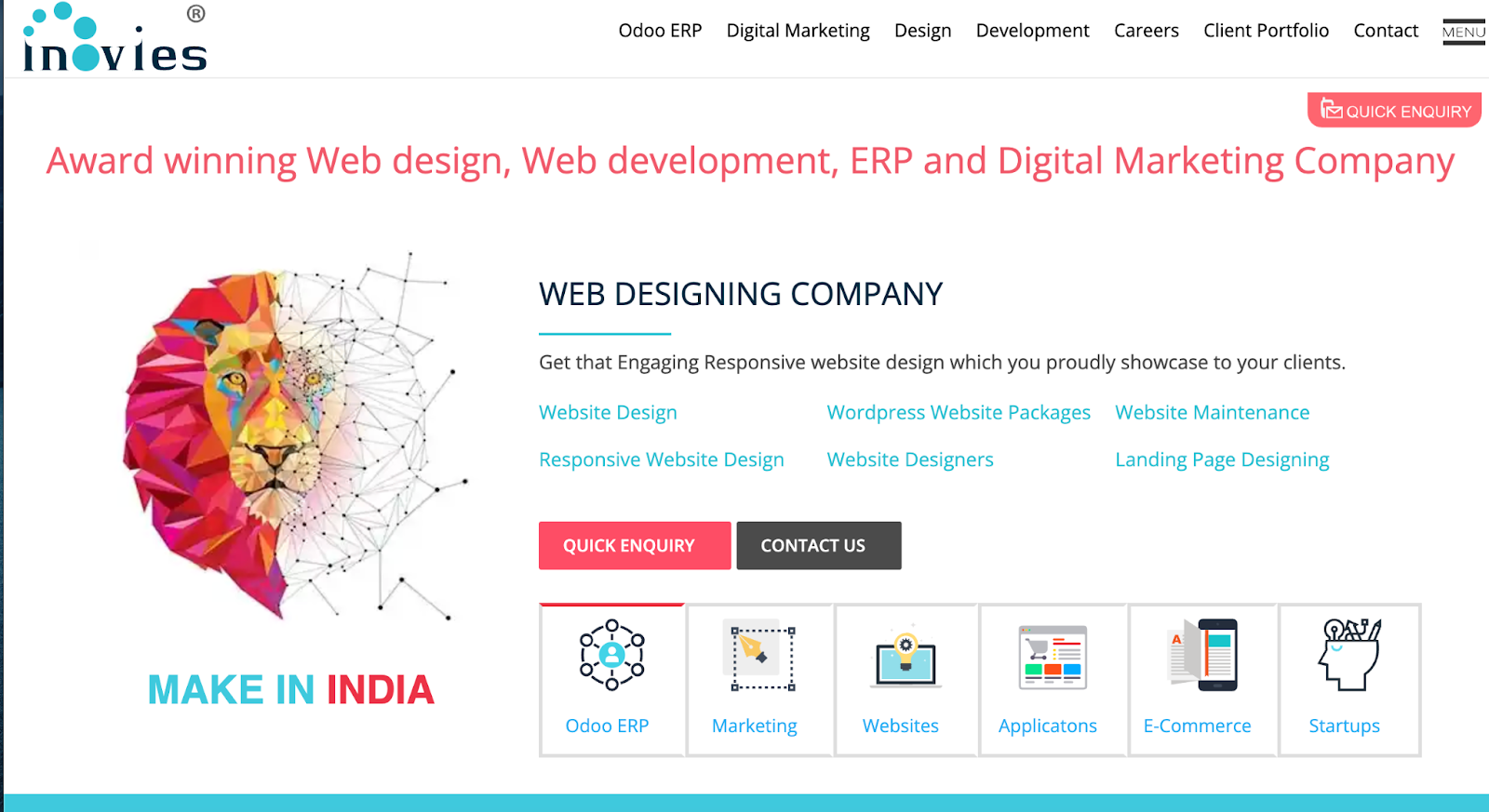
As a web designing and development company in Hyderabad, Inovies built a reputation for creating sites that feel modern, load fast, and adapt across devices. Their team builds experiences that speak to your audience’s needs.
Inovies offers services ranging from custom website design to complete web application development, including responsive, mobile-first builds and integration with CMS systems. They also handle ecommerce development and dynamic web projects that require deeper features and logic. Their methodology progresses through planning, design, development, testing, and post-launch support, all with real accountability.
Best for: Midsize businesses, enterprises, and organizations needing curated design, scalable features, or digital transformation work
Proof in the portfolio: Inovies has a diverse client list, including large corporations and government entities like Tech Mahindra and Ordnance Factory Medak, as well as smaller businesses from various sectors such as Glaze And Gloss, Bisolq, and Nice Hospital.
{{specficBlog}}
4. Probey Services
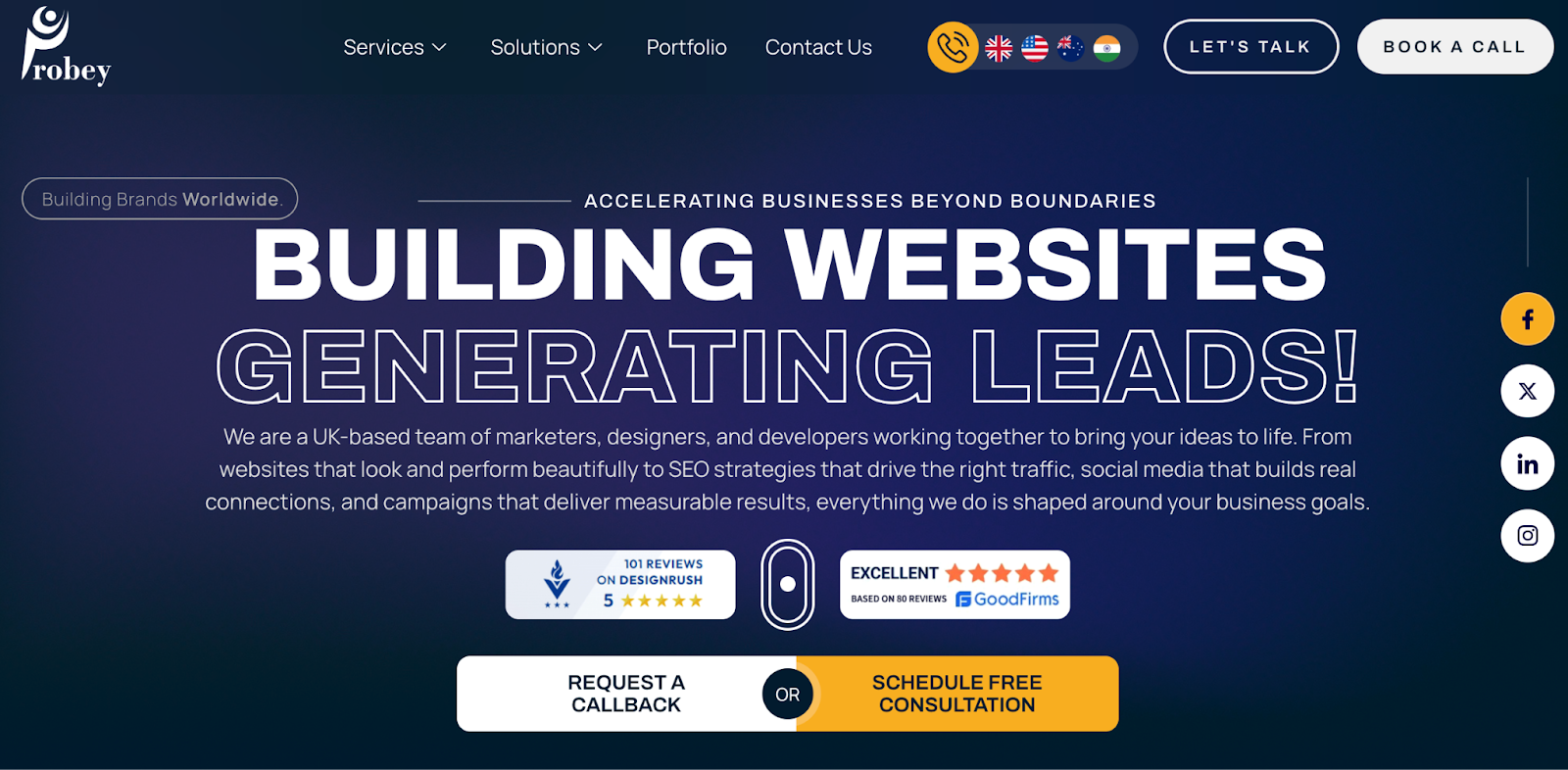
When you want a team in Hyderabad that builds websites and leads at the same time, Probey Services delivers. Their team of marketers, designers, and developers collaborates to create sites that not only look strong but also perform well under pressure. They combine design, SEO, social media, and campaign tactics so your site not only attracts traffic but also converts real users.
They begin every project with a full website analysis, identifying weak pages, slow loading issues, and conversion bottlenecks. Their design and planning phase refreshes visuals and fixes friction points. Then development kicks in using modern stacks and best practices for speed and usability. After coding, they put the site through rigorous testing across devices, browsers, and use cases before launching and optimizing with feedback and data.
Best for: Brands that want marketing and web development under one roof, especially SMBs and growing midmarket firms
Proof in the portfolio: Names such as Bartisans, The Cinammon Kitchen, PNG Jewellers, PRAO, and Laviscart appear in their client list. Additionally, Probey has been recognized as the #1 web design company in India on Clutch, thanks to its exceptional client satisfaction and design quality.
5. Happening Design Studio
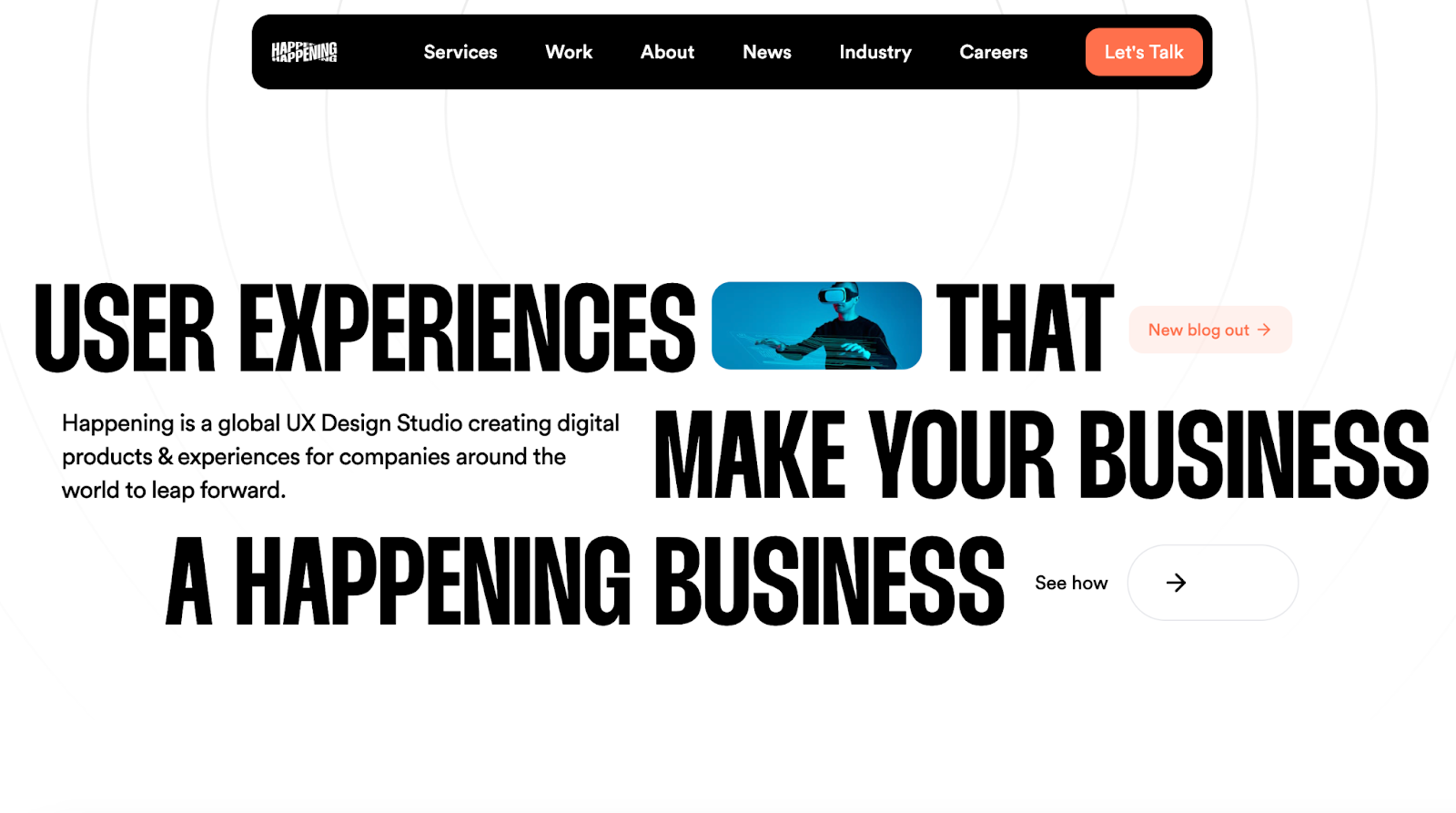
If you’re looking for a web designing and development company in Hyderabad that can combine brand strategy and enterprise web design practices with great UX, Happening Design Studio offers real value. They believe in working with empathy and research to build websites and experiences that matter. Their model doesn’t begin with looks, but it starts with understanding your users, your market, and what they actually need.
Happening handles UX design, research, and strategy with equal seriousness as brand strategy and growth. Their process involves rapid prototyping, user testing, iterative design refinement, and integration into full interactive websites. They also build full‑stack mobile and web apps using modern tools and methods. They serve clients across more than eight industries, delivering over 500 projects so far.
Best for: Projects that need strong user insights, solid UX research, and digital product teams pushing beyond static visuals into full user‑centric design
Proof in the portfolio: Happening Design Studio has worked with clients including Perigon, BURNCO, and iPlanned. They have also collaborated with Ananki to develop a 5G platform, which enabled Ananki to secure a multi-million dollar project. The studio works with global brands across various industries like tech, e-commerce, and fintech.
Also read: 5 Best Web Development Outsourcing Companies in 2025
Still Deciding? Here’s What to Keep in Mind
Let’s say you’ve shortlisted your top three agencies from this list, and now you’re ready to pick a winner. The smartest next step is to talk to each of them. Ask how they work, how fast they move, and what kind of results they’ve delivered for companies like yours. The best partners won’t hide behind big words or fancy decks. They’ll show real proof, speak clearly, and tell you what to expect from day one. In the end, choose the best web design company in Hyderabad that makes your website work harder than your sales team.
Skyroot Aerospace, one of India’s leading private space-tech companies, trusted us to craft a site that could match their pace and ambition. As the first Indian startup to launch a private rocket, their standards were sky-high, and we met them with performance-first design.
If you're still on the fence, here's why ThunderClap should be on your shortlist:
- 129+ B2B websites revamped for companies focused on results
- 140+ launches across SaaS, fintech, and AI within tight delivery windows
- Up to 50% boost in conversions for teams that needed more than surface-level design
- Trusted by Amazon, roommaster, Storylane, Skyroot, and Factors for fast and functional websites
- Known as a conversion-focused web design and development company in Hyderabad with proven outcomes
- Rated as one of the best web design agencies in Hyderabad for B2B brands
Book a strategy call to discover how we can help transform your website into a top-performing growth channel.
FAQs
Why should I hire the best web designing company in Hyderabad?
Hiring a web design company in Hyderabad brings you local expertise, cost efficiency, and faster collaboration. These agencies understand regional market trends, adjust designs for Indian audiences, and handle everything from UI to performance optimizations. You don’t have to manage multiple vendors. A skilled Hyderabad-based team can take your idea, build it end-to-end, and maintain it, while you focus on growing your business.
How do I choose the best web designing company in Hyderabad?
To pick the best web designing company in Hyderabad, evaluate their track record, process clarity, and post-launch support. Look at case studies in your vertical, ask how they handle conversion rate optimization (CRO), and check whether they offer web designing and development services (design plus tech). For example, we at ThunderClap are chosen by 88+ B2B teams because we launch high-performing sites in 8–10 weeks, not months, and stay accountable for results.
What is the typical turnaround time to build a website at the best web designing company in Hyderabad?
Most agencies quote 6 to 12 weeks, but many end up spending months in feedback loops. A slick team can compress that to 8 to 10 weeks if the scope is clear and the content is ready. At ThunderClap, we hit that mark by starting with strategy and avoiding endless rounds of design tweaks. If the agency you talk to cannot clearly state milestones or timelines, it’s a red flag.
What does ongoing maintenance and support look like after launch at the best web designing company in Hyderabad?
After launch, your site will require regular updates, error fixes, security patches, performance checks, and occasional design/improvement sprints. Ask potential web designing agencies in Hyderabad how many support hours are included, their response time, and whether maintenance is handled by the same team that built your site, because consistency matters.
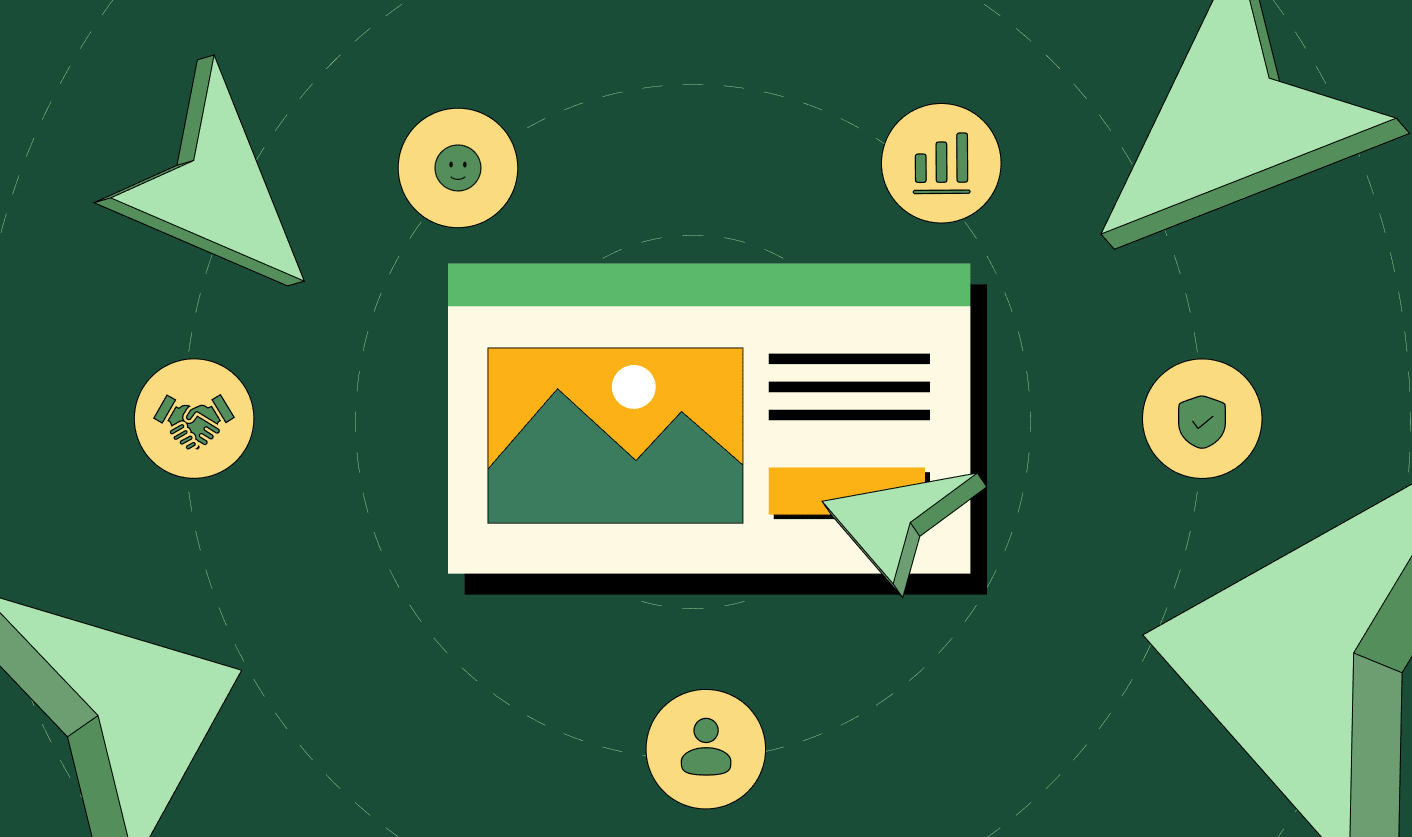
From Click to Customer: Proven Landing Page Conversion Optimization Techniques
You can buy clicks. You can’t buy conversions.
That’s the central tension of SaaS marketing today: teams pour budget into Google Ads, outbound, SEO, and social distribution, but then lose 90% of their visitors on the very first touchpoint: the landing page.
At ThunderClap, we’ve audited hundreds of SaaS landing pages and seen the same story. The landing page doesn’t accelerate interest into action; every campaign dollar leaks away. The difference between an okay landing page and a customer-producing landing page isn’t a prettier design. It’s a scripted sequence: give people a reason to care, remove their doubts, and make the next step effortless.
We call that sequence MAP (Motivate → Assure → Prompt). This blog post breaks each part open, gives exact sentences and structures you can copy, and hands you the small-but-powerful decisions that add up to big lifts.
TL;DR
- SaaS teams lose 90% of traffic at the landing page. Clicks are easy, conversions are hard.
- Generic landing page optimization strategies don’t work for SaaS: CTAs are heavier, buyers are cautious, and switching costs feel high.
- ThunderClap’s MAP framework (Motivate → Assure → Prompt) creates momentum that turns visitors into customers.
- Motivate with outcome-first headlines, Assure with layered proof, and Prompt with frictionless CTAs and short forms.
- ThunderClap has optimized 129+ websites, lifting conversions 40–50% by designing landing pages that act like your best salesperson.
Why generic landing page advice fails SaaS
Most “landing page optimization best practices” you’ll find online assume visitors arrive ready to act. But SaaS buyers aren’t impulse shoppers; they’re cautious, often in multi-stakeholder buying cycles.
We’ve worked on 129+ B2B websites like Amazon, Razorpay, and Factors. When we run CRO reviews before website revamps, three SaaS-specific challenges always surface:
- Commitment-heavy CTAs: Signing up for a trial or booking a demo involves effort and risk.
- Multiple decision-makers: End-users care about usability, while CFOs care about ROI and compliance.
- Perceived switching costs: Adopting new software feels like a big bet. Buyers worry about disruption, onboarding, and wasted time.
That’s why “move the CTA above the fold” won’t cut it. SaaS landing pages need deeper optimization strategies rooted in psychology, buyer journey alignment, and trust-building.
MAP framework for landing page conversion optimization: at a glance
Before diving in, let’s anchor on why we created MAP.
We saw clients struggle because their landing pages were designed in fragments: a headline from marketing, a form from sales, a testimonial tossed in by design. MAP forces coherence. It ensures every piece of the page is doing its job to build momentum: motivate visitors, assure them it’s safe to act, and prompt them clearly toward the next step.
MAP is the landing page optimization system for SaaS that works. It’s design + psychology + friction engineering.
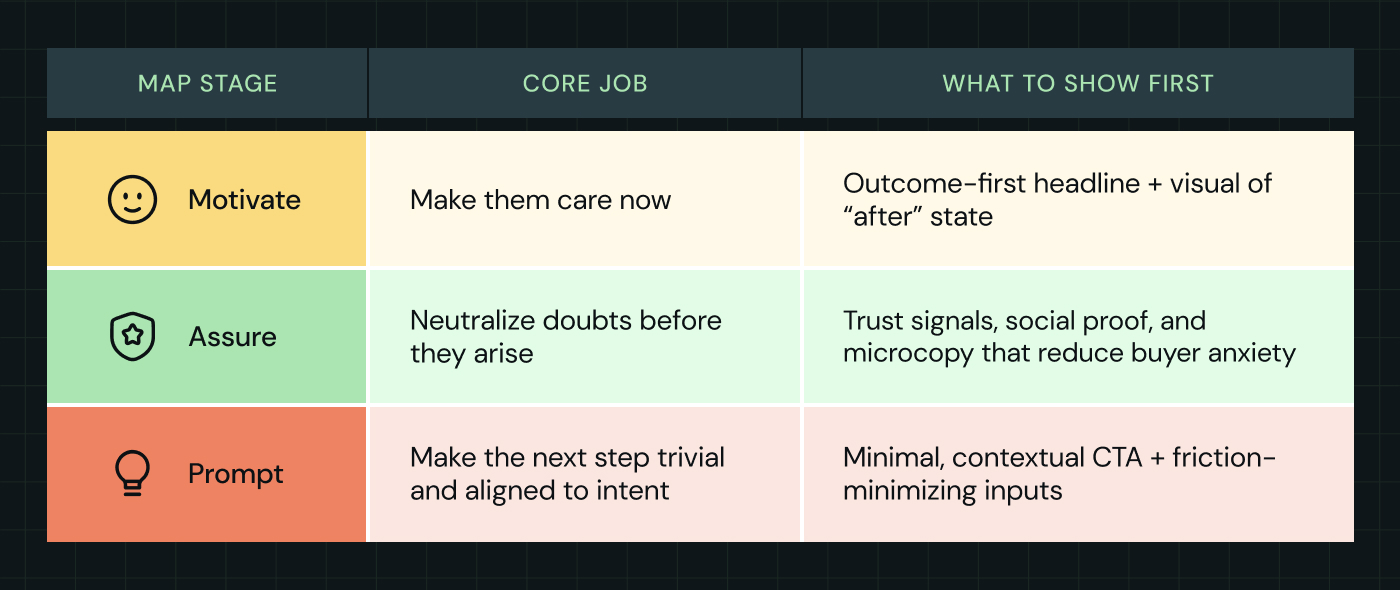
On a landing page, each stage should flow into the next. If Motivate is strong but Assure is weak, readers hesitate; if Assure is strong but Prompt is bad, momentum stalls.
Build all three, and you get conversion velocity.
Want to see MAP in action? When we revamped ConsultAdd’s homepage with these strategies, conversions jumped by 60%. Here’s a quick walkthrough of the before and after.
1. MOTIVATE — grab interest and create desire (do this well, and the rest is easier)
When we optimize SaaS landing pages, we start with the hero. If the hero doesn’t do its job in 3 seconds, the rest doesn’t matter. Motivate is the art of making an immediate, credible, emotional & rational case for action.
The job: make visitors say “this is for me” in under 3 seconds
Visitors usually arrive with a partial intent. They’re curious but not committed. Your hero section needs to close that tiny intent gap fast.
What high-performing motivation looks like
- Outcome-first headline (not product-first)
- Bad: AI-powered analytics platform
- Better: See campaign ROI in minutes — not days.
- Best (more specific): Cut reporting time by 70% and ship results in your first week.
- Bad: AI-powered analytics platform
- Why outcome-first? People buy results. Features justify later; results convert now.
- Single-sentence subhead that removes ambiguity
- Format: What it does + who it helps + one benefit.
- Example: Automated analytics for mid-market B2B marketers (no data science required).
- Format: What it does + who it helps + one benefit.
- Visuals that show the ‘after’ state
- A screenshot with real-looking data (annotated), or a short 15–25 second animated GIF of the product in action.
- Avoid hero imagery that’s purely abstract (people shaking hands, stock photos). Make the result visible.
- A screenshot with real-looking data (annotated), or a short 15–25 second animated GIF of the product in action.
- Small, high-confidence proof immediately visible
- A short line like “Trusted by 400+ marketing teams” or a single logo strip directly under the subhead. That’s not the full trust layer; it’s a signal the brain prefers.
- A short line like “Trusted by 400+ marketing teams” or a single logo strip directly under the subhead. That’s not the full trust layer; it’s a signal the brain prefers.
- Contextualized urgency (when appropriate)
- Not cheap FOMO. Real urgency tied to buyer benefit: “Get white-glove onboarding through July” or “Free automated migration for early adopters.”
- Not cheap FOMO. Real urgency tied to buyer benefit: “Get white-glove onboarding through July” or “Free automated migration for early adopters.”
Here’s an example of a SaaS brand doing this right:
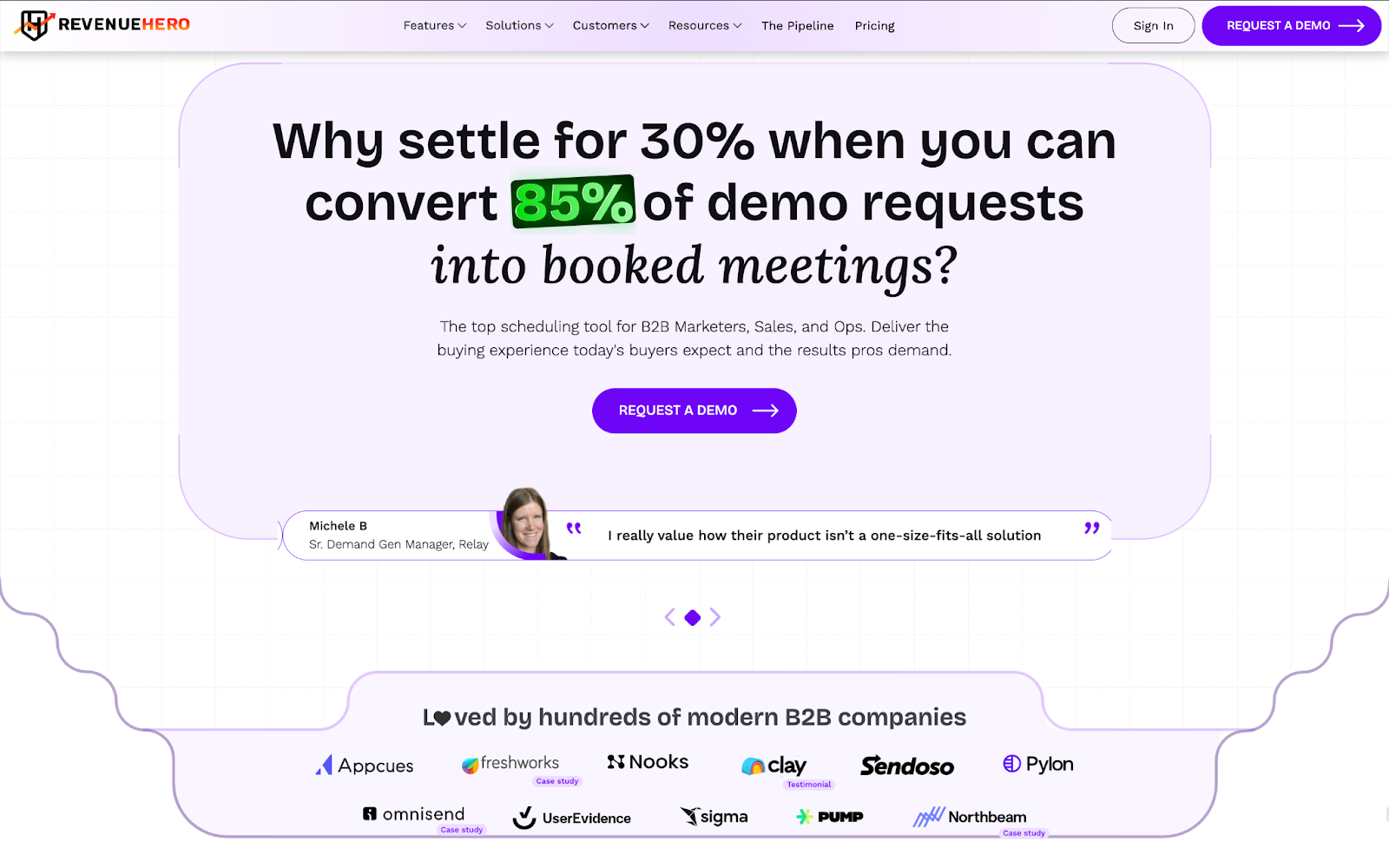
Micro play #1: Our tested headline recipes you can swipe
- [Outcome] + [timeframe] + [social proof hint]
- Automate monthly reports in 10 minutes — used by marketing teams at 200+ companies.
- Automate monthly reports in 10 minutes — used by marketing teams at 200+ companies.
- [Problem to avoid] + [solution]
- Stop losing deals to slow reporting — deliver weekly insights in one click.
- Stop losing deals to slow reporting — deliver weekly insights in one click.
- [Question that names the buyer]
- Are you a Growth Lead? Reduce your reporting backlog by 70%
- Are you a Growth Lead? Reduce your reporting backlog by 70%
Good design in CRO means guiding attention and making action feel effortless. With Zenda, we overhauled their design system to prioritize clarity and proof. The team loved the design, which also got nominated for Awwwards.
A quick UX audit often uncovers hidden blockers: CTAs buried too low, visuals that distract, or forms that feel heavier than they are. From a design and layout lens, put the CTA visually next to the value statement (don’t hide it below the fold). Use a single prominent visual region (screenshot or GIF). We know that the best headline is 8–12 words and the subhead is 12–18 words.
{{specficBlog}}
2. ASSURE — neutralize the buyer’s doubts before they arise
Even if your headline convinces, buyers will pause. Their internal checklist may include: Will this work for me? Is it secure? Will onboarding suck? How much will it cost?
Assure answers those questions proactively and precisely, not vaguely.
The job: turn “maybe” into “safe to try”
Assurance is not a single element. It’s an architecture. Those elements must be visible early and be contextually relevant to the CTA.
We used this firsthand when we worked with Storylane on their website revamp.
- Total conversions up 22%
- Conversions per user up 19%
The assurance stack (what to show, and where)
| Layer | Purpose | Ideal Placement |
|---|---|---|
| Social proof (logos) | “People like me use this.” | Immediately below the headline |
| Outcome testimonials (with metrics) | “It did this for them.” | Next to CTA or under hero section |
| Security & compliance badges | “This meets required standards.” | Sidebar for enterprise CTAs |
| Integrations & ecosystem | “It fits my stack.” | Under the trust block or near the CTA |
| UX microcopy (speed, credit-card info) | Removes setup anxiety | Next to form fields |
How to choose what to show first
- If you target SMBs: show outcome proof and quick-start promises (time-to-value).
- If you target enterprise: lead with compliance, uptime, and procurement-friendly links.
- If the CTA is a demo: show logos of recognizable customers and a short testimonial from someone in procurement or IT.
Also, add a one-line “what happens next” above the form: “We’ll email a 1-click setup link — you’re live in 5 minutes.”
Your pricing page is the most visited (and most overlooked) page on your site. We analyzed 50 SaaS pricing pages to create a proven blueprint, complete with insights, a wireframe, and a checklist that you can apply right away. Get the Pricing Page Blueprint.
Also read: 12 Effective Formats of Social Proof for Your B2B SaaS Website
The psychology: remove friction before it appears with micro copy
Buyers imagine worst-case scenarios automatically. If a visitor thinks “I’ll waste time,” your job is to whisper “You won’t.” If they think “This might be insecure,” you must show a credible security signal before they ask.
Three small, measurable tactics you can use today:
- Use a one-line “what happens next” statement above the form (e.g., “We’ll email a 1-click setup link — you’re live in 5 minutes.”)
- For demo CTAs, indicate time commitment (e.g., “Book a 15-minute walkthrough with a solutions engineer.”)
- If you collect sensitive fields, add a privacy microcopy (“We’ll never share your info.”)
Also read: 20 Proven SaaS Conversion Optimization Hacks to Boost Your Sales
3. PROMPT — make the next step irresistible and frictionless
This is where momentum either becomes a conversion or evaporates. The Prompt stage is about aligning the CTA with intent and reducing friction to the absolute minimum.
We use a simple rule here: ask for the least amount of commitment that still moves the deal forward.
Ask for too much and you lose; ask for too little and you waste everyone’s time. The golden rule: ask for the least that reliably moves someone forward.
Common SaaS CTA archetypes and how to design them
| CTA Type | Minimum Ask (Example) | Best Friction Pattern |
|---|---|---|
| Free Trial | Email + password (or OAuth) | One-click OAuth + 1-step onboarding |
| Demo | Email + calendar slot | Integrated calendar widget (no long forms) |
| Contact Sales | Name + email + company | Short form + optional “book time” button |
| Content / Gated Playbook | Email only | Inline modal with social sharing options |
| Upgrade (In-app) | Click to purchase + 1 confirmation | In-app modal with one-click payment |
One of the most commonly asked questions we receive on how to optimize landing pages is around form design. Here are a few design rules you can implement today:
- Fields: 3–4 fields for initial contact (Name, Work Email, Company, Role). If you must ask more, use progressive profiling later.
- Placeholders and labels: use explicit placeholders (not “Enter text”).
- Button copy > color: use benefit-oriented copy: “Start Free — No Card” or “Book 15-Min Demo”.
- Inline reassurance: place microcopy beneath the button: “No credit card. Cancel anytime.”
Mobile-first inputs: enable number and email keyboards where appropriate; keep taps large.
How to personalize landing pages without creeping out users
Personalization is powerful, but only if it feels relevant, not invasive. At ThunderClap, we run segment-level personalization, not “Hi [FirstName]” gimmicks. We have found the best ways to do this are:
- Firmographic swaps: SMB sees “Perfect for lean teams.” Enterprise sees “Enterprise-grade compliance and SSO.”
- Persona swaps: CFOs see “Calculate ROI” while developers see “See API docs.”
- Campaign-aware text: If the ad mentions HIPAA, the landing page headline references HIPAA compliance.
We tell clients to start with headline + CTA personalization for 2–3 top segments. That’s 80% of the gain with 20% of the complexity.
If you run demos, use ThunderClap’s High-Converting Demo Page Playbook. She studied 30 B2B SaaS brands to find landing page optimization strategies that leading brands are using on demo pages.
Inside the 39-page ebook, you'll find landing page optimization best practices, an editable wireframe you can use to create a high-converting demo page for your SaaS brand, and three ready-to-use prompts to craft a perfect headline for your demo landing page.
Common buyer objections and exact copy to reply with
Objection-handling isn’t just for sales calls. It is also a landing page optimization strategy. By surfacing answers at the exact decision moment (right beside your CTA), you remove friction before it turns into abandonment.
Here are the most common SaaS buyer objections, paired with microcopy ThunderClap has field-tested on client pages to keep momentum alive:
| Objection | Field-Tested ThunderClap Phrasing |
|---|---|
| “It will take too long to set up.” | “Get started in 5 minutes. Guided onboarding included — no IT required.” |
| “Is it secure?” | “SOC 2 Type II certified. Data encrypted at rest & in transit — see our Trust Center.” |
| “Will it integrate?” | “One-click sync with Slack, HubSpot, Snowflake.” |
| “What if it doesn’t work?” | “30-day money-back guarantee / Cancel anytime.” |
How ThunderClap uses MAP for landing page optimization for SaaS clients
We keep this short: when we implement MAP, we do small surgical changes first (headline, hero visual, CTA microcopy, trust row). Then we prioritize one structural change per conversion flow: replace long demo forms with scheduler widgets, swap 9-field trials to OAuth + email, and move testimonials under the CTA. The lessons above are the same ones we use at scale.
We love checklists because they force discipline. Before shipping any landing page, we apply two.
Copy & UX checklist to optimize landing pages for conversions

Ready to execute our MAP framework to optimize your landing pages for conversions?
The MAP framework we’ve unpacked here shows how SaaS landing pages can stop leaking visitors and start converting customers. You can take these ideas and run with them on your own. Or, if you’d rather move faster and go further, that’s where ThunderClap comes in.
Why ThunderClap? Three reasons set us apart:
- Proven track record in SaaS growth → We’ve optimized 129+ B2B websites and landing pages, partnering with companies like Amazon, Storylane, Factors, and roommaster. Our work consistently transforms static pages into conversion engines.
- Conversion-first methodology → We don’t just redesign. We build momentum architectures that lift demo signups, accelerate trials, and drive pipeline revenue. Many clients see a 40–50% increase in conversions within months.
- Scalable execution → Every project we deliver is built for growth — from Webflow implementations your marketers can own, to playbooks your sales and growth teams can iterate on.
Plenty of agencies can hand you a prettier landing page. ThunderClap hands you a landing page that becomes your most reliable salesperson.
If you’re ready to stop wasting clicks and start turning them into customers, book a consultation with ThunderClap today.
{{ctaBlock}}
FAQs
1. How do I optimize landing pages for conversions when my product has multiple buyer personas?
This is one of the biggest SaaS pain points. A CFO, an end-user, and an IT manager all evaluate your product differently. To optimize landing pages for conversions, personalize at the segment level. Swap headlines and CTAs by persona or firmographic data (e.g., “Calculate ROI” for CFOs, “See API Docs” for developers). This targeted approach is a core landing page optimization strategy that prevents “one-size-fits-all” pages.
2. What landing page optimization strategies actually work if my team has limited design and dev resources?
SaaS marketers often don’t have the luxury of big redesigns. The good news: high-leverage landing page optimization for SaaS doesn’t require full rebuilds. Focus on microcopy around CTAs, place testimonials directly under forms, and integrate a demo scheduler instead of a long request form. These lightweight strategies can deliver a 30–40% conversion lift without major dev work.
3. What metrics should I track to measure the success of landing page optimization?
Many SaaS teams only look at form fills, but that misses the full picture. To measure landing page optimization success, track:
- Conversion Rate (CVR): % of visitors completing your CTA (trial, demo, signup).
- Qualified Conversion Rate: % of conversions that match your ICP.
- Bounce & Scroll Depth: Are visitors engaging or leaving too soon?
- CAC Payback & LTV Impact: Does optimized landing page traffic generate profitable customers?
4. What are the best tools to use for landing page optimization in SaaS?
The right tools make it easier to test and refine quickly without drowning in dev cycles. For SaaS landing page optimization, we recommend:
- Webflow or Unbounce: Build and iterate landing pages without heavy code.
- Hotjar or FullStory: See how visitors actually behave on the page.
Google Optimize or Optimizely: Run A/B tests on headlines, CTAs, and layouts.

How to Write Website Copy That Converts: A Step-by-Step Guide for 2025
Last week, I was auditing a B2B website for a revamp. The design was on point, but the copy? Totally missed the mark.
It looked just like any cookie-cutter template you can download online. Headlines were aspirational and meant nothing to the target audience. And worse? They were addressing the wrong ICP.
So why did this happen? Or how can you stop it from happening?
Here’s everything you need to know about writing high-converting website copy, including:
- What it is and why it matters
- Its key components
- A 6-step process for high-converting copy
- Ready-to-use templates for B2B webpages
- 3 copywriting tips for the best results
What is website copy?
Website copy is the written content on your website that informs visitors about your product/service while compelling them to take a desired action. The desired actions for B2B buyers usually include signing up for a demo or free trial, downloading a resource, registering for a webinar, sharing their details, or making a purchase.
What are the major components of a website copy?
A high-converting B2B website copy includes 8 major components:
1. Headlines
Headlines are eye-catching texts that persuade potential buyers to keep reading. It should communicate what your product does to your target audience in simple words.
Example

2. Subheaders
Subheaders are supporting statements to headlines that help buyers easily grasp the core message.
Example

3. Body Copy
Body copy is where you deep-dive into your offering, covering everything from pain points and features to benefits and outcomes.
Example
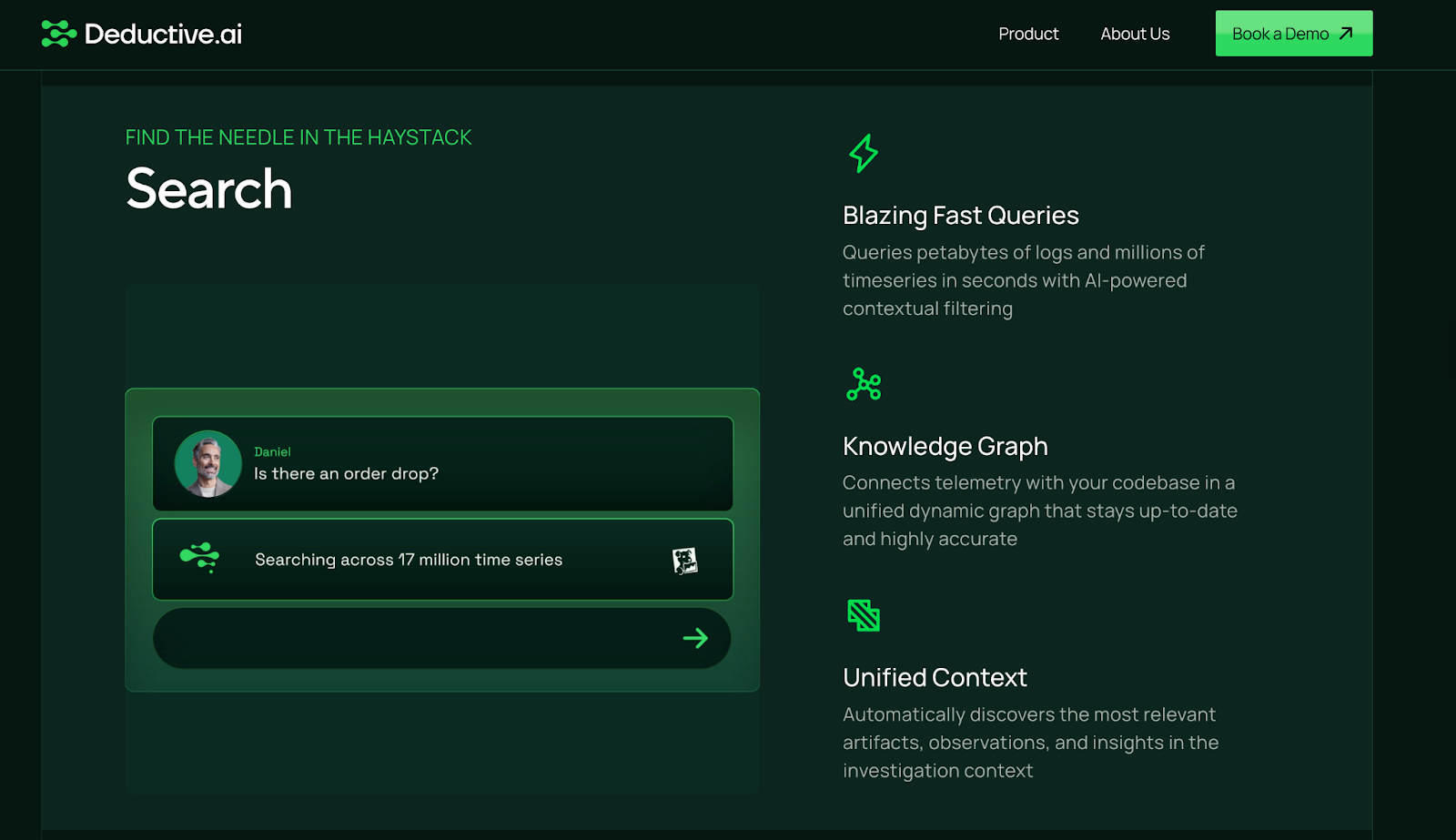
4. Value Proposition
Value proposition statement explains the ‘What’s In It For Me’ (WIIFT) to your target audience.
Example

5. Transformational Cues
Transformational cues are a type of conversion cue that highlights the transformation or change your product brings.
Example

6. Social Proof
Social proof in the form of trust badges, testimonials and logos gives potential buyers enough confidence to jump on the bandwagon.
Example

7. Call to actions
Call to actions, when placed at strategic locations, are what drive buyers to take the desired action.
Example

8. Microcopy
Microcopy refers to short texts that guide users through a website, giving them a seamless user experience.
Example

Why do you need a high-converting website copy?
Short answer? Because a website is the most important touchpoint for your buyers. They look at your website to figure out whether they should keep reading, trust you or even buy from you.
Studies report that they read headlines and skim through the website copy to determine this. For them, weak copy, poor grammar and spelling errors are solid reasons to stay away from a brand.
On top of that, a high-converting website copy:
- Makes your product memorable: When your website copy speaks the language of your target audience, it strikes a chord with them. This helps solidify your brand identity and make your product unforgettable.
- Boosts conversions: Only great copy can inform buyers about your product and persuade them to trial, demo or sign up for it. In other words, when the copy clicks, buyers take the right action without any hesitation.
- Complements your web design: A great web design catches eyes, but only the right words have the power to turn casual visitors into buyers. It is the copy that convinces and guides buyers towards action.
{{specficBlog}}
6-step process to write high-converting website copy
Here are the 6 steps you should follow to write high-converting copy for B2B websites:
1. Know your audience
You need to know your ICPs inside out to speak to them in their own language. And to truly find the voice of your customers, you should look beyond their demographics, interview them and collect intel about the:
- Triggers that made them look for a solution
- Pain points they are looking to solve
- Objections that stop them from putting pen to paper
- Wow factors that made them choose you over your competitors
- Direct outcomes your product helped them achieve
- Secondary outcomes that came as part of the package
- Stakeholders involved in the decision-making process
- Language they used to explain the impact the product makes in their daily workflow
2. Map out your customer’s journey
Once you define your ICP profiles, it is time to map out their customer journeys to understand when and where they interact with your brand. Each persona prefers different routes, from websites and blogs to pricing and demo request pages, as they move from awareness to decision making.
Skipping this step can result in a disconnect between buyer expectations and your offer. A classic example is using a headline like ‘[Product] for [Personas]’ on the homepage when multiple ICPs are involved.
Another example is writing website copy for decision-makers instead of end users. Decision-makers often rely on end users to champion a product rather than evaluating it themselves.
Here’s a good customer journey mapping template from HubSpot to start with:
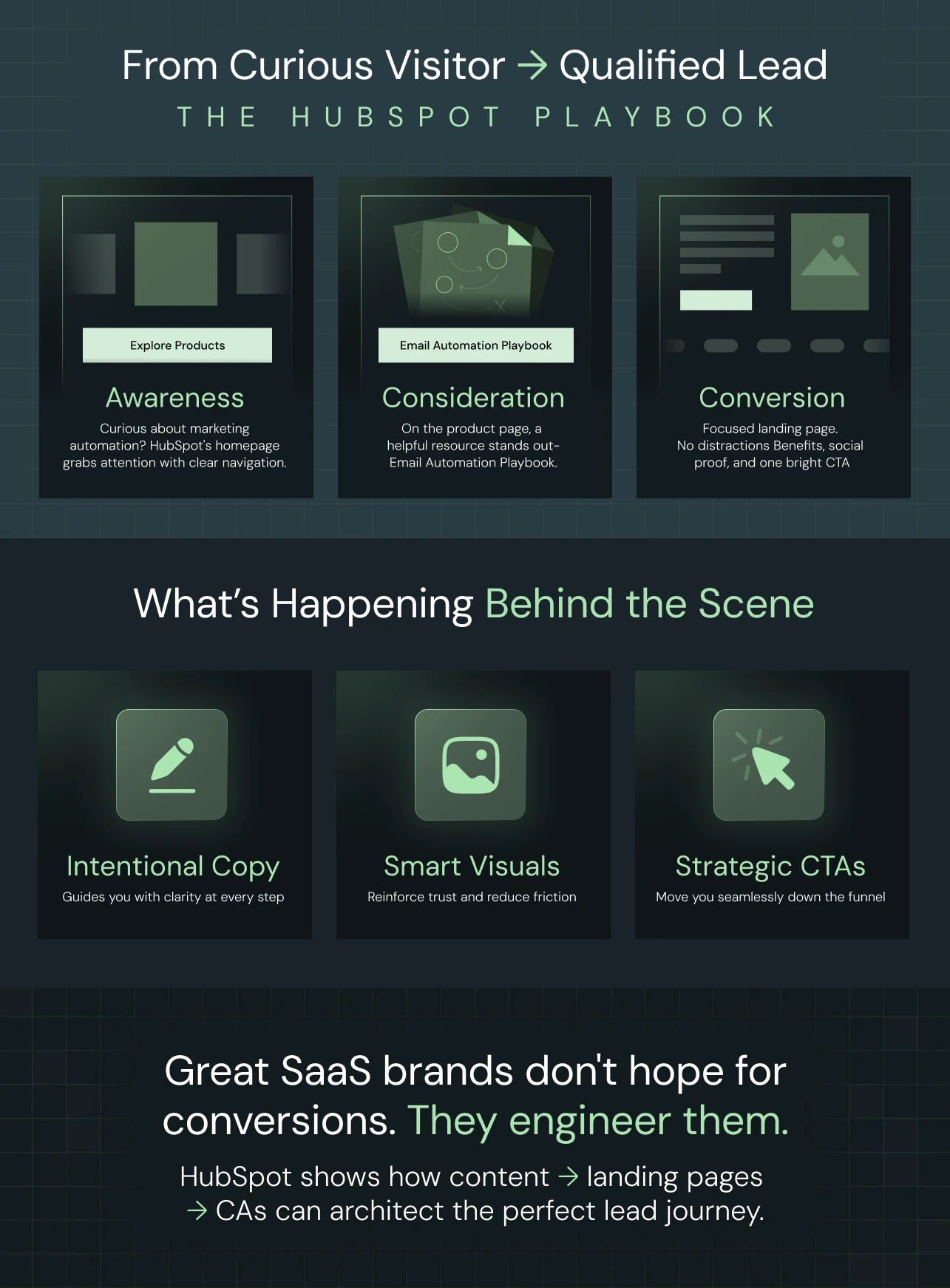
3. Define your brand personality
Your brand personality is a sum total of your brand archetype and brand voice. Brand archetype determines ‘who you are’ and the brand voice decides ‘how you talk’. A unique brand personality resonates with your mission and audience while setting you apart from your competitors.
To build this personality, start by choosing an archetype from the 12 Jungian archetypes that best aligns with your brand and audience.
These 12 archetypes, each representing a universal character trait, include: the caregiver, the creator, the everybody, the explorer, the hero, the innocent, the jester, the lover, the magician, the rebel, the sage, and the sovereign.
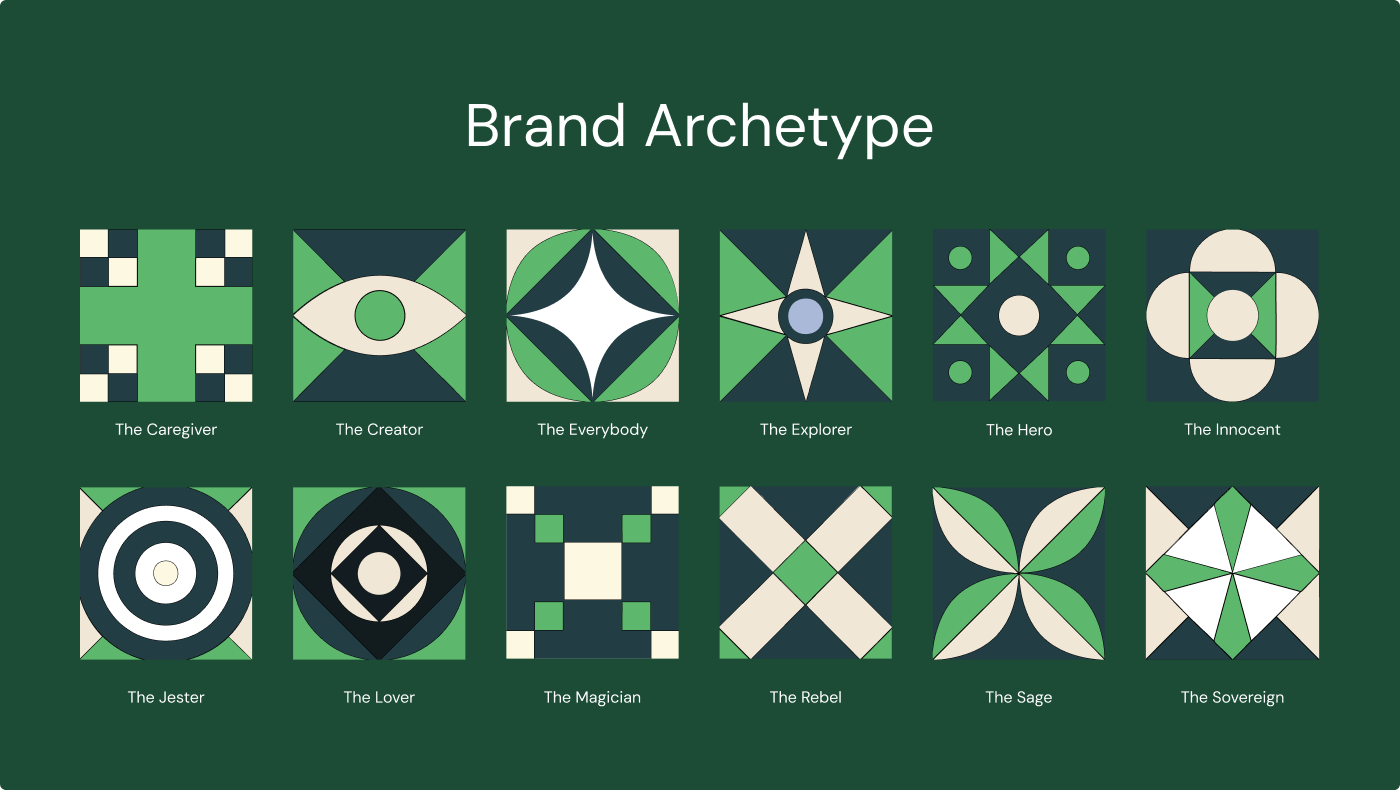
Next, pick a brand voice: playful, authoritative, conversational, motivational, bold, empathetic and casual, and create a brand voice style guide. Include dos and don’ts, examples and a list of words and phrases that can be used across your copy.
Here’s an example of dos and don’ts from a brand voice guide:

Source: Shopify
4. Figure out your value proposition
A value proposition statement communicates two things: the results your product delivers and what sets you apart from competitors. And it can differ across primary, prospect, product, and process levels.
Example
Here’s how Storylane’s value proposition differs across multiple web pages:
| Type of Value Proposition | Location | Example |
|---|---|---|
| Primary level: big promise | Homepage | Create interactive demos in 2 minutes. |
| Prospect-level: for different audience segments | Solutions page / sales | Accelerate your sales cycles with leave-behind demos. |
| Product-level: related to features and benefits | Product page / Lily |
Simplify buying with Lily sales agent. Let Lily handle discovery, objections and qualification so your team can close more. |
One of the easiest ways to define your value proposition after understanding your audience and product is through competitor analysis. This helps uncover gaps in competitors’ messaging and craft a unique, compelling value proposition.
5. Identify the goal of the website copy
The desired action from your buyers varies across different webpages. For example, homepage copy aims to build credibility and guide users to product pages, while demo request page copy focuses on getting buyers to book a demo.
Uncovering the ‘why’ behind each web page helps you:
- Map out messaging hierarchy: Figure out the key information buyers are looking for on each page and add it in order of relevance.
- Finalize call-to-action placements: Find appropriate CTAs for each page and add them at strategic locations, including above the fold and after key sections.
- Tailor copy for intent: Review each page’s goal and write a copy that matches the buyer’s intent. For example, use the homepage to educate, product pages to persuade, and conversion pages to prompt action. This ensures users are guided smoothly toward the desired outcome.
6. Write, test, refine, repeat
Use all the insights from steps 1–5 to write your first draft. Include relevant keywords to make your copy SEO-optimized.
But don’t stop there, test it out: A/B test variations of headlines, CTAs, conversion cues, and layouts to identify the best-performing options. Refine and tweak your messaging if it doesn’t hit the mark.
Repeat these steps whenever conversions drop, a new feature or product is added, or your brand evolves.
3 ready-to-use B2B webpage templates to boost conversions
1. B2B Product Page Template
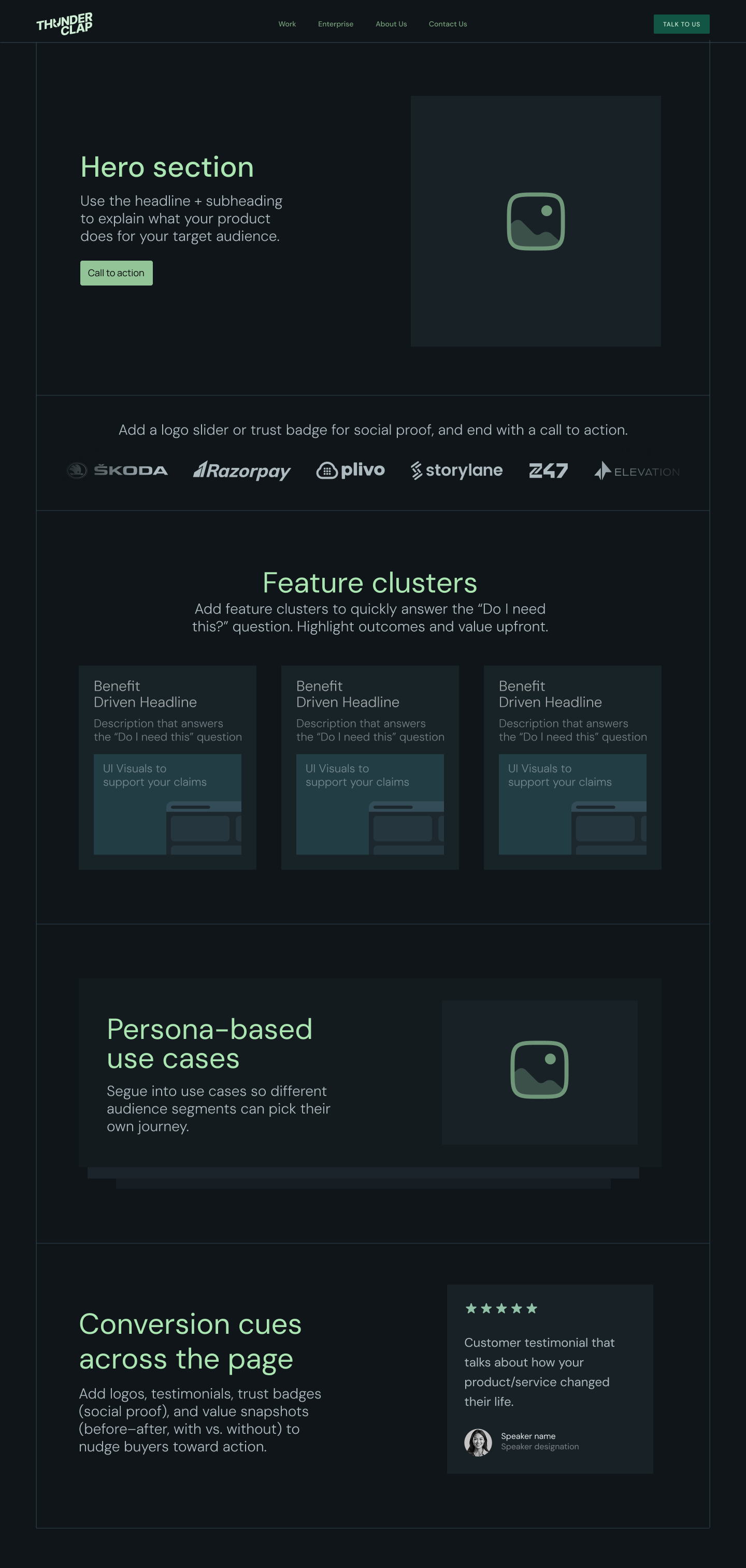
Sections to include:
1. Hero section: Use the headline + subheading to explain what your product does for your target audience. Add a logo slider or trust badge for social proof, and end with a call to action.
2. Feature clusters: Add feature clusters to quickly answer the “Do I need this?” question. Highlight outcomes and value upfront.
3. Persona-based use cases: Segue into use cases so different audience segments can pick their own journey.
4. Conversion cues across the page: Add logos, testimonials, trust badges (social proof), and value snapshots (before–after, with vs. without) to nudge buyers toward action.
Example: Storylane’s product page
2. B2B pricing page

Sections to include:
- Value-driven hero section: Use the headline + subheading to answer the “What am I looking at and why should I care?” question.
- Pricing table: Let buyers toggle between annual/monthly plans (show annual by default). Under each tier, include the price, key features, and a CTA like “Start Free Trial” or “Buy Now.”
- Feature-comparison table: Compare features included in each tier to give buyers a clear idea of what they’re getting.
- Interactive estimator (optional): Add an estimator if pricing is usage-based to help buyers model their cost.
- Social proof: Add logo sliders, trust badges, and testimonials that highlight functional and quantifiable benefits.
- FAQs: Use this section to address common objections related to pricing.
Example: Coda.io’s pricing page
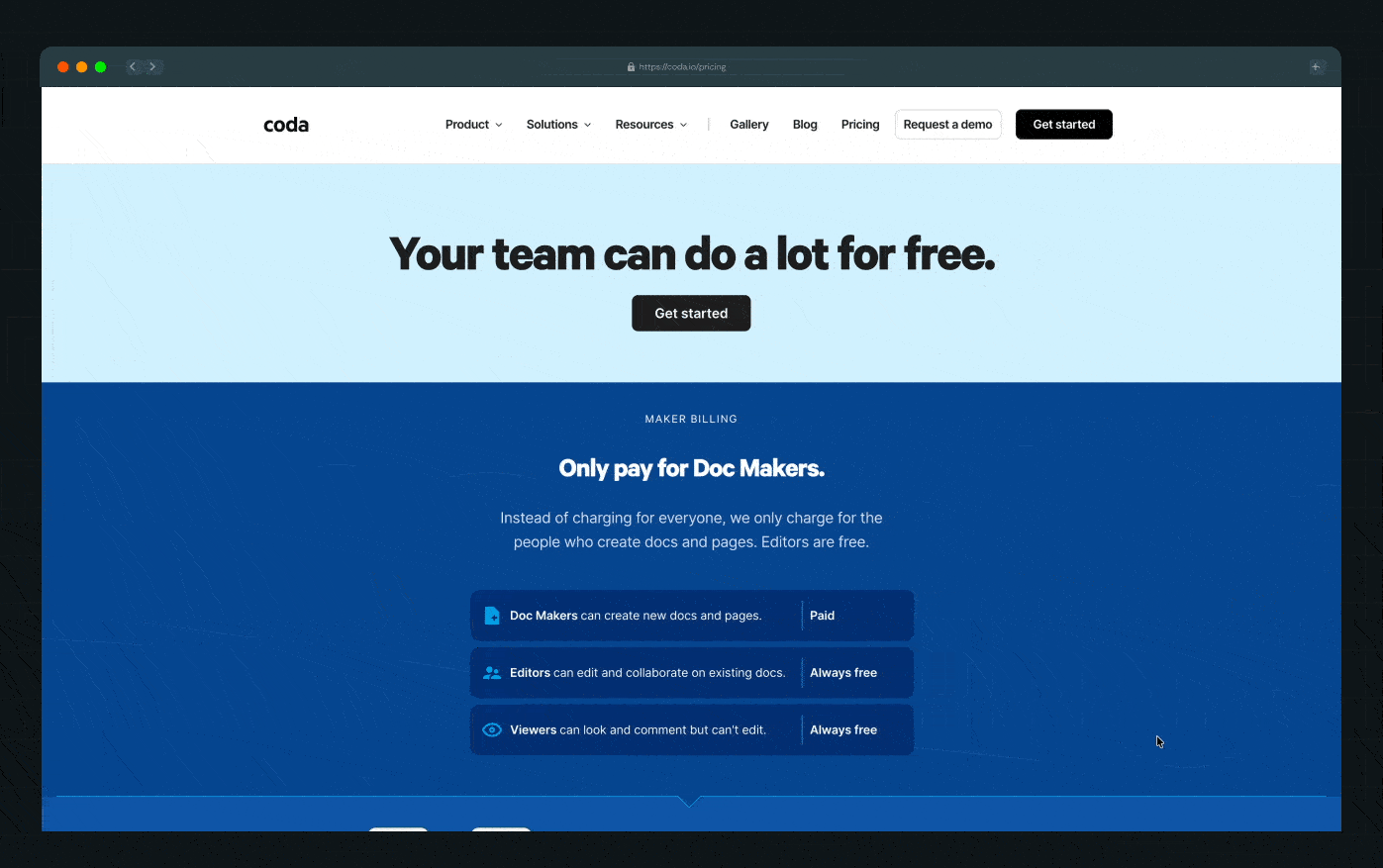
3. B2B demo request page

Sections to include:
1. Result-driven headline: Highlight the key reason customers choose you. Use numbers to increase impact.
2. Benefit-driven subheadline: Add functional and quantifiable benefits to support the claims made in the headline.
3. Social proof: Use testimonials and customer logos to reinforce the impact your product delivers.
4. Demo request form: Keep form fields under five and ask only for essential details to reduce friction.
Example: ThunderClap’s demo request page
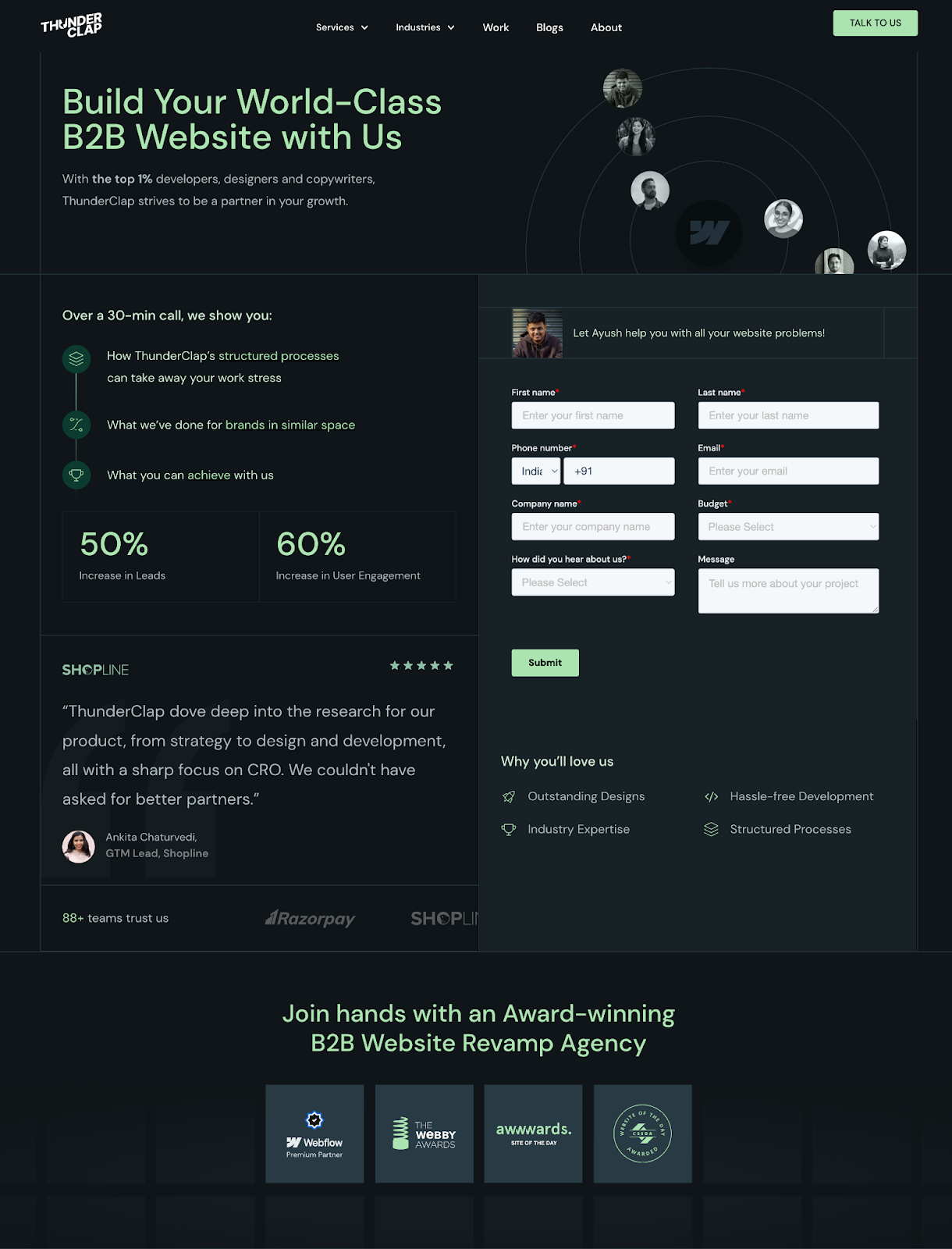
3 things to keep in mind while writing website copy
Knowing your audience doesn’t automatically result in great copy. These days, a lot of brands make a conscious effort to ‘know your audience,’ but only a few successfully communicate their offering in a language the audience understands.
“Somewhere between the positioning decks, one-pagers, product launches, copy variations, the meaning gets lost”, says Diane Wiredu, messaging strategist and founder of Lion Words.
So, how can you ensure your messaging doesn’t get lost in translation?
Meet your target audience at their awareness level
Your audience’s awareness level (problem, solution or product aware) is linked to your product category and their market familiarity. Find this early on and write for those belonging to that ‘specific awareness level’.
Example
Asana, a project management tool, caters to a solution-aware audience who wants to know how it stacks against competitors.

Here, the copy and the CTA focus more on ‘solving the problem’ rather than the product.
Slack, a popular collaboration tool, on the other hand, caters to a product-aware audience who is curious to uncover the ‘What’s In It For Me’s (WIIFT).

Here, the focus is on the product and the difference it makes.
{{specficService}}
Don’t always jump to the ‘how’ before ‘what’
This is the quickest way to make buyers bounce unless you are category leaders or catering to a product-aware audience. When you delve deep into the product features with screenshots and visuals, you overwhelm problem-aware or solution-aware buyers.
Instead, follow a logical hierarchy, starting from the what and why before explaining the how part. In other words, talking to pain points before offering a solution helps them feel more seen and heard.
Example
Pipedrive’s homepage is an excellent example of the ‘what → why → how’ logical flow. The hero section states what the product does, testimonials paired with benefits explain the why, and the final detailed features section focuses on the how. It also addresses two audience segments, solution-aware users (who have used CRMs) and product-aware users (who haven’t), educating each without overwhelming or boring them.
Not all benefits matter to your audience
Not every benefit makes your audience tick. Focusing on the wrong ones either turns into a boastful list of bells and whistles or the clichéd ‘time-money-effort saving’ white noise.
You can avoid this by using what Diane Wiredu calls the Goldilocks Rule. According to her the trick is to “find your sweet spot between technical jargon and generic fluff — where your message is specific enough to be relatable, but broad enough to connect to a tangible outcome your buyers care about.”
Example
Here’s an example from Wiredu’s LinkedIn post, where she explains the concept using the time-tracking software brand Toggl.
Notice how the messaging gets either jargony or vague as we move along the specificity spectrum. This means the key is to tap into the sweet spot between primary and secondary benefits, showing what your product does without listing features.

At ThunderClap, we use the CERTTN audit (Clarity, Explain, Resonate, Tie, Trust, Next Step) to ensure we put these principles into action. Asking these questions helps us spot messaging gaps costing conversions.

Final Thoughts: Can you use AI for website copywriting?
With AI reducing business operational costs by 30% and efficiency by 40%, there’s no reason to keep AI at bay. In fact, a recent study by Superside shows that using AI in copywriting delivers 30–40% efficiency gains.
But, if you plan to use it as a replacement for website copywriters, think twice. Doing this results in boilerplate website copy that may look good but fails to connect with buyers.
Wiredu’s recent experiment on using AI to write a B2B SaaS homepage captures this plight accurately. The copy she generates looks like actual B2B copy but is filled with generic, and lofty sections that are just placeholders.
However, the results are quite promising when you use AI as an ally while copywriting. The best use case to explain this would be how we use AI at ThunderClap for website copywriting. We integrate it into our workflow to automate repetitive tasks in the research, ideation and testing phase, so our copywriters can do what they do best - write compelling copy.
Want to know more about ThunderClap’s copywriting approach and the results we’ve delivered? Book a call with us today!
FAQs
1. What are the steps to write high-converting website copy?
Here are the steps you should follow to create high-converting website copy:
- Create ICP profiles and know their triggers, pains, results, and values.
- Map out their customer journey to ensure the website copy resonates with them.
- Finalize your brand personality by identifying your brand voice and archetype.
- Figure out your value proposition to stand out from competitors.
- Identify the goal of the webpage and ensure the copy aligns with this goal.
- Write, test, refine, and repeat for high conversions.
2. How to write copy for a service page?
Here are the steps to write copy for a service page:
- Value-driven hero section: Headline + subheadline + supporting visuals to convey the key value prop.
- Challenges section: Use this section to create a rapport with your audience by listing their pain points.
- Solutions section: List specific benefits to showcase your service as the answer to all their pain points.
- Social proof: Add necessary social proof in the form of testimonials, logos, and trust badges.
- Compelling CTAs: Add CTAs at strategic locations to drive conversions.
3. How to write copy for a homepage?
Here are the steps to write copy for a homepage:
- Value-driven hero section: Highlight the primary value proposition here. Add some social proof and CTA.
- Feature-cluster blurbs: Introduce the main feature clusters here. Use this real estate to drive buyers to respective product pages.
- Social proof: Add detailed testimonials and case studies that highlight functional and quantifiable benefits.
- Final CTA: Rehash the primary value proposition here as well.
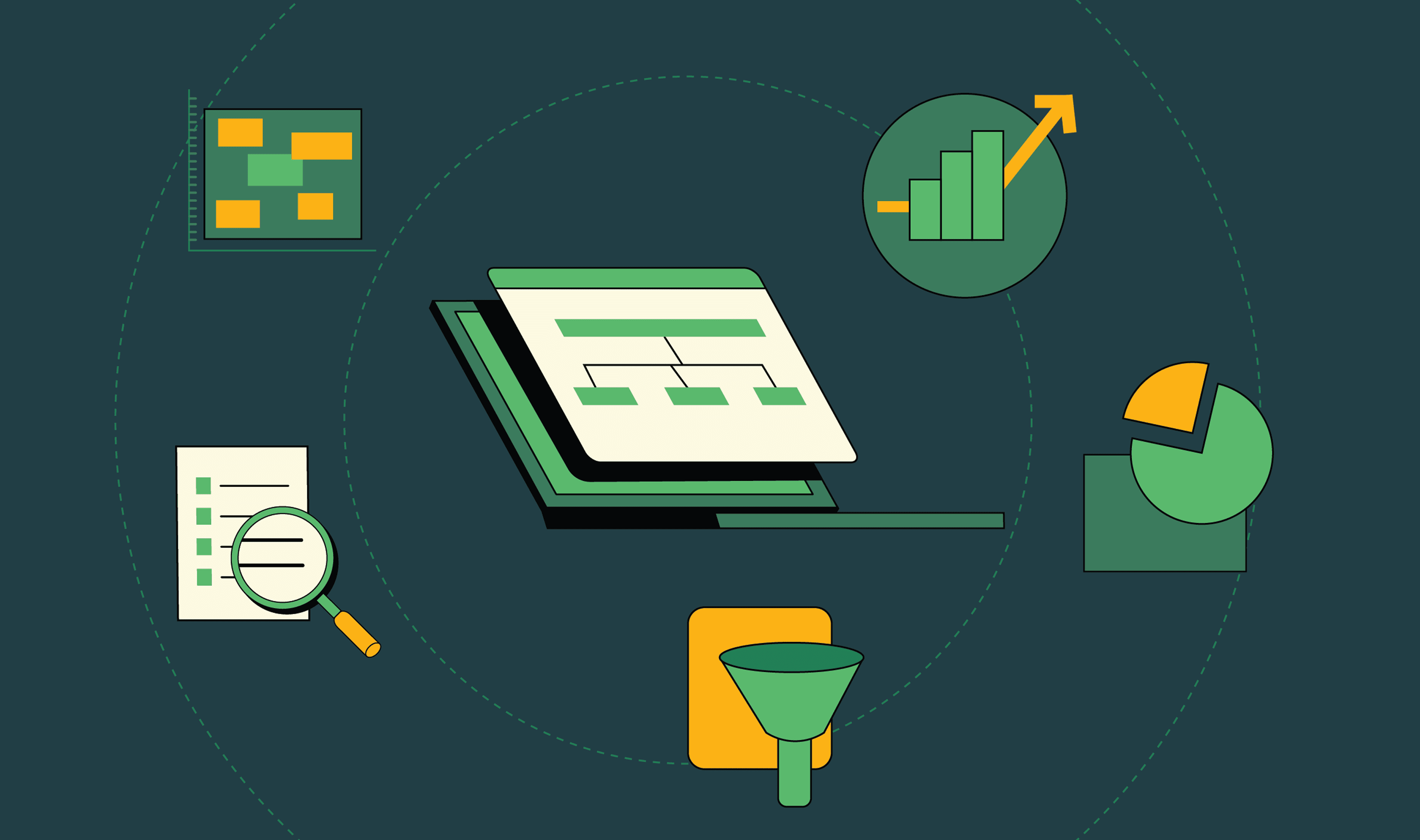
10 Top Website Analytics Tools for Measuring User Behaviour
You can redesign a landing page and feel great about it. Or you can redesign a page and prove it moves revenue. Successful SaaS website revamps are the latter: you diagnose friction with replays, quantify impact with event-driven analytics, and validate fixes with experiments.
The right website analytics stack provides you with the visibility (and proof) that your website revamp was successful.
In this guide, I’ll walk you through the 10 best website analytics tools that SaaS teams like yours can use right now. We will also discuss what each tool does best, new 2025 features, micro plays for each tool, and the right tech stack based on your needs.
How SaaS teams should choose website analytics tools (quick framework)
Despite the hype, the reality is that no single tool will give you the full picture. Which means the smarter move is to stack tools by layer, not try to force one tool to do it all.
At ThunderClap, we think of analytics as three complementary functional layers that need to work together:
- Numbers (quantitative): Tools in this layer capture hard data on traffic, funnels, retention, and activation. They give you the what at scale.
- Behavior (qualitative): These reveal how users actually interact with pages through replays, heatmaps, and feedback. They explain the why behind drop-offs or confusion.
- Experiments (validation): This layer lets you test and validate changes with real users before committing fully. It ensures design and messaging choices lead to measurable impact.
When choosing their website analytics stack, we advise our clients to align by Stage × Function × Integration need:
- Startup (0–$5M ARR): Keep it lean with a baseline quantitative tracker, one behavioral tool, and lightweight user feedback.
- Scale-up ($5M–$50M ARR): Add deeper product analytics, automated event capture, and controlled experimentation for CRO.
- Enterprise ($50M+ ARR): Expand to advanced analytics stacks with strong governance, server-side testing, and privacy-first hosting (especially for EU compliance).
At ThunderClaps, this is how we run every revamp audit: start with baseline tracking, map ICP journeys through both numbers and behavior, and then design experiments that prove uplift before rolling changes live. It’s this data-first, validation-driven approach that helps us consistently deliver measurable conversion lifts for our clients.
You need one tool for numbers, one for behavior, and one for experiments when you have traffic to support valid tests. Anything beyond that should be justified by a clear ROI — not just curiosity or tool sprawl.
Top website analytics tools in 2025: Side-by-side comparison
For the skimmers, here’s the comparison table so you can see how the top website analytics tools stack up before the deep dive.
| Tool | Best For | Key 2025 Features | Notable Integrations | Pricing Band | Limitations (SaaS Revamp Lens) |
|---|---|---|---|---|---|
| Google Analytics 4 (GA4) | Mid-market & enterprise SaaS with event maturity | Report annotations, Consent Mode V2, “Time to First Action,” Reddit Ads cost import | BigQuery, Looker Studio, GTM, Google/Reddit Ads | Free (up to ~100M events/yr); GA360 enterprise (custom) | Steep learning curve; needs disciplined event design |
| Google Search Console (GSC) | SaaS startups revamping SEO funnels | Insights tab tying search queries → engagement; improved trend tracking, CTR/engagement data | Native GA4 link | Always free | Purely SEO; no behavior analytics |
| Microsoft Clarity | Startups & mid-market SaaS needing UX diagnosis | Unlimited replays, AI traffic grouping, replay annotations, frustration detection | GA4, API-based | Always free (no session caps) | Limited KPI/quant analytics compared to paid tools |
| Hotjar | Growth & UX teams running targeted CRO experiments | AI summaries of survey/poll responses; heatmaps, replays, polls, Slack/HubSpot/Jira support | Slack, HubSpot, Jira, CRM stack | Free (35 sessions/day); Plus $39/mo, Business $99/mo, Scale $213/mo | Session caps; scales expensive with traffic |
| VWO | Mid-market SaaS scaling CRO | AI Copilot for variation creation, automation triggers, mobile app funnels & tap heatmaps | GA4, Mixpanel, Heap, HubSpot, Salesforce, Segment | Free Starter; Paid: Growth, Pro, Enterprise (varies by usage/product mix) | Mobile testing limited; advanced features locked to higher tiers |
| Optimizely | Enterprise SaaS with dev/eng resources | AI agents for campaign briefs, Opal AI assistant, GEO-ready CMS, feature flags | Enterprise CMS, data warehouses, personalization APIs | Enterprise only, fully custom | Costly; overkill for smaller SaaS |
| Mixpanel | PLG SaaS startups & scale-ups | AI query tool (MCP), Metric Trees, Experimentation 2.0, expanded session replays, heatmaps | Segment, CDPs, Snowflake/BigQuery/Databricks | Free (1M events/mo); Paid: Growth $0.28/1k events, Enterprise custom | Complex setup; manual event tracking; not built for attribution |
| Lucky Orange | SaaS needing UX analytics + live engagement | Lucky Orange Discovery AI (auto “optimization opportunities”), chat + polls integration | HubSpot, GA, Zapier | Free (100 sessions); Paid: Build $39/mo, Grow $89/mo, Expand $229/mo, Scale $899/mo, Enterprise custom | Busy UI; pricing rises steeply with scale |
| Matomo | SaaS in compliance-heavy industries (EU, gov, health) | Redesigned dashboard, Total Hits metric, stronger password/token controls, improved Tag Mgr | WordPress, GA4 import, APIs | On-premise free; Cloud from $23/mo, Enterprise custom | UI less polished; self-hosting requires maintenance |
| Kissmetrics | SaaS teams needing revenue-linked analytics | CRM/billing integrations, redesigned funnels, warehouse sync, advanced cohort/churn reports | CRMs, billing systems, warehouses | Bronze $25.99/mo (10k events); Silver $299/mo (2M events); Enterprise custom | Setup complexity; steeper learning curve for advanced reports |
{{specficBlog}}
The 10 top website analytics tools in 2025 (and how to use them)
Before we jump into the details, here’s how we approached this guide: we looked at what’s new in 2025, how each tool supports a website revamp, and where it delivers the most ROI. Each profile is a quick buyer’s guide plus a practical play you can use right away.
1. Google Analytics 4 (GA4)

If you’re running a SaaS website in 2025, GA4 is the foundation. It’s not perfect (and yes, it’s more complex than old Universal Analytics), but it gives you the broadest view of acquisition and funnels.
Say you’ve just revamped your pricing page. Traffic looks good, but conversions? Flat. With GA4, you pull a funnel: pricing_view → trial_start → trial_activate. You see, the drop is at trial activation, not pricing. Your problem isn’t design (it’s onboarding).
What’s new in Google Analytics 4 (GA4) in 2025?
This year, GA4 added features that actually make life easier: report annotations, scheduled dashboards sent straight to your inbox, Consent Mode V2 for privacy compliance, and extra ad-cost imports (e.g., Reddit Ads).
Our favorite is “Time to First Action”, a metric that shows how quickly signups actually start using your product.
GA4 Best-fit ICP: Mid-market and enterprise SaaS with event tracking maturity
Google Analytics 4 (GA4) pricing
- Free plan: covers most SaaS teams up to ~100M events/year
- GA360 plan: enterprise-grade, custom pricing; useful above $50M ARR for SLAs and cross-org rollout
Google Analytics 4 (GA4) Pros
- Deep integration with the Google stack
- Strong ML/predictive features
- Direct BigQuery export for custom modeling
Google Analytics 4 (GA4) Cons
- Steeper learning curve than UA
- Requires disciplined event taxonomy and engineering support for clean data
📊 GA4 Micro-Play: Track trial_start → trial_activate → paid_conversion. Send to BigQuery and run cohort reports on D30 conversion.
🎯 KPI to track: Trial-to-paid conversion by acquisition source.
2. Google Search Console (GSC)

GSC is Google’s free SEO analytics tool that helps SaaS teams decide which pages deserve a facelift. It shows key metrics like impressions, clicks, CTR, and average position (so you know what’s visible but underperforming). For example, if “best project management SaaS” gets 10k impressions but only a 3% CTR, the page is ranking but not attracting clicks.
That’s a clear signal it’s a revamp priority (tweak headlines, images, or page content to better match search intent).
What’s new in Google Search Console (GSC) in 2025?
GSC remains the canonical source for search performance. In 2025, the new Insights tab ties search queries directly to engagement metrics. Finally, you can tell if your “#3 keyword ranking” is sending buyers… or bounce-happy tire kickers.
We also love query-level CTRs, impressions, and engaged session metrics. They have improved on visual trend tracking and milestone messaging too.
GSC Best-fit ICP: SaaS startups revamping SEO-driven content funnels
Google Search Console (GSC) pricing
- Always free
Google Search Console (GSC) Pros
- Detailed search query insights
- Tracks index coverage + Core Web Vitals
- Connects queries to engagement signals
Google Search Console (GSC) Cons
- Not a substitute for behavioral analytics; pairs best with GA4
📈 GSC Micro-Play: Create a revamp priority list from pages with >5k impressions and <3% CTR. Start there.
🎯 KPI to track: CTR and average position for your top 20 queries.
3. Microsoft Clarity

If GA4 tells you what happened, Microsoft Clarity shows you how. This free website analytics tool offers unlimited replays and heatmaps, which are ideal for identifying UX friction during and after a revamp.
Say, during your website revamp, you launch a new signup form. Conversion drops. Instead of guessing, you watch 20 recordings — and notice users rage-clicking the “Next” button. Turns out the form had a hidden error.
And it’s 100% free, with no traffic caps.
What’s new in Microsoft Clarity in 2025?
The 2025 updates are built for teams: AI now groups traffic channels (yes, even AI search traffic), and you can add annotations to session replays. Now, when you launch “new signup flow v2,” your team knows exactly when the change happened. You can also use Copilot to get AI-generated summaries to effortlessly condense hours of session recordings and heatmaps into actionable insights.
Microsoft Clarity Best-fit ICP: Startups and mid-market SaaS needing UX diagnosis at scale
Microsoft Clarity pricing
- Always free (no session caps)
Microsoft Clarity Pros
- Unlimited replays
- Super easy setup
- AI frustration detection
Microsoft Clarity Cons
- Less advanced KPI analytics than paid platforms
- Doesn't capture all user sessions. Sometimes heatmaps don't have the entire screenshot, so you can't make judgments about user behaviour accurately.
🖥️ Microsoft Clarity Micro-Play: Auto-flag sessions with signup_start but no signup_complete. Review 30 per week; feed into UX backlog.
🎯 KPI to track: Decrease in rage-click and drop-off incidents at signup.
4. Hotjar

Numbers show what. Replays show how.
Hotjar answers the why. Hotjar blends behavioral analytics with user feedback. It is our go-to for surveys, polls, and heatmaps. We use it religiously for SaaS revamps because it reveals both what happened and why. It is your hack to enable targeted CRO on high-value SaaS pages (pricing, onboarding).
What’s new in Hotjar in 2025?
In 2025, Hotjar goes beyond heatmaps, replays, and polls with AI summaries that cluster user feedback into themes. Translation: you get the top three user blockers without wading through hundreds of survey responses.
We also love their Slack, Jira, HubSpot, and CRM integrations.
Hotjar Best-fit ICP: Growth and UX teams running targeted experiments on pricing, onboarding, and CTAs
Hotjar pricing
- Free plan: track up to 35 daily sessions
- Plus plan (up to 100 daily sessions): $39/month
- Business plan (up to 500 daily sessions): $99/month
- Scale plan (above 500 daily sessions): $213/month
Hotjar Pros
- Fast feedback capture
- Built-in polling and heatmaps
- AI summarization helps prioritize
Hotjar Cons
- Recording/response caps on free plans
- Costs rise substantially with traffic
📊 Hotjar Micro-Play: Exit poll on pricing page: “What stopped you from starting a trial?” Summarize with AI → fix top 2 blockers.
🎯 KPI to track: Trial starts from the pricing page.
5. VWO

How many times have you launched a redesign, shipped it, and prayed it would perform better? With VWO, you don’t have to pray. You can test before going all in.
VWO is a comprehensive experimentation and conversion rate optimization (CRO) platform. That provides the controlled testing environment needed to validate changes before rolling them out.
The business value is also in improving trial-to-paid funnels with targeted CRO experiments. You can track the ROI of experiments, making growth decisions data-driven.
What’s new in VWO in 2025?
In the 2025 feature rollout, we love the AI-powered VWO Copilot for automated variation creation, as well as time-based and metric-based automation for safer deployments. You will also like its mobile app optimization features, including app funnels and heatmap tap filters.
VWO always had integrations with GA4, Mixpanel, Heap, HubSpot, Salesforce, and Segment. Recent updates also include platforms like Microsoft Clarity and Firebase Crashlytics, and a new, more intuitive campaign creation flow to streamline testing.
💡 Pro Tip: Start simple: headlines, CTAs, button color. Don’t dive into multivariate madness until you’ve nailed the basics. Always tie experiments back to ROI!
VWO Best-fit ICP: Mid-market SaaS scaling CRO
VWO pricing
- Free starter plan with unlimited experimentation
- Also available in Growth, Pro, and Enterprise plans (pricing based on product mix)
VWO Pros
- No-code editor
- AI-driven optimization ideas
- AI for content (generate survey questions and even create different copy variations for A/B testing) & analysis (summarize qualitative feedback)
- ROI tracking
VWO Cons
- Higher-tier features require paid plans
🧪 VWO Micro-Play: A/B test CTA copy: “Start free trial” vs. “Start free trial. No credit card.”
🎯 KPI to track: Conversion lift and 14-day retention for experiment cohorts.
6. Optimizely

If you’re an enterprise SaaS with engineering muscle, Optimizely is your friend. It is built for engineering-led experimentation. Think feature flags, server-side tests, and ML-powered traffic allocation.
What’s new in Optimizely in 2025?
In 2025, Optimizely is going all-in on AI to make experimentation and marketing workflows faster and smarter. Instead of manually setting up every test or campaign, you can now drag-and-drop AI agents that handle tasks like campaign briefs, keyword research, or experiment plans. The new Opal AI assistant lives inside the platform, helping teams summarize test results or even generate on-brand visuals on the fly. Optimizely’s CMS is also GEO-ready.
Optimizely Best-fit ICP: Large SaaS with engineering teams and complex systems
Optimizely pricing
- Enterprise only; custom pricing based on traffic and scale
Optimizely Pros
- Server-side and client-side experimentation
- ML-powered traffic allocation
- Advanced feature flagging and progressive rollouts
- Personalization based on user segments
- Enterprise-grade integrations
Optimizely Cons
- Costly and complex to implement
- Overkill for small teams.
⚡ Optimizely Micro-Play: Roll out a new onboarding flow to 10% of users with feature flags; measure activation and rollback if needed.
🎯 KPI to track: Activation lift and regression rate in control vs. variant.
7. Mixpanel
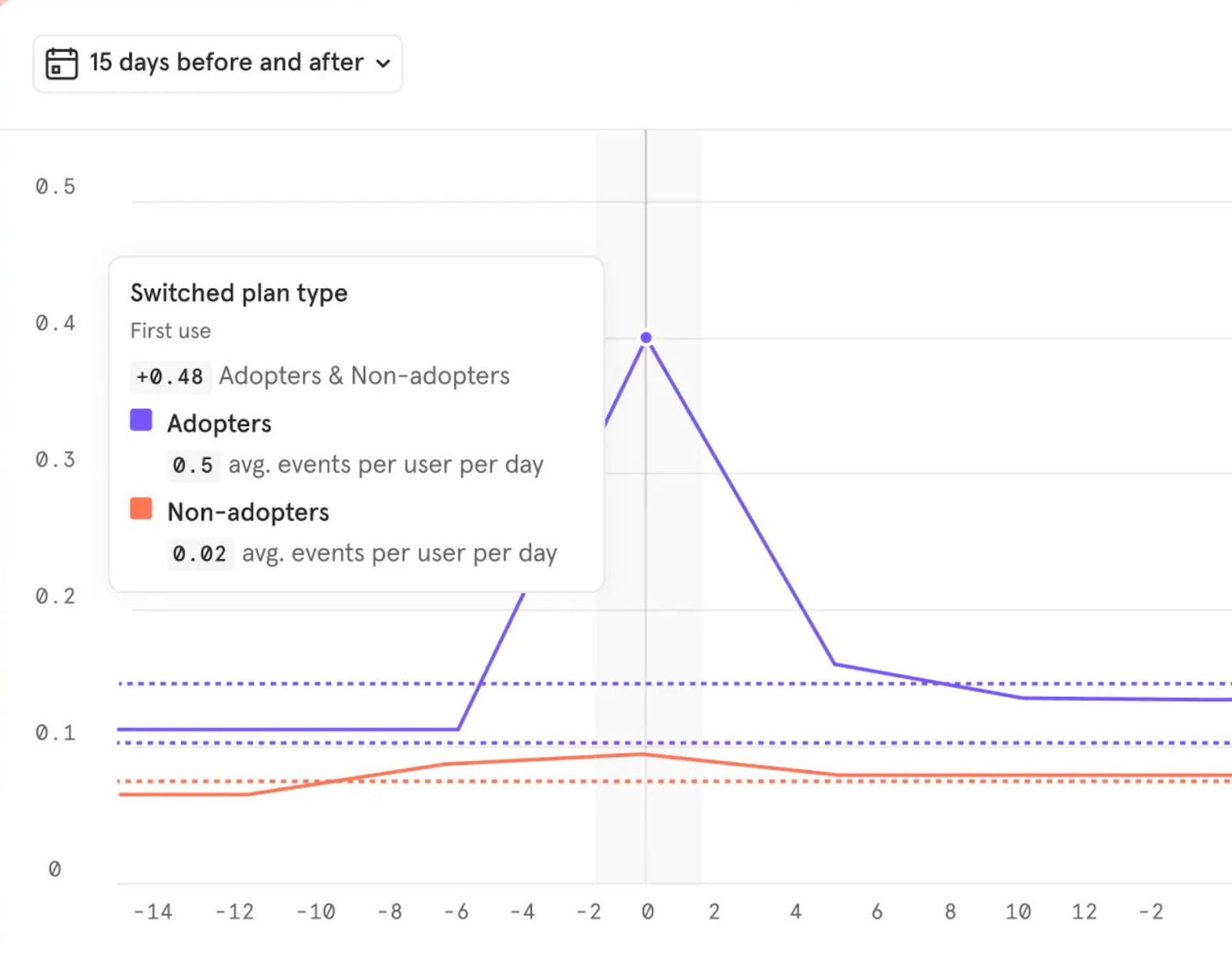
Mixpanel is perhaps the best website analytics tool at answering: “Do users who try X upgrade more?”
It is a behavioral analytics tool built for SaaS companies, especially those running product-led growth (PLG). Mixpanel excels at cohort analysis and retention. It provides deep insights into activation, retention, and upgrade behaviors.
What’s new in Mixpanel in 2025?
Mixpanel’s 2025 updates are all about making analytics smarter, faster, and easier to act on. With the new AI query tool (MCP), you can literally ask your data questions in plain English and even let other AI tools pull insights directly. On the experimentation side, features like Metric Trees and a reworked Experimentation Reporting help product teams see how engagement ladders up to business goals and ship with more confidence.
Mixpanel also expanded session replays to mobile and added heatmaps for web, bringing qualitative context into the same platform.
Mixpanel best-fit ICP: PLG startups and scale-ups focused on activation and retention
Mixpanel pricing
- Free: up to 1M events/month.
- Growth plan: Usage-based: $0.28 per 1k events beyond free
- Enterprise plan: custom plans for large volumes
Mixpanel Pros
- Deep behavioral analytics, real-time insights
- Powerful, customizable funnels and dashboards
- Identifies individual user journeys
- Generous free plan available
Mixpanel Cons
- Steep learning curve, complex implementation
- Requires manual event tracking
- Limited qualitative user understanding
- Not ideal for marketing attribution
🚀 Micro-Play: Identify first_value_action (the in-product event most correlated with upgrades) and design your revamp to surface it earlier.
🎯 KPI to track: D7/D30 retention and upgrade propensity by cohort.
8. Lucky Orange
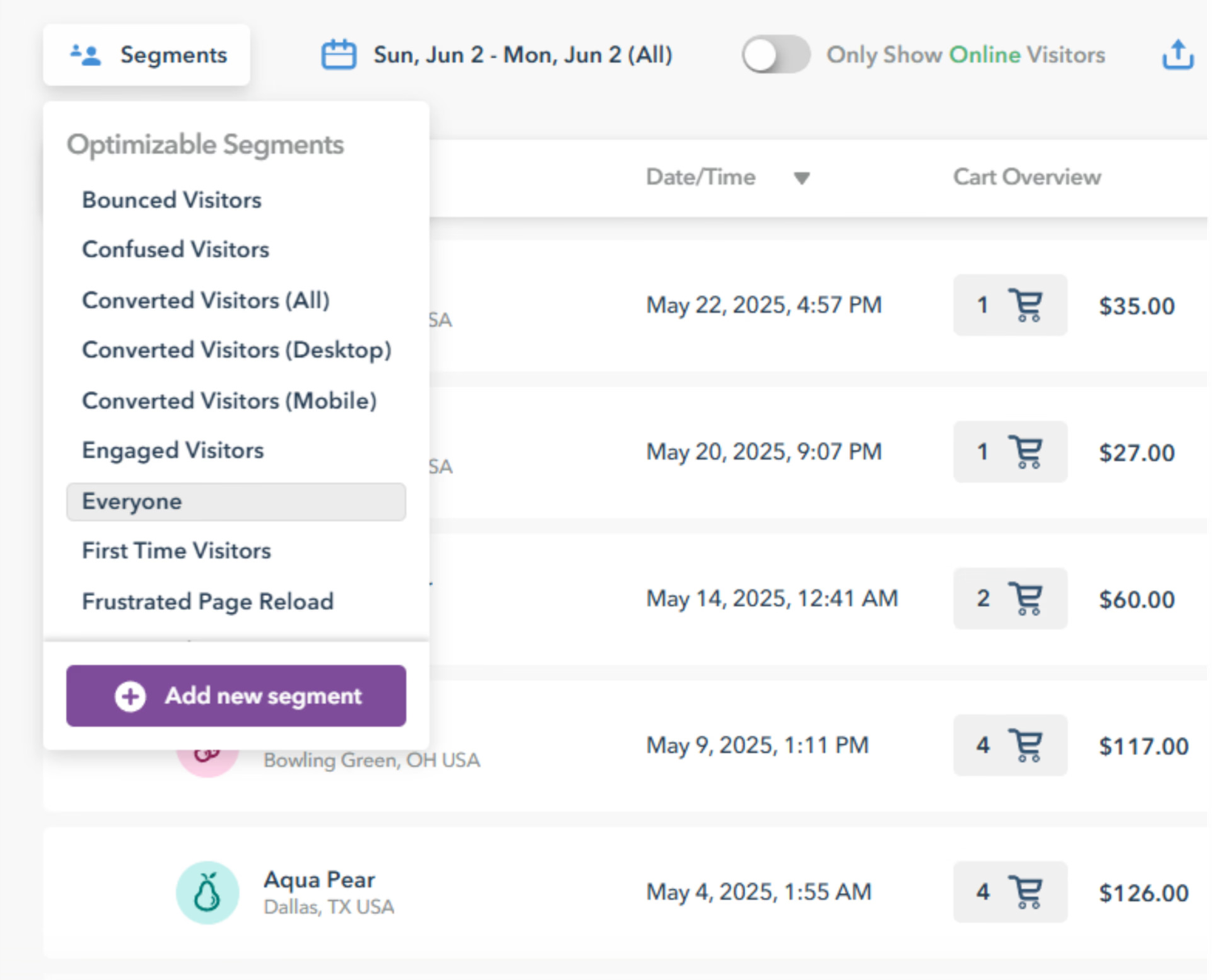
Lucky Orange is an all-in-one conversion optimization and behavioral website analytics platform. For SaaS teams revamping websites, it’s especially valuable because it blends diagnostics (heatmaps, replays) with engagement tools (chat, polls, surveys). It lets you both understand problems and intervene before users churn.
The business value is faster insights into funnel leaks, improved onboarding flow conversions, and the ability to recover trial users in real time.
What’s new in Lucky Orange in 2025?
The headline update for 2025 is Lucky Orange Discovery, an AI-powered tool launching in summer 2025. Discovery automatically scans your customer journey and highlights specific optimization opportunities (essentially surfacing “where you’re leaking conversions” in plain English). Instead of manually piecing together heatmaps and funnels, you get packaged insights that tell you what needs attention and why.
Lucky Orange Best-fit ICP: SaaS businesses needing combined UX analytics + live engagement.
Lucky Orange pricing
- Free plan (100 sessions/month)
- Build plan: $39/month
- Grow plan: $89/month
- Expand plan: $229/month
- Scale plan: $899/month
- Enterprise plan: Custom
Lucky Orange pros
- Combines analytics + engagement (chat, polls)
- Tight CRM integrations (HubSpot saves time)
- Affordable entry tiers
Lucky Orange cons
- Pricing rises quickly with scale
- The interface can feel busy for new users
💬 Micro-Play: Set up a funnel from Landing → Pricing → Signup. Add a live chat prompt on the pricing page for visitors who linger >30s.
🎯 KPI to track: Increase in demo requests or trial starts from high-intent visitors.
9. Matomo

Matomo is a privacy-first website analytics tool that combines all the essentials (funnels, cohorts, goal tracking, heatmaps, and session replays) with enterprise-grade governance. Unlike mainstream analytics tools, it gives you 100% data ownership (whether you host it yourself or use Matomo Cloud), so you always know where data lives and how it’s used.
What’s new in Matomo in 2025?
You can now enforce strong passwords, set custom token expiry, and receive alerts for inactive accounts. You can also monitor multiple sites more easily with the redesigned All Websites dashboard, which adds a cleaner layout and a Total Hits metric for quick traffic checks. And with new Tag Manager variables and smoother usability, you can track behavior more flexibly across your SaaS site.
Matomo Best-fit ICP: SaaS organizations where compliance and user trust are non-negotiable (EU-focused, enterprise, healthcare, finance, gov-tech)
Matomo pricing
- On-premise (self-hosted) plan: Free, open-source (you own the infrastructure)
- Cloud plan: Starts $23/month, scales with traffic volume
- Enterprise plan: Custom (adds SLAs, priority support, and compliance extras)
Matomo Pros
- 100% data ownership (you control where it’s stored)
- Fully GDPR/CCPA compliant, no data sampling
- Import GA4 data directly
- Unlimited websites, users, and segments
Matomo Cons
- UI is less polished than GA4 or Mixpanel
- Self-hosted requires ongoing maintenance
📊 Micro-Play: Import GA4 history into Matomo to maintain long-term reporting continuity. Then enable Consent Mode 2.0 to stay fully compliant while tracking funnel performance pre- vs. post-revamp.
🎯 KPI to track: Trial activation rates under fully compliant, unsampled data conditions.
10. Kissmetrics

If GA4 feels built for marketers, Kissmetrics feels built for SaaS. It’s designed specifically for tracking SaaS customer journeys (from first website visit to trial activation, and all the way through retention and upsell). Unlike general web analytics, Kissmetrics gives you people-level tracking. You can follow individual users across sessions and devices, so you don’t just see anonymous pageviews
The business value is better visibility into lifetime value (LTV), churn risk, and the trial-to-paid funnel (the metrics SaaS leaders actually care about).
What’s new in Kissmetrics in 2025?
In 2025, Kissmetrics added tighter CRM and billing integrations, making it easier to link product activity with revenue. You can build more precise cohort and churn reports, and the redesigned funnel reporting makes leaks obvious at a glance. New data pipeline options also let you sync behavioral data directly into warehouses for broader analytics stacks.
Kissmetrics Best-fit ICP: SaaS teams needing revenue-linked behavioral analytics
Kissmetrics pricing
- Bronze plan (up to 10000 monthly events): $25.99/month
- Silver plan (up to 2,000,000 monthly events): $299/month
- Enterprise pricing available for larger SaaS teams.
Kissmetrics Pros
- Strong, responsive customer support
- Excellent for tracking the full customer lifecycle
- Robust analytics with customizable reporting
Kissmetrics Cons
- Setup can be difficult without analytics expertise
- Steeper learning curve for advanced features
📈 Micro-Play: After your revamp, build a funnel: Trial Start → Onboarding Complete → Upgrade to Paid. Use cohort reports to compare pre-revamp vs post-revamp performance.
🎯 KPI to track: Upgrade rate of onboarded users vs non-onboarded users.
Free vs paid website analytics tools: when should you upgrade?
If you’re under $1M ARR, stick with the free stack: GA4, Clarity, GSC. You’ll be shocked at how far it gets you.
You should push to paid website analytics tools when:
- Volume limit: You are at ~50–100k monthly events (free tiers begin to sample or cap retention).
- Analysis needs: You need D90 retention cohorts, raw event exports, or multi-touch attribution.
- Experiment scale: You are running multiple concurrent valid experiments or server-side flags.
💡 ROI Rule: If a paid tool’s expected lift in conversion pays for the annual subscription (e.g., a 1–2% lift in trial-to-paid at $3M ARR), upgrade.
Also read: SaaS Website Design That Converts: 7 Must-Have Elements to Win More Signups
Case in point: How ThunderClap revamped ConsultAdd’s website with analytics
ConsultAdd, a fast-growing HR consultancy, partnered with ThunderClap for a website revamp aimed at improving engagement and lead generation. We began with a 3-month analytics and UX audit. The data told a clear story:
- Traffic: ~7.6k visitors in 3 months
- Engagement: homepage average of just 12s
- Conversions: highest from direct traffic, but organic visitors stayed longer
- Forms: “Contact Us” dominated submissions, but CTAs were fragmented across four different touchpoints
- Pages: several sections had fewer than five visits in three months
From these insights, we recommended and implemented key changes:
- Consolidated four contact options into clear, ICP-specific forms
- Rebuilt messaging pillars to speak directly to employers (the primary ICP)
- Redesigned page flows for consistency and purpose, eliminating low-value sections
- Improved homepage trust signals and mobile UX
Here’s a before and after of their home page:
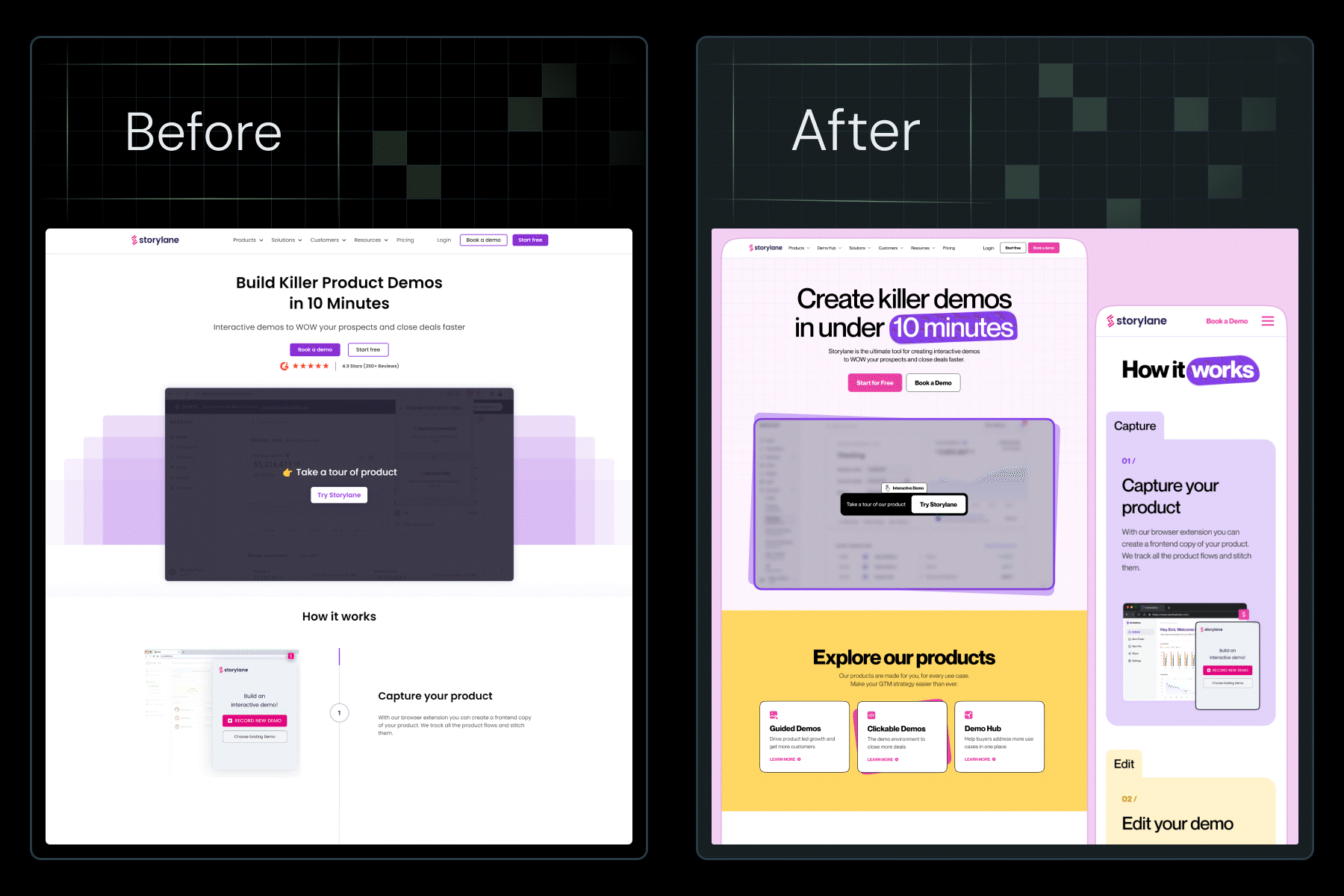
{{specficService}}
The impact: average engagement time rose 500% and form submissions increased by ~60%, giving ConsultAdd a significantly stronger inbound pipeline.
“The most important metric was the 60% increase in conversion. Once we realigned the site around the right ICP and streamlined the experience, analytics insights translated directly into business results.” - Kiran Kulkarni, Partner & Head of Growth at ThunderClap
Turn website analytics into a growth engine with ThunderClap
Using the top website analytics tools isn’t about number crunching and dashboards (it’s about making decisions). The right stack helps you spot where users hesitate, why conversions leak, and how to design pages that speak directly to your ICP.
That’s how we’ve helped brands like Amazon, Razorpay, and Storylane through 129+ B2B website revamps: turning raw data into consistent lifts in engagement and conversions.
Here’s a quick-start checklist for SaaS teams
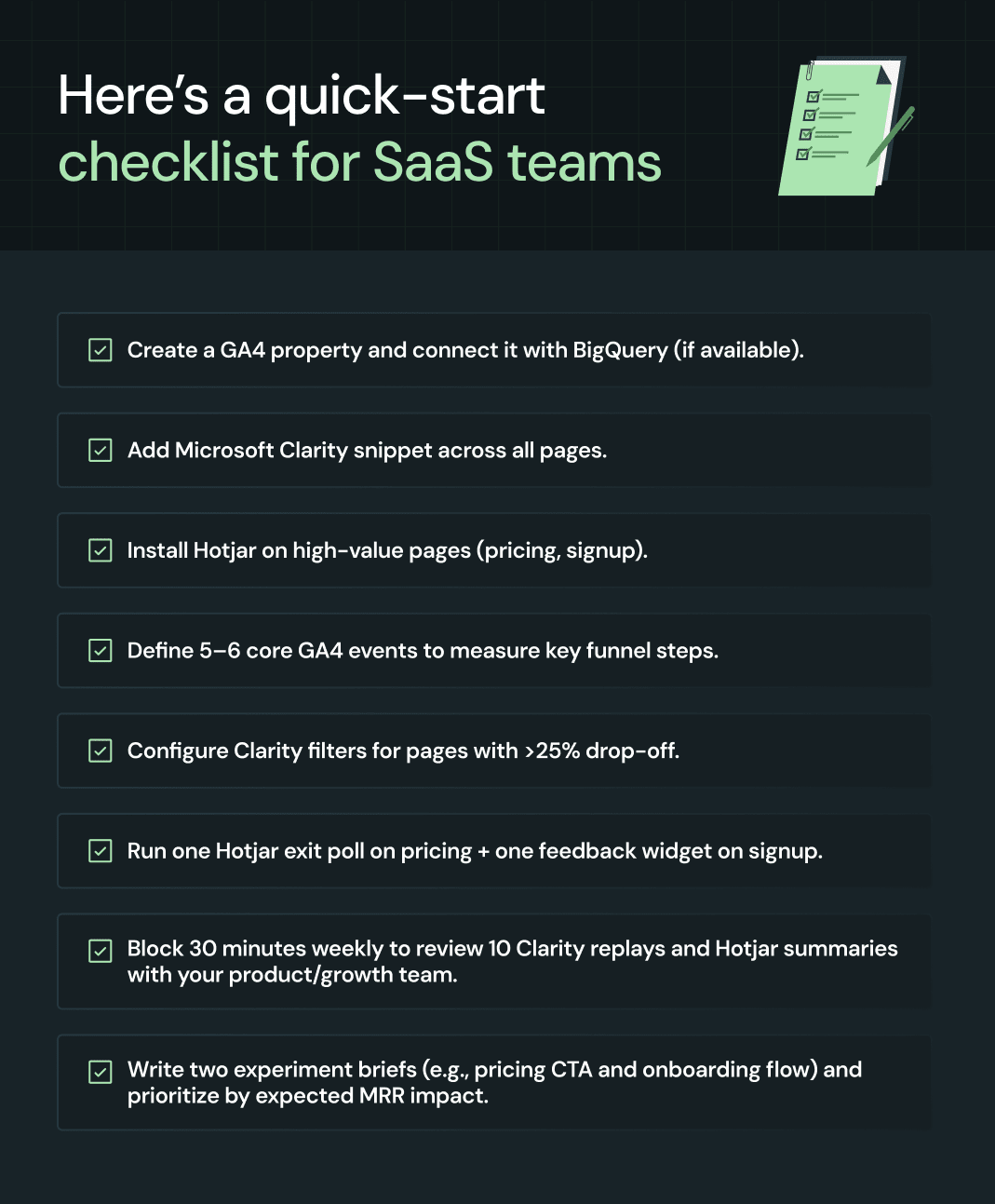
Even this lean stack will uncover friction points, surface ICP-specific insights, and kickstart meaningful experiments. But scaling analytics into a growth engine takes more than DIY. That’s where ThunderClap comes in. We bring the frameworks, CRO playbooks, and design + dev execution to translate analytics into measurable revenue outcomes.
Book a 30-minute consultation with us. We’ll map your current setup, pinpoint funnel leaks, and design a 90-day roadmap that shows exactly how to fix them.
FAQs
1. What are website analytics tools?
Website analytics tools are platforms that track and analyze how users interact with your site — from traffic sources and page views to funnels, heatmaps, and conversions. The top website analytics tools go beyond vanity metrics, giving SaaS teams insights into user behavior, ICP journeys, and where conversion leaks happen.
2. How do website analytics tools help improve conversion rates?
The best website analytics tools show you exactly where users drop off and why. For example, heatmap tools reveal where visitors get stuck, while product analytics platforms highlight which actions lead to upgrades. By combining quantitative tracking (GA4, Mixpanel) with qualitative insights (Hotjar, Clarity), SaaS teams can run targeted experiments, remove friction, and improve trial-to-paid funnels.
3. What features should you look for in a website analytics tool?
When choosing the top website analytics tools, look for three layers of functionality:
- Quantitative tracking → funnels, retention, event-based data (GA4, Mixpanel).
- Behavioral insights → replays, heatmaps, surveys (Hotjar, Microsoft Clarity).
- Experimentation features → A/B testing, personalization, ROI tracking (VWO, Optimizely).
- Other must-haves include integrations with your stack (CRMs, data warehouses, ad platforms), and privacy compliance.
4. What types of SaaS website analytics tools are available?
There are multiple types of SaaS website analytics tools, including:
- Product analytics (e.g., Mixpanel, Heap) to track feature usage and retention.
- User behavior analytics (e.g., Hotjar, Microsoft Clarity) for heatmaps and session replays.
- Web analytics (e.g., Google Analytics 4) for traffic and acquisition insights.
- Financial and revenue analytics (e.g., ProfitWell) for subscription metrics.
- Customer journey and engagement tools that combine data from multiple sources.
5. When should I upgrade from free to paid website analytics tools?
Typically, SaaS companies move from free to paid analytics plans when their data volume exceeds session/event limits of free tiers (often 50K-100K monthly events), or when they require advanced features like cohort analysis, retention tracking, real-time insights, deeply integrated marketing analytics, and regulatory compliance support.
6. How to ensure privacy compliance with website analytics tools?
SaaS companies adopt privacy-first analytics tools, implementing features like cookie consent banners, anonymized IP tracking, minimal PII collection, and GDPR/CCPA-compliant consent modes. Vendor management includes reviewing Data Processing Agreements (DPAs) and data residency options to meet evolving global privacy laws.
7. What are the best practices for integrating SaaS analytics tools?
Best practices include using data pipelines for raw data export (like GA4 to BigQuery), integrating customer data platforms (CDPs) such as Segment with product analytics tools (Mixpanel), combining behavioral tools (Clarity + Hotjar) for UX insights, and maintaining data governance with version control, incremental updates, and automated error monitoring to ensure data quality and timeliness.
8. What is the best free website analytics tool in 2025?
If you’re just starting out, Google Analytics 4 (GA4) and Microsoft Clarity together cover most needs. GA4 gives you quantitative funnels, while Clarity shows you unlimited session replays. For SEO insights, add Google Search Console (GSC). That free trio is enough to run a serious SaaS revamp under $1M ARR.


Interested in seeing what we can do for your website?














